
Title: Texas Flowers in Natural Colors
Author: Eula Whitehouse
Release date: December 2, 2016 [eBook #53647]
Most recently updated: October 23, 2024
Language: English
Credits: Produced by Stephen Hutcheson, Dave Morgan and the Online
Distributed Proofreading Team at http://www.pgdp.net

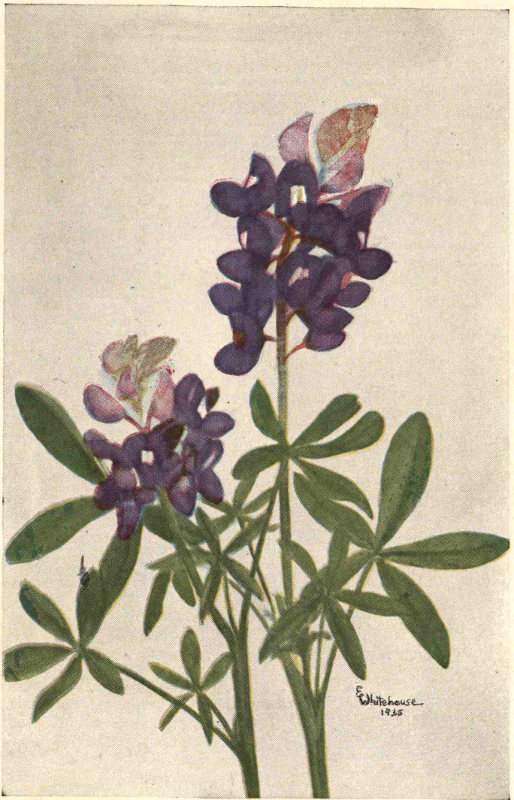
TEXAS BLUEBONNET
THE STATE FLOWER
BY
EULA WHITEHOUSE
Illustrations by the Author
Published by
EULA WHITEHOUSE
Dallas, Texas
Copyright 1936 and 1948, by
Eula Whitehouse
Box 739, Southern Methodist University
Dallas 5, Texas
Printed and bound in the United States of America
First Edition 1936
Second Edition 1948
From the pine woods to the prairies,
From the Panhandle to the sea,
You’ll find the Texas wildflowers
In marvelous carpetry.
Such magic tints of colors,
Pale pinks and dainty blues,
No artist’s palette can match them
In all their radiant hues.
The Texas sun has kissed them;
To Heaven they lift their eyes;
Beauty and Peace it brings them,
And Freedom under Texas skies.
—Gertrude Whitehouse
For more than a century the wild flowers of Texas have been a source of study and pleasure to scientists and flower lovers. The state can boast of a varied and interesting flora which has attracted numerous plant collectors since the first specimens were collected in the Texas Panhandle by Dr. Edwin James, naturalist accompanying the Long Expedition in 1820. Dr. Louis Berlandier, a French botanist, endured the hardships of the Teran Expedition for the exploration of the boundary region between Texas and Mexico between 1826 and 1834 in order to collect plants in Texas.
Berlandier’s first collection was instrumental, a few years later, in arousing the interest of Thomas Drummond, a Scotch botanist and collector. In 1833-34 Drummond visited Southeast Texas and collected 700 species of plants. In 1836, Ferdinand Lindheimer, a German botanist, moved to Texas and began his noteworthy study and collection of Texas plants. Charles Wright, a Yale graduate, came to Texas in 1837, first collecting plants in East Texas and later making important additions in Southwest Texas. Since the work of these early pioneers, many scientists have visited nearly all parts of the state and have added many new names to the list of native plants.
Today nearly five thousand species of flowering plants have been reported from the state. About half of these have showy, conspicuous flowers, and many of them are very limited in their distribution in Texas. If the reader will keep these figures in mind, perhaps he will not be disappointed at not finding some of his favorite flowers in the following pages. As such a limited number could be included, it was thought best to use those widely distributed throughout the state, omitting some of the well-known plants which have been frequently illustrated in previous publications.
The present manual is not intended as a guide to the flora of the state, but it is hoped that it will prove helpful in identifying some of the common flowers. A few rare and beautiful flowers have been included so that they may be recognized and protected. In order to include representatives of the more important plant families, it was impossible because of lack of space to add many widely distributed members of other families represented. For example, the pea family, which has about 300 showy members in Texas, had to be limited to ten representatives.
The water color paintings on which the manual is based were viii made by the author. In nearly all cases they were made from fresh specimens carefully checked with verified material in the University of Texas Herbarium; a few which could not be painted at the time of collecting were later drawn from pressed specimens and colored from notes and memory.
The flowers of Texas have been so very abundant that only recently has it been considered necessary to protect them. The Legislature of 1933 passed a law forbidding the picking of flowers and injury to trees and shrubs along highways. Even this protection is not sufficient for some plants. A few years ago the writer happened to visit the shop of a cactus fancier just after he had returned from a collecting trip and saw with amazement the large tow-sacks filled with rare and highly prized cacti. Wagon loads of the large and vivid-blooming ribbed cacti have been observed as they were brought in for market. The bluebell, or purple gentian, is in need of protection since florists have been buying them up in such large quantities. The picturesque bunches of sotol are being rapidly destroyed, as ranchmen are stripping them of their saw-toothed leaves and feeding the stalks to their cattle. Yaupon and American holly, both slow-growing plants, are being destroyed to supply the market with Christmas greens.
A few flower sanctuaries have been established in recent years, but many others are needed. The decrease in our native flowers is primarily due to increase in population with the accompanying increases in homesteads and acres in cultivation, over-grazing, and improved facilities of travel. The limestone hill region was formerly a flower paradise but has been so heavily over-grazed by sheep in recent years that now the only flowers to be found are the unattractive rabbit-tobacco, horehound, and queen’s delight, or goatweed, so called because sheep and goats will not eat it.
Grateful acknowledgment is made to the many friends who have assisted me in the preparation of this volume. I deeply regret that it has been necessary to increase the list price of this edition. The first edition of three thousand copies did not pay for the cost of publication. That deficit, added to the increased costs of printing and paper, have made an increase imperative.
September 1, 1948 Eula Whitehouse
For more detailed descriptions, description of other plants, flower uses, and flower legends and history, the following books will prove helpful:
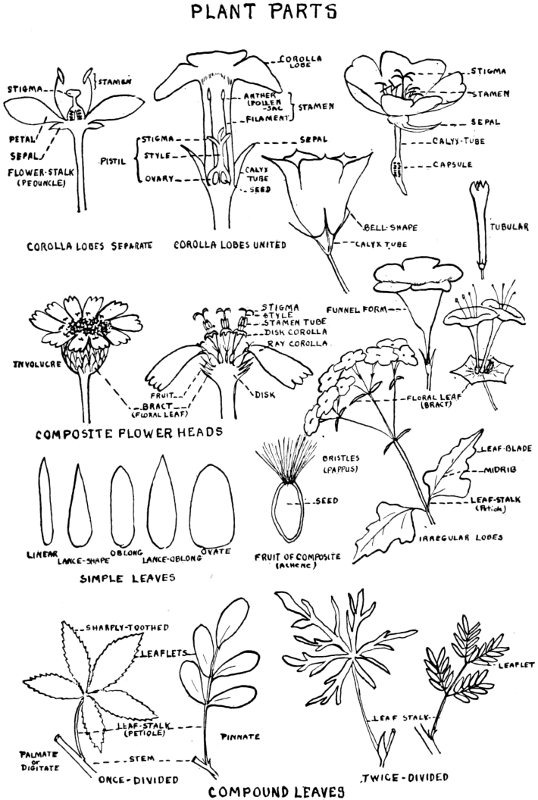
PLANT PARTS
The diagram on the opposite page carries illustrations of most of the terms used in the following descriptions of plants. As it was intended that this manual should serve as a means of plant identification from illustrations, the descriptions have been made very brief. If the reader is interested in a more detailed description, technical books should be consulted. Some botanical terms are rather loosely used in the effort to avoid technical expressions; for example, the fruit of a daisy flower is known popularly as a seed but is an achene, a seed closely covered by the wall of the ovary.
The conspicuous parts of the flower commonly make up the corolla, each part being known as a petal; however, in some flowers the showy part is actually the calyx, as the outer whorl of parts around the stamens and pistil is always called. The divisions of the calyx are known as sepals. The stamens are made up of two parts—the anthers or small sacs which bear the pollen grains, a necessary part to fertilization, and the filaments or stalks which elevate the anthers so that the pollen grains can be scattered. The ovules which develop into seeds after fertilization are borne in the ovary, a part of the pistil. The pollen is deposited on the stigma and carried down the style to the ovule. Showy flower parts, nectar, and other devices attract insect visitors which aid in the transfer of pollen from one flower to another.
In order that botanists everywhere may make use of plant names and descriptions, these are written in Latin. The Latin name of the bluebonnet is Lupinus texensis, in which texensis represents the name of a species and Lupinus is the name of a genus, which is a group of closely related species. The plants making up the different species in a genus are usually so much alike in flower, fruit, and leaf characters that they can be recognized as belonging to the same group. Similar genera (plural of genus) are grouped together in families; the family name in Latin takes the ending -aceae. Thus while this book illustrates only 257 Texas plants, it is hoped that the reader will become familiar with many others which bear a close relationship.
Much effort has been expended to use scientific terminology in accordance with that preferred by experts on various plant groups, but continuing research changes many well known names. In this list the name used in the text is followed by the name now in good usage; the terms are not always synonymous. The authorities for the names are not given but can be checked in technical publications.
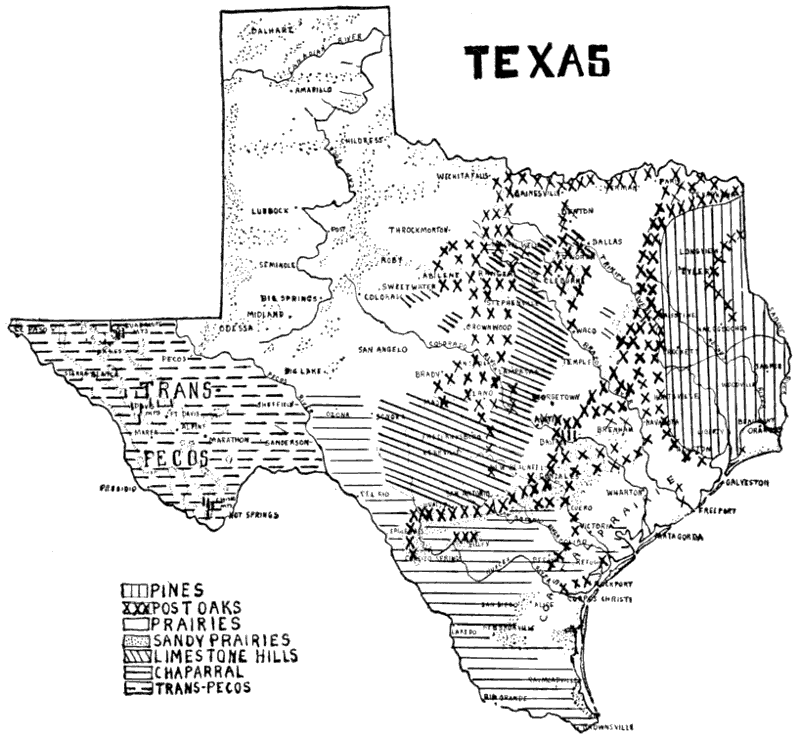
The above map[1] gives the larger natural areas of the state. The prairie regions afford the most profuse display of wild flowers. In the wooded area of East Texas, the shortleaf pine is abundant in the northern part, the loblolly in the southwestern part, and the longleaf pine in the southeastern part of the area, while hardwoods are found in the river bottoms. The chief trees in the post oak strip are post oak and black jack oak. Among the mountain cedars, live oaks and Spanish oaks, so common in the limestone hill region, may be found scattered trees and shrubs of the chaparral. The chaparral region is often broken by prairies but in some places is densely covered with shrubs and small trees which are usually thorny. The mesquite is abundant in this region and is more or less scattered throughout the prairie regions.
Author’s Note: The family characteristics are placed immediately below the illustrations at the beginning of each family group and set in smaller type to distinguish them from the individual group descriptions.
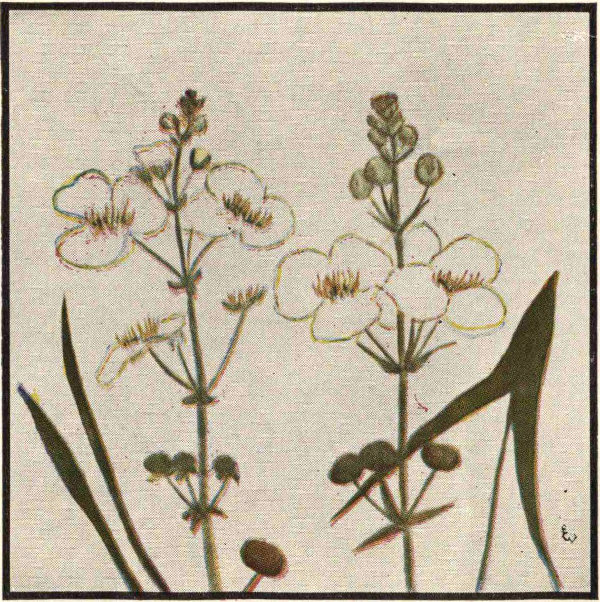
SMALL ARROWHEAD LONG-LOBED ARROWHEAD
Marsh or water plants; leaves mostly basal; sepals 3; petals 3, white or pink, tender; stamens 6 or more; pistils many, free; fruit a head of achenes.
Small Arrowhead (Sagittaria papillosa) is a common pond dweller in Texas and Louisiana. Like other arrowheads the flowers are borne in whorls, the upper having many stamens and the lower producing the seeds. It may be distinguished from other narrow-leaved forms by the rough (papillose) surface of the floral leaves.
Plains or Long-Lobed Arrowhead (Sagittaria longiloba) is common in shallow water on the plains from Nebraska to Mexico from April to October. The shape of the leaf of this and other species has given the common names of arrowhead and arrowleaf to this group. Like the water-plantain and bur-head the flowers have 3 tender white petals. The wapato duck potato (S. latifolia) may be found in East Texas. Growing in great abundance along the coast, the water potato or scythe-fruited arrowhead (S. falcata) is a showy plant 2-4 feet high with large lance-shaped leaves. The tubers and young shoots of both of these are considered excellent foods for ducks. Indians also valued the starchy tubers for food, and it was the duty of the women to grub in the mud for them.
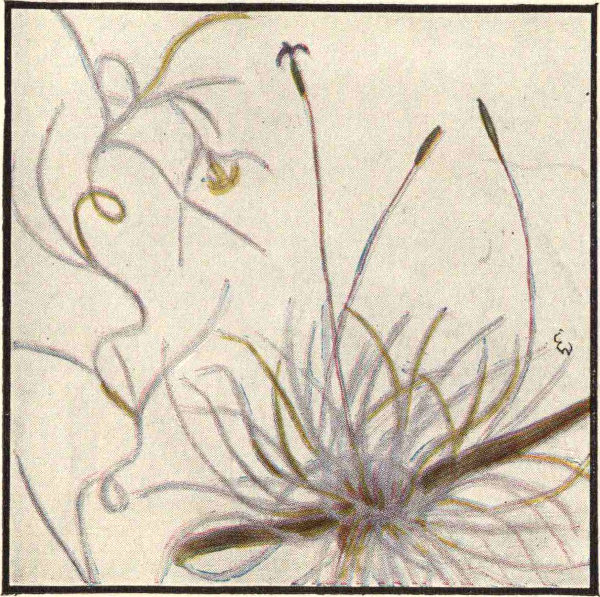
SPANISH MOSS BALL MOSS
Chiefly air-plants, some rigid-leaved land plants; floral leaves often conspicuous; 3 sepals; 3 petals; stamens 3-6; pistil 3-celled.
Spanish Moss (Dendropogon usneoides) has long zig-zag stems hanging in gray masses from the branches of many trees, especially live oaks, from the Coastal Plain of the United States to South America. Sometimes called Florida-moss, wool crape, crape-moss, and long moss, it has long been renowned in literature and industry. Indians and pioneers found many uses for it, and it is still used for padding, fodder for cattle, decoration, and the making of mattresses. The short leaves are scattered on the slender stem, which may be 1-6 yards long. The fragrant flowers are small and inconspicuous, being about ¼ inch long, blooming in early summer. The name means “tree-beard.”
Ball Moss. Bunch Moss (Tillandsia recurvata) has small and inconspicuous purple flowers which appear in the summer. Like the Spanish moss, it gets its nourishment from the air but may injure trees by crowding out the leaves. Both mosses bear no relation to the true mosses but belong to the same family as the pineapple. The ball moss is found on trees, wires, rocks, and other places. Bailey’s bunch moss is a large-flowered form growing in the lower Rio Grande Valley.
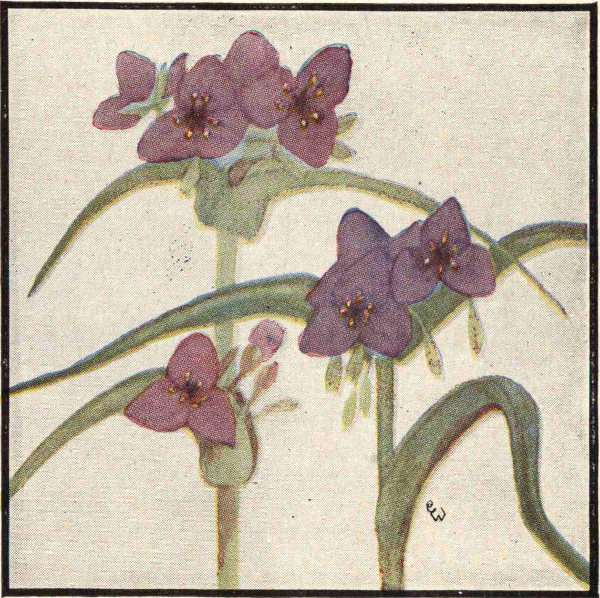
GIANT SPIDERWORT PRAIRIE SPIDERWORT
Mostly succulent herbs with tuberous or fibrous roots; flowers arising from a cluster of leaf-like bracts; sepals 3; petals 3; stamens 6; ovary 3-celled; fruit capsular.
Giant Spiderwort (Tradescantia gigantea) grows in clumps of stout stems 2-3 feet high. The numerous flowers on short slender stalks hang out of a cluster of 2-3 upper leaves which have sac-like bases, velvety with soft hairs. The 3-petaled flowers vary in color from purplish-blue to rose or white and close at noon. The 6 stamens are adorned with lovely violet hairs. It is found in Central Texas in April and May.
The spiderwort group was named for Tradescant, gardener to Charles I. It is well represented in Texas, all of the many different species being easy to transplant and making attractive garden plants. The wandering jew, a well-known spiderwort in cultivation, is a native of South America.
Prairie Spiderwort (T. bracteata) is a smaller plant with bluer flowers. Ranging from Minnesota to Texas, it has its blooming season in Texas in April and May.
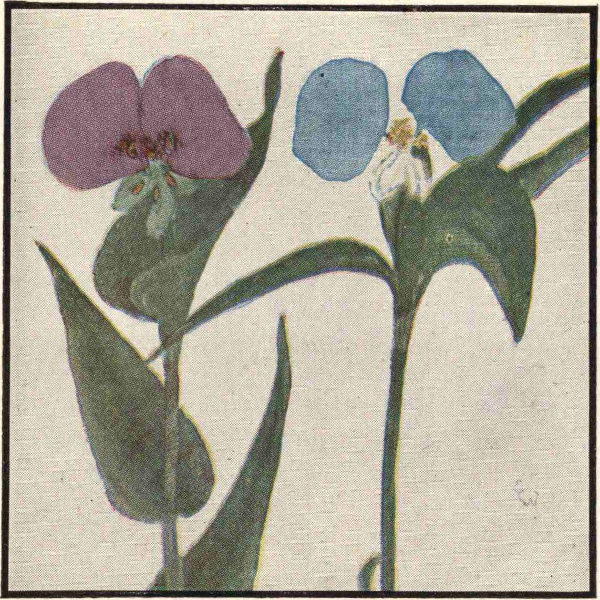
TEXAS DAYFLOWER WIDOW’S TEARS
Curly-Leaved Dayflower. Widow’s Tears (Commelina crispa) has two large blue petals and a third, minute, white, and inconspicuous. The upper three stamens are 4-lobed and sterile, quite different from the 3 lower pollen-producing stamens, one of which is larger than the others. The petals are very tender and last only one morning. This dayflower may be distinguished from several others in the state by its crisped leaf-margins. It is very common on the South Central Plains from May to September. The name is given in honor of early Dutch botanists by the name of Commelyn.
Texas Dayflower (Commelinantia anomala) has two large petals like the dayflowers, but may be distinguished from them by their lavender color and by having the leaf around the flower-cluster more like the lower leaves in shape. The three upper stamens are bearded with violet hairs like those of spiderworts. It grows in rich moist soil in the limestone hills of the southern part of the state and the adjoining part of Mexico.
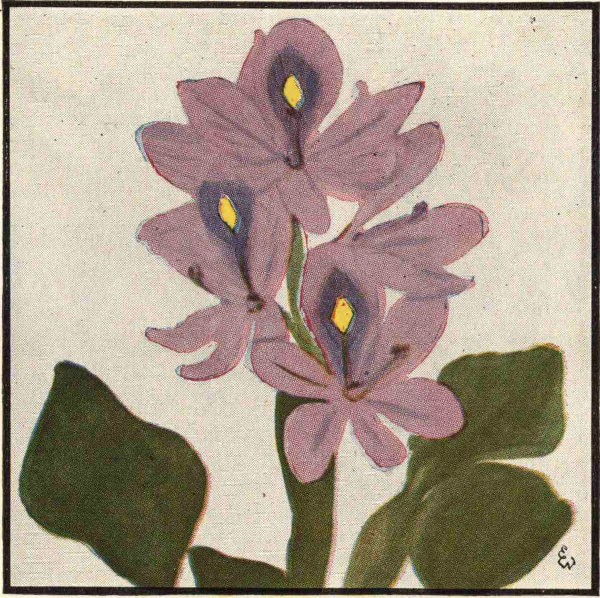
WATER HYACINTH
Aquatic plants; leaves alternate, often basal; sepals 3, petal-like; petals 3, sepals and petals partly united; ovary 3-celled.
Water Hyacinth (Eichhornia crassipes) is also called wampee, river raft, and water orchid. It grows so thick in places that water channels may be blocked, and island-like masses may serve as rafts. With its large spikes of lavender flowers and its broad shining leaves with their curious bulbous floats, it is the queen of our water plants. Many streams, lakes, and canals along the coastal highway offer living pictures which will not soon fade from the memory. The plants float by means of the bulbous enlargement of the leaf stalk. The flowers are somewhat 2-lipped, the 3 sepals and 3 petals somewhat alike but with a yellow spot on the upper petal.
Pickerel Weed (Pontedaria cordata) may be found growing in the mud of inland waters along the coast. It is a taller plant than the water hyacinth, the spikes are narrower, the flowers are a deeper purple, and the leaves are narrower and have no float.
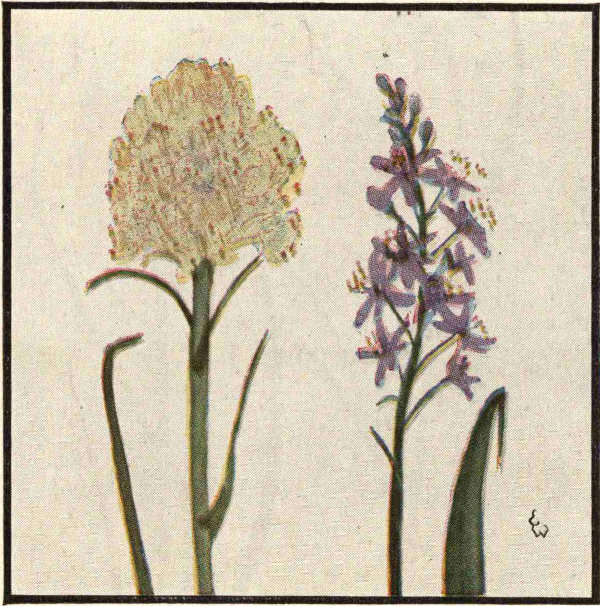
NUTTALL’S DEATH CAMASS WILD HYACINTH
Aquatic plants; leaves alternate, often basal; sepals 3, petal-like; petals 3, sepals and petals partly united; ovary 3-celled.
Nuttall’s Death Camass (Toxicoscordion nuttallii) is a common prairie bunch-flower from Texas to Tennessee and Kansas. The leaves, which are mainly basal, long, narrow, and curved, and the stout stems 1-2 feet high arise from a large black-coated bulb which is poisonous. Many cream-colored flowers are borne in a round-topped cluster. The 3 sepals and 3 petals are alike, and the 6 stamens have large yellow anthers. The 3-beaked capsules have numerous seeds. The flowers bloom in April and May. The poisonous bulb is responsible for the name, which is derived from the Greek meaning “poison-onion.”
Wild Hyacinth (Quamasia hyacinthina) is also called indigo-squill or meadow hyacinth. Growing from a deep-rooted edible bulb, a slender stalk 1-2 ft. high bears a spike-like cluster of hyacinth-blue flowers at the top. The flowers are about ½ inch broad and have a most delightful fragrance. It is widespread from Pennsylvania to Texas, common in Texas along railroads in April.
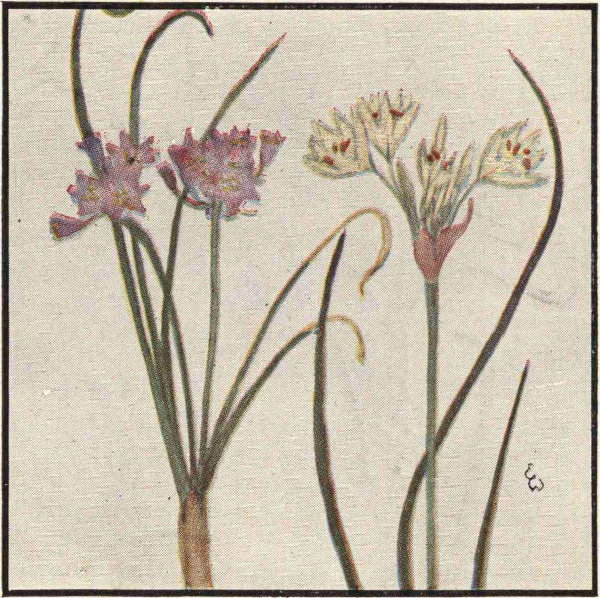
PRAIRIE ONION CROW POISON
Prairie Onion (Allium nuttallii) has short flower stalks 4-6 inches high growing from a very small bulb which has a brown, finely-woven outer coat. The flowers are nearly half an inch broad and vary from pale pink to a deep rose. Allium is the Latin for “garlic,” and both the cultivated garlic and onion are members of this group. There are nearly twenty different wild onions in the state, many of which make lovely garden plants. Allium mutabile, a taller onion with very numerous white flowers, blooms in May. The prairie onion is the same as Heller’s onion (Allium helleri) and blooms in April.
Crow Poison. False Garlic (Nothoscordum bivalve) is one of the first flowers to appear in the spring on lawns, meadows, and roadsides throughout the Southern States and may bloom again in the autumn. It looks very much like the onions, but has fewer, larger flowers on long stalks and does not have the onion odor. It grows from an onion-like bulb. The name is from the Greek meaning “false garlic.”
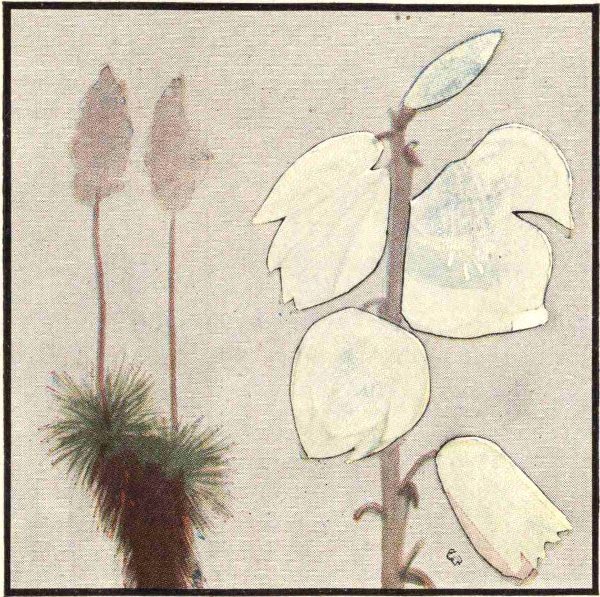
FINE-LEAVED TREE-YUCCA SOAPWEED
Beargrass. Fine-Leaved Tree-Yucca (Yucca elata) belongs to a group widely represented in Texas by many different forms, those with thin thready leaves being known as beargrass, soapweed, “palmillo,” and Adam’s needle and those with thick, stiff, sharp-pointed leaves as Spanish bayonet or dagger. All have creamy or greenish-white bell-shaped drooping flowers borne in dense clusters on a long stalk growing out of a rosette of leaves. The fine-leaved tree-yucca sometimes grows 20 ft. high and is very abundant west of the Pecos River to Arizona. The budding flower stalk is quite tender and palatable and was often used as a food by early settlers. It is an excellent food for cattle, and they keep the stalks stripped of budding shoots, making the absence of seed pods quite conspicuous on the cattle ranges. Indians used the leaf fibers for making sandals.
Soapweed (Yucca glauca), the common yucca of the Panhandle of Texas and adjacent states, has an unbranched flower stalk. As in other yuccas, the roots yield soap when the bark is removed and crushed in water. The fruits of the stiff-leaved tree-yuccas are edible.
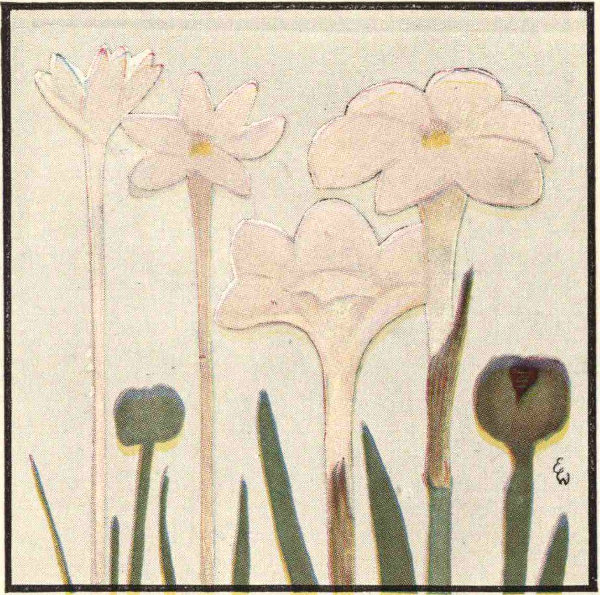
SMALL RAIN LILY GIANT RAIN LILY
Plants with bulbs or fibrous roots; leaves basal; sepals 3, petal-like; petals 3, sepals and petals united into a tube below; stamens 6; ovary inferior, 3-celled.
Small or Drummond’s Rain Lily (Cooperia drummondii) is known in cultivation as evening star. It does not have a stalked seed pod like the giant rain lily and has smaller flowers with much longer tube and shorter and narrower leaves. It blooms in the late summer and fall.
The cooperias were named in honor of Joseph Cooper, an English gardener. Drummond’s rain lily honors Thomas Drummond, a Scottish plant collector who visited the southeastern part of Texas in 1833-34.
Giant Rain Lily (Cooperia pedunculata) has lovely fragrant white flowers which last only a day or two. The tubular flowers appear funnel-shaped for some hours after opening, but the six broad lobes spread widely as the flowers mature. The leaves are all basal and grow from a large black-coated bulb; they are about a foot long and nearly half an inch wide. Shortly after heavy rains in spring and early summer, lawns, meadows, and woods in Louisiana, Texas, and Mexico are covered with the lovely blossoms. It is also called prairie lily, field lily, crow poison, and fairy lily.
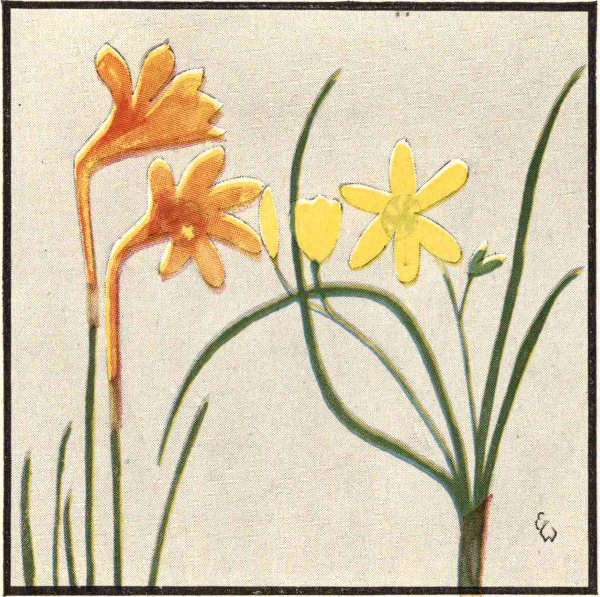
COPPER LILY YELLOW STAR GRASS
Copper Lily. Texas Atamosco Lily. Stagger Grass (Zephyranthes texana) is a copper-colored lily blooming in August and September in Central Texas. The inner surface of the petals is yellow and shows a purple veining. The flowers stalks are 6-12 inches long, growing from a cluster of very slender leaves. The yellow atamosco (Zephyranthes longifolia) has yellow flowers. It may be found in West Texas to Arizona and Mexico in the late summer and fall.
Yellow Star Grass (Hypoxis erecta) has yellow flowers about an inch broad. It is one of the earliest and commonest spring flowers in the eastern pine woods, blooming in Texas in March and April.
The common century plant of the Big Bend is Agave havardiana. It is not as large as the widely cultivated American century plant introduced from Mexico. A candelabrum-like cluster of yellow flowers, which are provided with a vast quantity of nectar, grows at the top of a stout stalk, which is commonly 12-15 feet high. The stalk grows from a cluster of broad gray leaves, 1-1½ feet long, bordered with recurved prickles and ending in a sharp-pointed spine. Lecheguilla (Agave lecheguilla) is a much smaller plant with narrow spikes of greenish-white flowers.
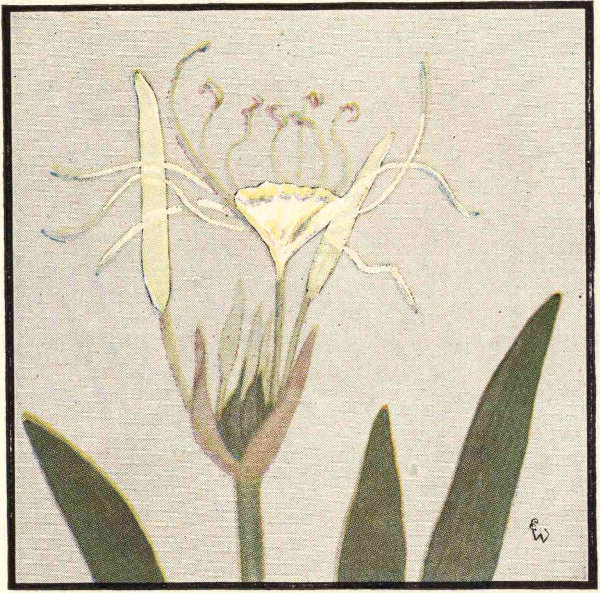
TEXAS SPIDER LILY
Texas Spider Lily (Hymenocallis galvestonensis) grows in moist soil, in ditches, or on the edges of ponds. It is particularly abundant on the coastal prairie. A thick, fleshy flower stalk grows from a cluster of strap-shaped leaves about an inch broad and bears 4—6 white flowers in a cluster at the top of the stalk. The scientific name means “beautiful membrane” and refers to the delicate white funnel-tube uniting the bases of the 6 stamens. The 3 linear petals and the three similar sepals are about 6 in. long, united at their lower half into a slender tube. The upper half spreads, giving rise to the common name of spider lily. The flowers bloom from March to May. It was long ago introduced into cultivation and is considered quite hardy in the North.
Western Spider Lily (Hymenocallis occidentalis) has similar flowers, but blooms in the summer after the leaves die back. It is found in moist soil and on shaded hillsides from Northeast Texas to Indiana and Georgia.
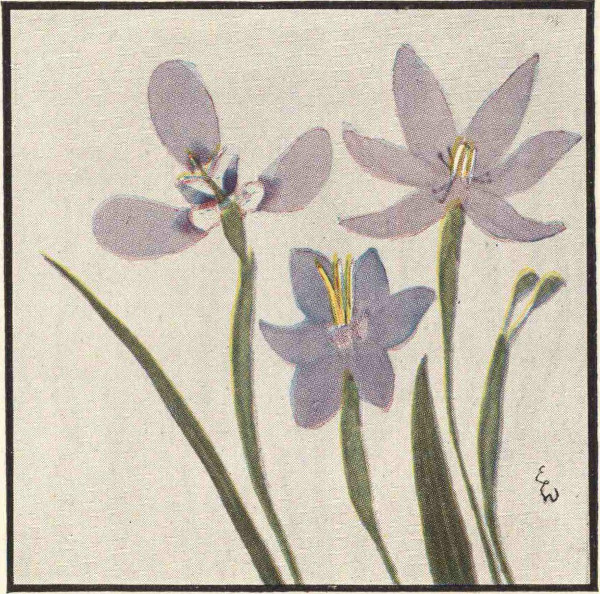
PLEATED-LEAF IRIS PRAIRIE CELESTIAL WOODLAND CELESTIAL
Perennial herbs with bulbs, corms, or rhizomes; leaves usually basal and flattened at the sides; 3 sepals and 3 petals nearly equal; stamens 3; ovary below the perianth; fruit a 3-celled capsule.
Pleated-Leaf Iris (Herbertia caerulea) has pleated leaves like the celestials, but the flowers are quite different, the 3 sky-blue sepals being large and spreading and the 3 petals small and inconspicuous. The bases are white with violet markings. It is very abundant on the Coastal Plain of Louisiana and Texas in April and May. The name is in honor of William Herbert, a distinguished English botanist.
Prairie Celestial (Nemastylis acuta) has 6-parted sky-blue flowers with the 3 sepals and 3 petals nearly equal, white at the base. The 2-branched thread-like styles, from which the name is derived, spread horizontally between the 3 erect stamens. It grows on the prairies of North Texas to Kansas and Tennessee.
Woodland Celestial (Nemastylis texana) with its steel-blue flowers is more abundant in the southern part of the state in open post oak woods. Like the pleated-leaf iris, the flowers of the celestials open late in the morning and remain open only a few hours.
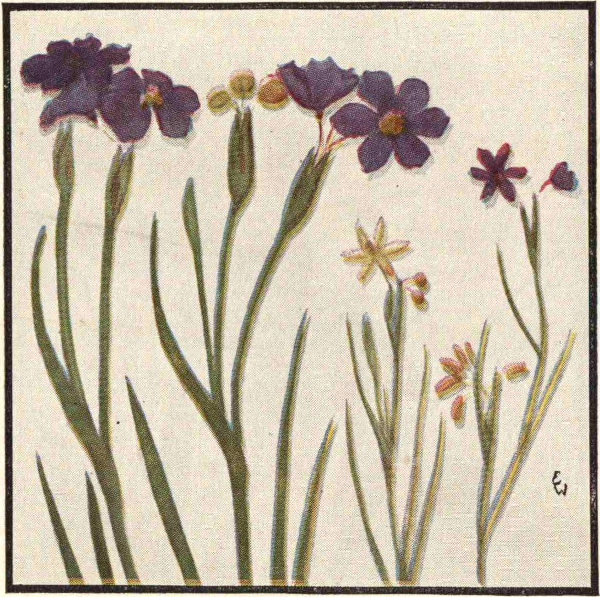
BLUE-EYED GRASSES
SWORD-LEAVED THUROW’S DWARF
Sword-Leaved Blue-Eyed Grass (Sisyrinchium ensigerum) is one of many blue-eyed grasses in the state, most of which have purplish-blue flowers, 6-parted and about half an inch broad, marked at the base with yellow. The flower has 3 erect united stamens. The flowers hang on thread-like stalks from two boat-shaped leaves about an inch long. The stems are winged, sword-shaped or outcurved, and have very fine saw-toothed edges. South-central to Northwestern Texas in April and May. In East Texas the prairie blue-eyed grass (Sisyrinchium campestre) is common. It has pale blue flowers, and the outer floral leaf is prolonged to a slender point, being 1½-2 in. long.
Dwarf Blue-Eyed Grass (Sisyrinchium minus) has small reddish-purple flowers and an oblong seed capsule. Coastal Plain, Louisiana to Texas. Spring.
Thurow’s Blue-Eyed Grass (Sisyrinchium thurowi) is a very small plant with small yellow flowers found in the southeastern part of the state in damp places. Spring.

GIANT IRIS
Giant Blue-Flag or Iris (Iris giganticaerulea) is a tall iris found in swampy places in East Texas and Louisiana, blooming in late April and May. The color of this iris is quite variable, ranging from dark violet to lavender and white. The recurved spreading sepals are 3-4 inches long, and the petals are shorter and erect. The capsules are 3-4 in. long with 6 rounded ridges.
Narrow Blue-Flag (Iris virginica) has been confused with the Carolina iris, according to Dr. Small of the New York Botanical Garden, who has recently described many new irises from Louisiana. The narrow blue-flag is colored similarly to the giant iris, but has shorter 3-angled capsules, very narrow leaves, and zig-zag stems. It is abundant on the Coastal Plain in early spring.
Red-Brown Flag (Iris fulva) is also found in the swamps in East Texas.
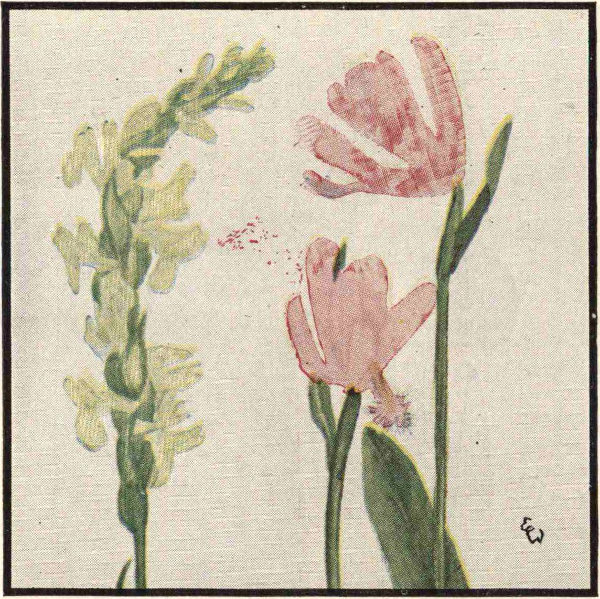
SLENDER LADIES’-TRESSES ROSE POGONIA
Air plants or tuberous-rooted; leaves alternate, undivided; sepals 3; petals 3, the middle one, or “lip,” often complex in structure; stamens 2 or 1, united to pistil; ovary below the perianth.
Slender Ladies’-Tresses (Ibidium gracile) is also called twisted-stalk or corkscrew-plant because of the twisting of the flower-stalk. The stems, which are 8 in. to 2 ft. high, grow from a cluster of tuberous roots and have two broad leaves at the base. This flower ranges from Texas to Nova Scotia.
Rose Pogonia. Snake-Mouth (Pogonia ophioglossoides) grows in swampy places from Texas to Newfoundland. Pogonia is from the Greek, meaning “bearded” and refers to the bearded lip.
Grass-Pink (Limodorum tuberosum) is a pink-flowered orchid of East Texas and the Eastern States similar to the rose pogonia, but does not have the short clasping leaf on the stem.
The orchid family is a large group of more than 15,000 species. Some orchids are air-plants, attaching themselves to tree-trunks, but none of these are found among the 25 orchids growing in Texas. Perhaps the handsomest orchid in the state is the red-flowered flame orchid (Stenorrhynchus cinnabarinus) found in the mountains of the Big Bend. All the Texas orchids are rare enough to need protection.
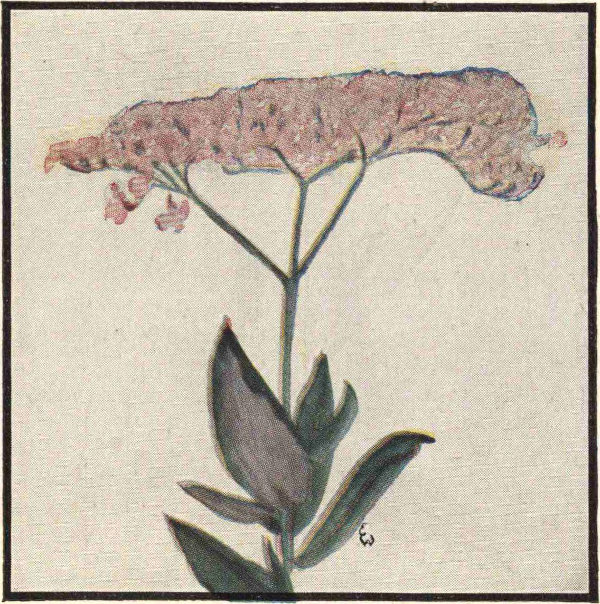
MANY-FLOWERED BUCKWHEAT
Leaves usually alternate; sepals 3-6, sometimes petal-like; petals absent; stamens usually 6-9; ovary 1-celled.
Many-Flowered Buckwheat (Eriogonum multiflorum) is also called umbrella-plant because of its spreading clusters at the top of the stem. It grows about 2 ft. high, being very abundant in sandy soil from South-central Texas to Arkansas and Louisiana in the late summer and fall. The name means “woolly knees,” referring to the jointed stems.
Buckwheat flour is made from the seeds of Fagopyrum esculentum, a closely related plant, similar in size, white-flowered, and with large 3-angled seeds. Queen’s crown or wreath (Antigonon leptopus), a lovely pink-flowered vine widely cultivated in Texas, is a member of the buckwheat family.
Annual Buckwheat (Eriogonum annuum), similar to the many-flowered buckwheat, but with leaves white-woolly on both sides and narrowed at the base, is very abundant in the northwestern part into New Mexico and Mexico. Acre after acre along the highways is often covered with it. Many other white-, yellow-, and red-flowered buckwheats are found in the mountains of West Texas.
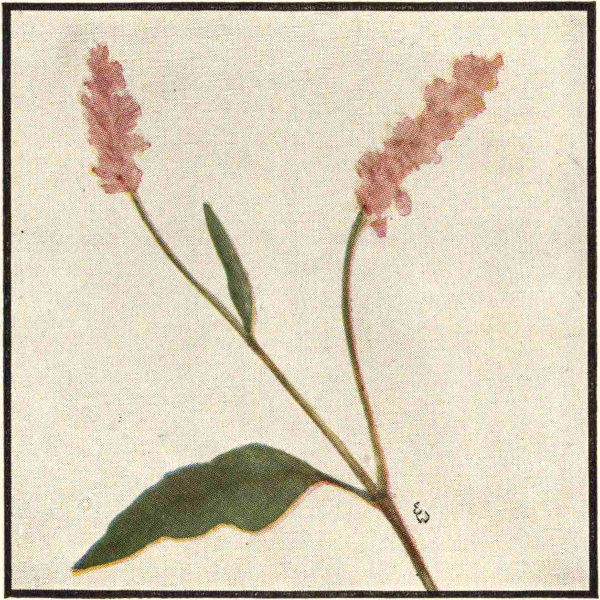
SOUTHERN SMARTWEED
Southern Smartweed (Persicaria longistyla), ranging from Mississippi to New Mexico is also called gander-grass or knotweed. It grows in wet places throughout the state and blooms in the late summer and fall. The dense spikes of small pink flowers are very attractive, the flowers having 5 pink sepals but no petals. The seeds are lens-shaped and covered with a black shining coat. The seeds of many of the smartweeds are considered good food for ducks.
Dotted Smartweed (Persicaria punctata) has scattered greenish-white flowers and 3-angled seeds. The leaves are much narrower than those of the Southern smartweed. Many other smartweeds are found in the state.
Curly-Leaved Dock (Rumex crispus), as well as several other docks, is common in the state. The leaves of some of them are used for greens. Canaigre is the dock of Western Texas and New Mexico, the roots of which have furnished tannin for commercial purposes.

SMALL-FLOWERED FOUR-O’CLOCK PINK FOUR-O’CLOCK
Leaves opposite or alternate; flowers often surrounded by colored bracts; calyx tubular, often petal-like; petals absent; stamens 1 to many; ovary 1-celled.
Gray’s Umbrella-Wort. Pink Four-O’clock (Allionia grayana) has delicate pink flowers which have no petals, but the 5 united sepals are petal-like in appearance. The flowers are spreading or funnel-shaped and open in the afternoon. Several flowers are borne together and are surrounded at their bases by 5 short united floral leaves, forming a pale green veiny involucre which is sometimes mistaken for the flower. The clusters terminate the branches on a widely spreading plant about 2 ft. high.
Small-Flowered Four-O’clock (Allionia incarnata) is very abundant in Southwestern Texas to Arizona and South America. It forms a low, spreading plant, which is profusely covered with small pink blooms less than half an inch broad.
Narrow-Leaved Sand-Verbena (Abronia angustifolia) is a low plant with a dense head of pink flowers which are so fragrant that one plant will perfume the air for some distance. In favorable seasons the hills around El Paso are pink with the lovely blooms. It is called sand-verbena because of the verbena-like clusters.

DEVIL’S BOUQUET ANGEL’S TRUMPET
Devil’s Bouquet (Nyctaginia capitata) is also called skunk flower because of its heavy, disagreeable odor. The head-like clusters of scarlet flowers are very showy, being 2-3 in. broad. The 5-lobed flowers resemble those of the umbrella-worts and likewise open in the afternoons. The plants are low and scattered, but are quite common from Central and Southern Texas to Mexico and New Mexico from May to October.
Angel’s Trumpet (Acleisanthes longiflora) grows from long spreading stems with the long-tubed flowers sharply erect. The flowers are over an inch broad with a tube 4-6 in. long. It is most abundant in the spring, but may be found until October in the same range as the devil’s bouquet. Jimson-weed (Datura) is also called angel’s trumpet.
Bougainvillea is a member of this family frequently cultivated in the southern part of the state. The common four-o’clock is often seen in gardens and in some places has escaped cultivation.
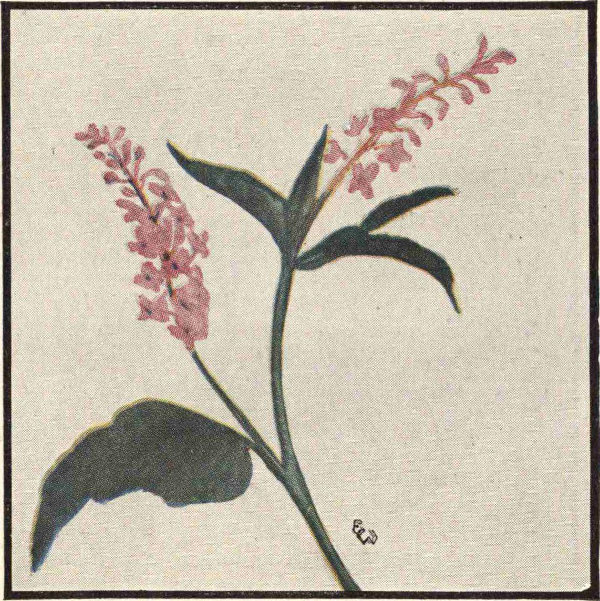
ROUGE PLANT
Leaves alternate, entire; sepals 4-5; petals absent; stamens 3 to many, sometimes united at the base; ovary with 1 to many distinct or united carpels.
Rouge Plant. Small Pokeberry (Rivina vernalis) was named for A. Q. Rivinus, a botanist of Leipzig. It was known as Rivina humilis, the latter name meaning low. It has small flowers, about ¼ in. broad, with 4 white or pink petal-like sepals and 4 stamens. The bright red berries often occur on the stems while flowers are still present. The low plants, a foot or more high, grow profusely in woods in Central Texas, but may be found from Arkansas to the tropics. When vegetable dyes were in common use, a red dye was obtained from the berries.
Ink-Berry. Large Pokeberry (Phytolacca americana) is a leafy, stout, branched plant 3-9 ft. high, with large leaves and spike-like clusters of white flowers and purple berries. It is a perennial that grows from a poisonous root. With special care in the picking and preparation, the young shoots are sometimes used for greens. The shoe-button-like berries were used for ink in pioneer days. Maine to Texas. Summer and fall.
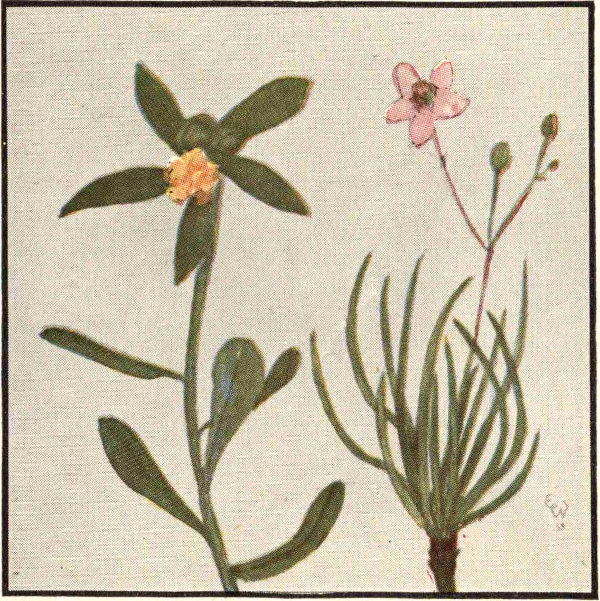
LANCE-LEAVED PORTULACA SMALL-FLOWERED TALINUM
Herbs or undershrubs, often succulent; sepals 2; petals 4-6, soon falling; stamens few or many; ovary 1-celled; fruit a capsule opening by valves or a transverse split.
Lance-Leaved Portulaca (Portulaca lanceolata) is a weed found in sandy soil from Central and Southern Texas to Arizona. The flowers are less than half an inch broad with 5 pinkish-yellow petals and 7-27 stamens. It may be distinguished from other portulacas by the crown-like rim around the capsule. Hairy rose moss (Portulaca pilosa) is more abundant and showy, with purplish-red flowers nearly an inch broad, greatly resembling the large-flowered rose moss in cultivation. The capsule of the portulacas opens by a cap.
Small-Flowered Talinum (Talinum parviflorum) has small pink flowers about ½ in. broad, which, like those of the portulacas, require bright sunlight for opening. These dainty flowers grow on slender stalks from a cluster of short, rounded leaves and may be found in rocky soil from Minnesota to Texas during the summer months.
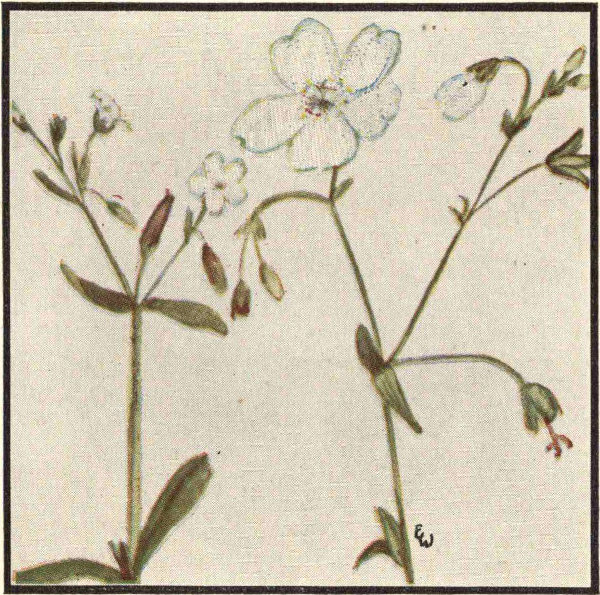
WESTERN CHICKWEED NUTTALL’S STARWORT
Stems usually swollen at the joints; leaves opposite; sepals 4-5; petals 4-5, or absent; stamens usually 8-10; ovary usually 1-celled.
Western Chickweed (Cerastium brachypodum) is one of the early spring flowers to be found throughout the state, ranging from Illinois to Oregon and Mexico. The 5 small white petals are notched at the apex. The name is derived from the Greek meaning “horny” and refers to the horn-shaped capsule from which the seeds are scattered through the opening at the top. Several other chickweeds are found in the state in early spring.
Nuttall’s Starwort or Chickweed (Stellaria nuttallii) is a lovely white-flowered chickweed found on moist sandy prairies or in open woods in Texas, Arkansas, and Louisiana in March and April. The flowers are about 1 in. broad, and the 5 broad petals are deeply notched at the apex.
The pink family is well represented in cultivation, including the carnation, sweet William, garden pink, baby’s breath, and others. The red-flowered catch-fly (Silene laciniata), found in the mountains of West Texas to Mexico and California, is known in cultivation.
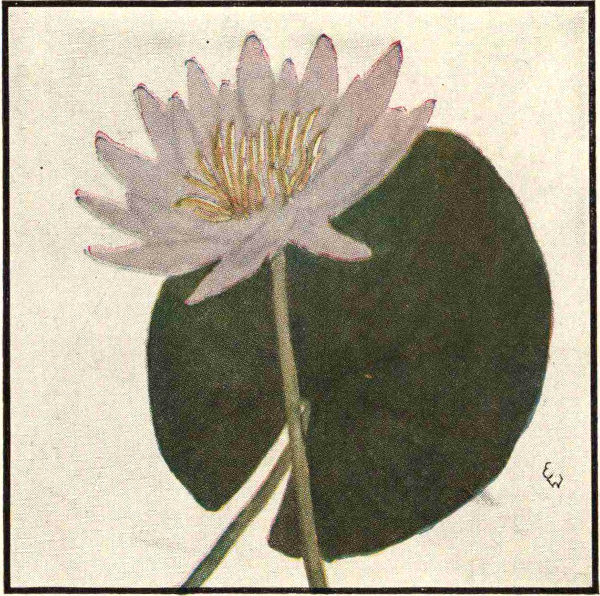
BLUE WATER-LILY
Aquatic herbs; leaves long-stalked, often floating; flowers solitary, large; sepals 3-6; petals numerous; stamens numerous; carpels 8 or more.
Blue Water-Lily (Nymphaea elegans) is a common water-lily along the coast of Texas and Mexico, particularly in the vicinity of Corpus Christi. The flowers vary from nearly white to a purplish-blue or lilac and are 3-6 in. broad. The floating leaves, about 7 in. broad, are dark purple below and nearly round; sometimes they have a few scattered teeth on the margins. The blooms last 3 days, opening about 8 o’clock in the morning and closing shortly after noon.
Yellow Water-Lily (Nymphaea flava) is a yellow-flowered water-lily found on the Texas and Florida coasts. The sweet-scented white water-lily is abundant in the southeastern part of the state.
Spatter Dock. Yellow Pond Lily (Nuphar advena), with yellow cup-shaped flowers 2-3 in. broad, is the common water-lily of slow streams and ponds throughout the state and ranges to Labrador, Florida, and Utah.
The water-lilies form an important food and cover for fish; ducks and muskrats feed upon the many seeds produced.
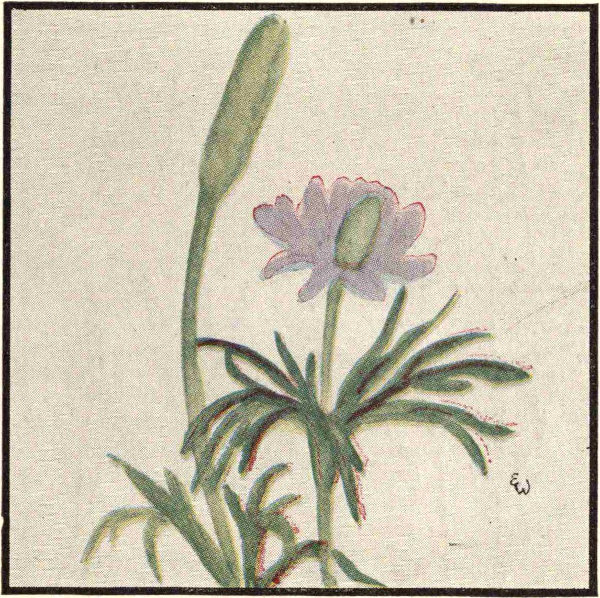
SOUTHERN ANEMONE
Perennials, annuals, or climbing soft-wooded plants; sepals 3 to many; petals few to many; stamens and carpels usually many.
Southern Anemone or Windflower (Anemone decapetala) has 10-20 sepals which resemble petals, varying from a greenish white and pink to the common pale purplish-blue. The plants are commonly low, about 6 in. high in flower, with a few leaves growing from a tuberous root. The leaves are 3-parted, the segments lobed and toothed. The anemone is the Texas harbinger of spring, appearing in late January, February, or March on plains and prairies, and in the chaparral. It ranges from the Southern United States to South America. The Carolina anemone, with bluer flowers and more finely-divided leaves, is abundant in the woods of East Texas.
The crowfoot or real buttercup family (the yellow evening primrose is also called buttercup) is considered by most botanists as the plant family from which other plants have been derived. In many the fruits look very much like the fruit head of the arrowleaf. The columbine is a member of this family frequently cultivated in the gardens of the state, but the few native ones are not very abundant.
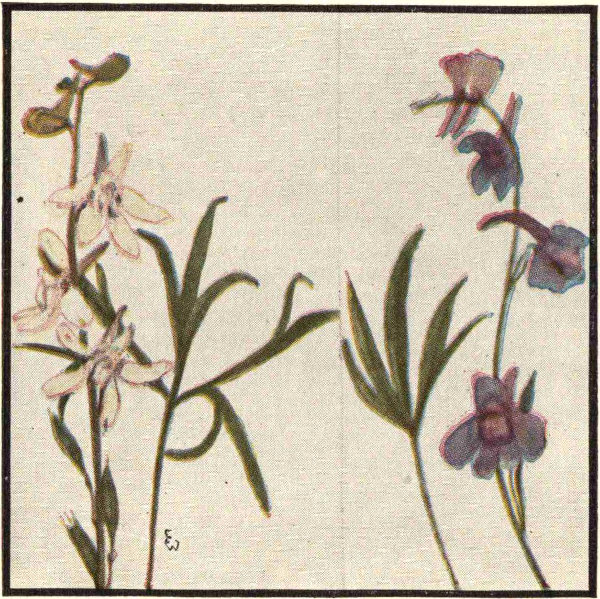
WHITE LARKSPUR CAROLINA LARKSPUR
White Larkspur (Delphinium albescens) is the common larkspur of prairies and plains of Texas and ranges to Southern Canada. In Texas it blooms most abundantly in May. The white flowers resemble rabbit faces and are tinged with green and purple. It is the bane of ranchmen, for it is poisonous to cattle.
Carolina Larkspur (Delphinium carolinianum) commonly has lovely deep blue flowers, though white forms may be found. It is very abundant in East Texas in March and April, growing 1½-2 ft. high. The plants have few leaves, and these are 3-5 parted, each part being divided into narrow linear lobes. It is very much like the Texas larkspur (Delphinium vimineum), which has blue or white flowers, grows taller, and is more leafy than the Carolina larkspur.
“Delphinium” is derived from the Latin meaning “dolphin,” so-called because of the resemblance of the spurred flowers to a dolphin. The common garden larkspur is native to Southern Europe. Some of the larkspurs furnish drugs.
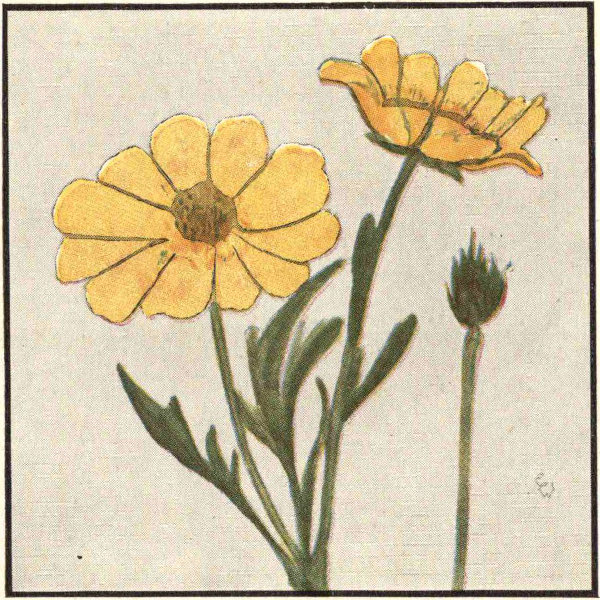
LARGE BUTTERCUP
Large Buttercup (Ranunculus macranthus) has handsome, golden-yellow flowers about 2 in. broad. There are 10-15 broad yellow petals which are longer than the sepals and have a nectar pit at their base. The leaves are mainly basal, long-stalked, and divided into wedge-shaped lobes. It ranges from Central to Southwestern Texas and is most abundant in April. It is a plant which does well in cultivation but requires plenty of water; it blooms in the shade better than most garden plants.
Many of the buttercups grow in marshy places, a fact which is responsible for the old Latin name meaning “little frog.” Many different kinds are found along roadside ditches and in marshy places in East Texas. Some members of the crowfoot family, including the wood-anemone and the marsh marigold, common in the Northern States but not native to Texas, yield poisonous honey.
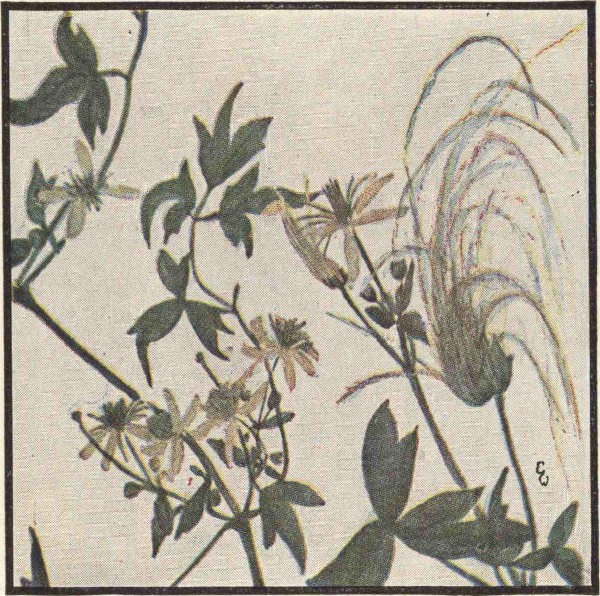
OLD MAN’S BEARD
Drummond’s Virgin’s Bower. Old Man’s Beard (Clematis drummondii) is a vine growing in great profusion, covering shrubs and fences from Central Texas to Arizona and Mexico. The 4 petal-like sepals are pale greenish-yellow, almost white, narrow and thin with margins somewhat crinkled, about ½ in. long. The flowers bloom in the summer, being inconspicuous among the branching leafy stems. The stamen-bearing flowers are on a separate vine from the seed-producing flowers. The seeds mature in a few weeks, and soon the vine is covered with iridescent masses of silky, feathery plumes, 2-4 in. long, which grow out from the seed cover. These plumes are elongated, persistent styles and are responsible for many common names given to the vine, including grandfather’s beard, gray beard, goat’s beard, and love-in-the-mist.
Western Virgin’s Bower (Clematis ligusticifolia), with white flowers and leaves with 5-7 leaflets, has been reported from the mountains of West Texas.
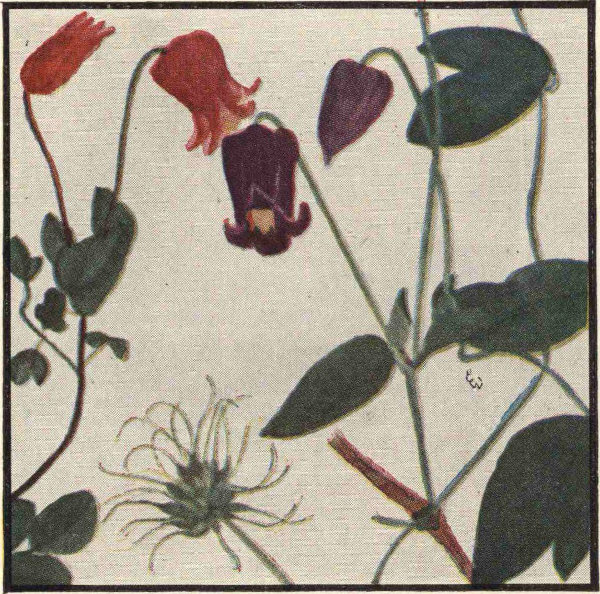
SCARLET CLEMATIS PURPLE LEATHER FLOWER
Texas Leather Flower. Scarlet Clematis (Clematis texensis) has maroon or scarlet bell-shaped flowers about 1 in. long. It is a climbing vine found along streams in Central Texas, growing 6-10 or more feet high. The leaves are thickened, entire or lobed, ovate to rounded. This clematis is a hardy climber, well known in cultivation, giving rise to many hybrids when crossed with the marsh leather flower (Clematis crispa), which is a low climber, 3-4 ft. high, with lavender bell-shaped flowers. The leather flowers have no petals, the showy bells being made up of 4 thickened sepals. The flattened fruits grow in head-like clusters about an inch thick and have plumose tails 1-2 in. long.
Purple Leather Flower (Clematis pitcheri), together with the marsh leather flower, is often called blue bell. Except in color, the flower is very much like the scarlet clematis. The leaflets are more frequently 3-lobed, and the tails on the fruits are silky but not plumose. It grows in damp woods from Indiana to Mexico, beginning to bloom in Texas in April and continuing into the summer.
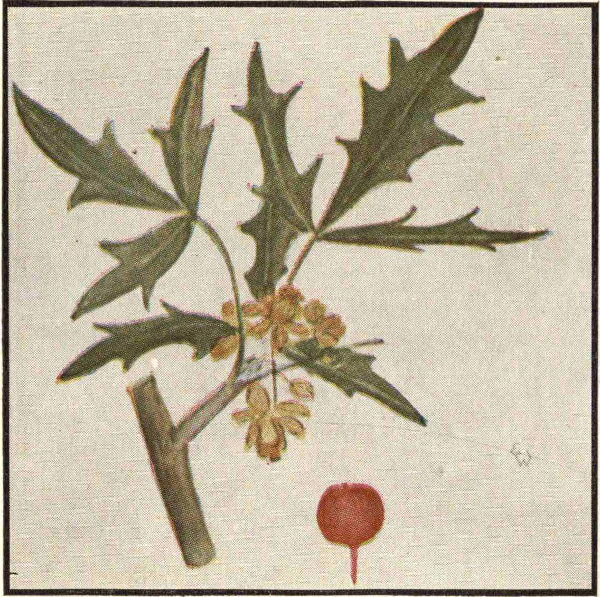
AGARITA
Herbs or shrubs; leaves simple or compound; sepals 6, similar to petals; petals 6; stamens 6, irritable, opening by valves; ovary 1-celled; fruit a berry.
Agarita. Texas Barberry (Berberis trifoliolata), known also as agrito (meaning “little sour”), chaparral berry, and wild currant, is an evergreen shrub forming an important part of the chaparral in the central and southwestern parts of the state and adjacent Mexico. The thick gray-green leaves are divided into three leaflets which have 3-7 lobes ending in sharp spines. The stiff spreading branches form a compact shrub 4-5 feet high.
The clusters of fragrant flowers are among the first spring blossoms to appear in late February and March. With 6 spreading yellow sepals and 6 yellow petals forming a cup around the stamens and pistil, the small flowers are somewhat like those of the narcissus. The acid berries ripen in May and June, being used for jellies and wines; the flowers are an important source of nectar; and the wood and roots furnish a yellow dye which was used by Indians and pioneers.
May Apple. Mandrake (Podophyllum peltatum) is abundant in moist woods in East Texas. The white flower growing in the fork of the stem is overtopped by the two umbrella-shaped leaves.
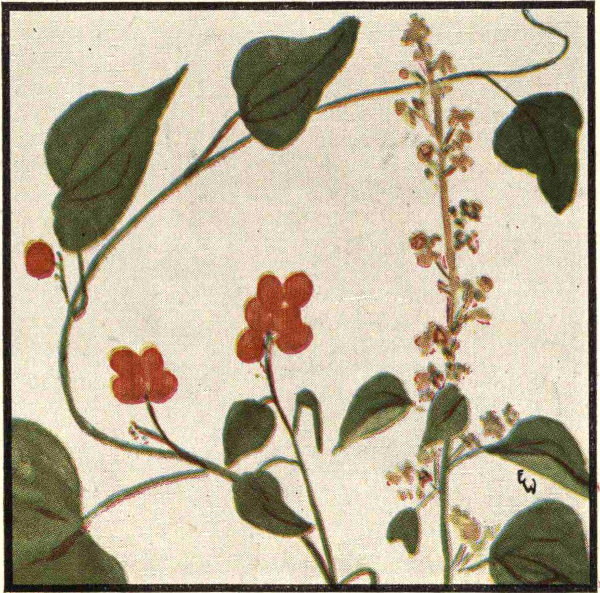
MOONSEED VINE
Usually twining shrubs or small trees; flowers small, unisexual and perfect; sepals 6; petals 6, or absent; stamens 6-12; carpels 3-6; fruit berry-like, 1-seeded.
Moonseed Vine (Cebatha Carolina) is a vine with clusters of small red berries. It is very abundant throughout the state in woods and on fences, ranging north to Kansas and Virginia. It is also called coral-bead, margil, coral-vine, and red-berried moonseed. “Cebatha,” from the Greek, alludes to its climbing habit, while “moonseed” refers to the curved seed of the fleshy red berries which ripen in the fall and remain on the vines long after the leaves have fallen. The small white flowers bloom during the summer and fall. The leaves are quite variable, sometimes entire and sometimes distinctly 3-lobed and rarely 5-lobed, being smooth above and downy beneath.
The berries of the Indian moonseed contain an acrid poison which is used by the Chinese in catching fish, as it will temporarily stun or intoxicate the fish.
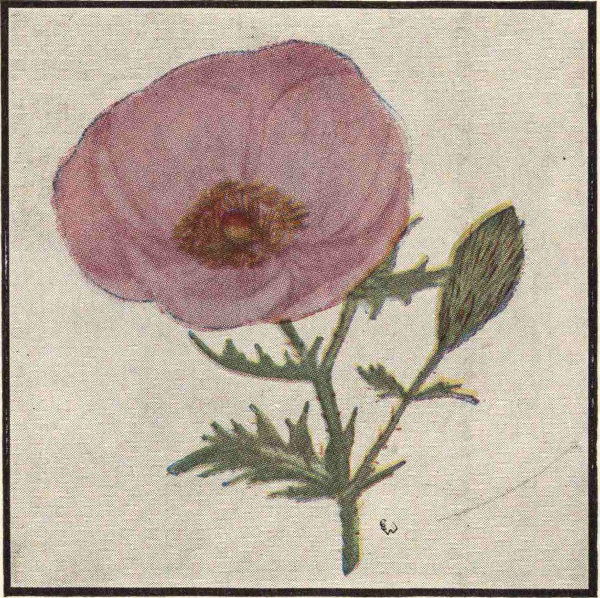
ROSE PRICKLY POPPY
Annuals or perennials with colored juice; sepals 2-3; petals 4-6, rarely more or wanting; stamens numerous; carpels 2 or more united; capsules opening by valves or pores.
Rose Prickly Poppy (Argemone rosea) is one of the loveliest flowers of South Texas. It is very abundant along the Rio Grande, extending into Mexico and northward almost to San Antonio. The large flowers vary in color from pale pink to rose and purple-rose and are more cup-shaped than the white-flowered species. It has gray-green leaves conspicuously blotched with white along the midribs, the slightly wavy margins being armed with sharp spines. Like other prickly poppies, the flowers have 6 petals, the 3 outer a little different in shape from the 3 inner, and an orange-colored sap. Long considered a variety of the western prickly poppy (Argemone platyceras), which has very spiny leaves and stems and white flowers, it may readily be separated because of its seed-pods, which are about 2 in. long and decidedly broader above the middle.
Argemone is from the Greek meaning an eye disease, supposedly cured by the plant. The opium poppy (Papaver somniferum) has been widely planted in gardens, and has escaped in places in the state.
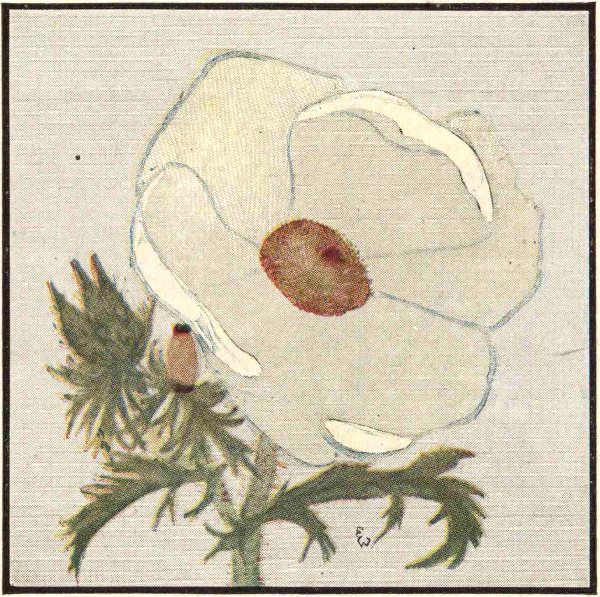
ROUGH-STEMMED PRICKLY POPPY
Rough-Stemmed or White Prickly Poppy (Argemone hispida) is a bushy, leafy-stemmed plant growing about 2-3 ft. high. It is distinguished from several other very abundant white-flowered poppies by the fact that it has rough hairs as well as spines on the stem. The flowers as a rule are larger, often being 4-6 inches broad. The unusual sepals of the prickly poppies should be noted, as they sometimes cause the flower buds to be confused with the fruits. There are usually 3 sepals, which are horned or hooded, armed with spines, and snugly overlapping each other by a narrow margin. In the rough-stemmed prickly poppy the horns are large and triangular in shape. It ranges from Texas to Kansas and California.
Texas Prickly Poppy (Argemone delicatula) is not so branched or leafy and has flowers somewhat smaller, 2½-3 in. broad. The stigmas are purple instead of red, and the capsules are less than an inch long. This poppy grows in dry soil in Central Texas. The prickly poppies bloom most profusely in April, but scattered blooms appear throughout the summer and fall.
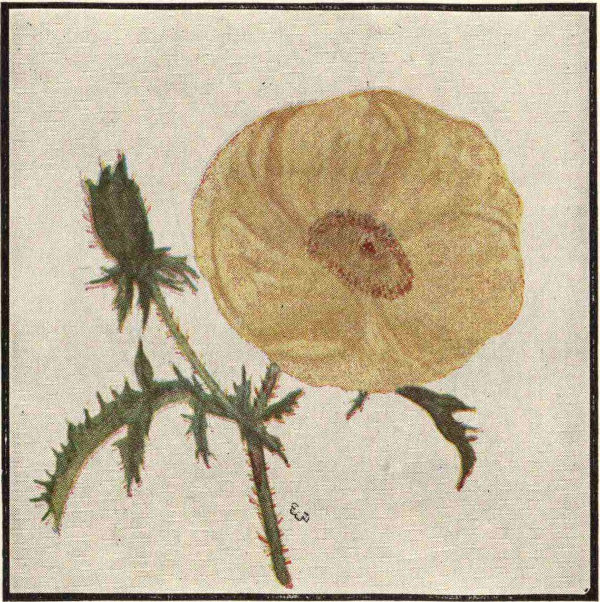
YELLOW PRICKLY POPPY
Yellow Prickly Poppy. Mexican Poppy (Argemone mexicana) is a common weed in tropical America, extending into Southwest Texas in the vicinity of Laredo and Del Rio, and has been introduced into many other countries. It is also called bird-in-the-bush, devil’s fig, flowering or Jamaica thistle, and Mexican thorn poppy. It has smaller flowers than the white and rose prickly poppies. It blooms in Texas in March and April and throughout the summer if the stems are cut. For cut flowers, the stems should be burned immediately upon gathering; otherwise the flowers soon wither.
The seeds of the Mexican poppy are valued for the painter’s oil obtained from them. The oil from the seeds is also said to act as a mild cathartic, the plant otherwise possessing emetic, anodyne, and narcotic properties.

GOLDEN CORYDALIS TEXAS CORYDALIS
Leaves usually much divided; sepals 2; petals 4 in 2 series, outer usually spurred, the 2 inner usually crested and united; stamens 4 or 6; seeds shining.
Golden Corydalis. Plains Scrambled-Eggs (Capnoides montanum) is a common plant throughout the central and western parts of the state, ranging to Arizona and Montana, and blooming in Texas with the earlier spring flowers in March and April. By some botanists it is placed in the Corydalis group, which was named because of the resemblance of the flower spur to that of a lark. The pods are about an inch long, and the seeds are black, smooth, and shining. The short-podded scrambled-eggs (Capnoides crystallinum) comes into the northern part of the state from Kansas and Missouri. The pods are over half an inch long, about ¼ in. broad, and covered with blisters.
Texas Corydalis or Scrambled-Eggs (Capnoides curvisiliquum) grows in the sandy regions of the state. It is usually a more bushy plant than the preceding ones, with longer 4-angled pods.
Dutchman’s breeches (Dicentra cucullaria), so called because of the shape of the flower, does not come into the state. The plant in Texas which is called Dutchman’s breeches from the shape of the seed case is Thamnosma texana, a member of the rue family.
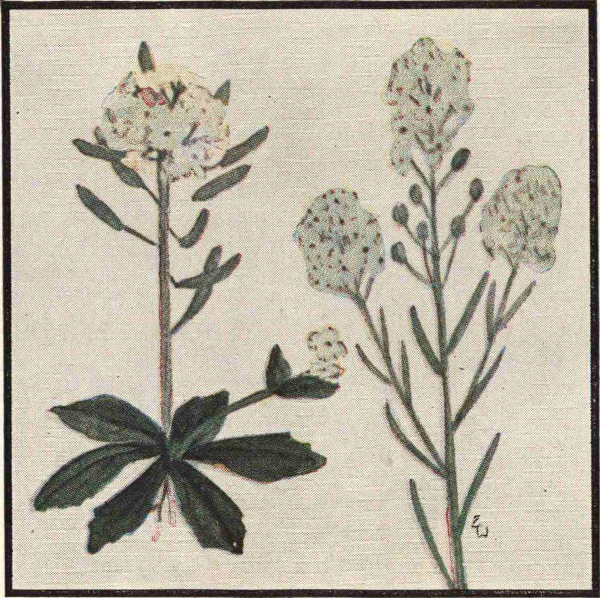
WHITLOW-GRASS PEPPERGRASS
Annual or perennial herbs; sepals 4; petals 4, standing opposite each other in a square cross; stamens, 4 long and 2 short; fruit a special pod called a silique.
Wedge-Leaved Whitlow-Grass (Draba cuneifolia) is so small that it might be overlooked if it bloomed at any other time than early spring. Growing from a cluster of basal leaves, the stems are topped by the cluster of small, alyssum-like flowers. It grows throughout the Southern United States and Mexico.
Alyssum-Flowered Peppergrass (Lepidium alyssoides) is a low bushy perennial plant with numerous clusters of small white flowers. It grows in the western part of the state, ranging to Arizona and Colorado. Many other peppergrasses are found in the state, some with inconspicuous flowers, but all having the small, flat, roundish seed-pod which is usually notched above. The foliage and pods have an aromatic-peppery flavor. In some species the leaves are used for salad and the seeds for bird food, but the seeds from some native species have been fed to canaries with fatal results.
The mustard family is a large group well represented in Texas among the early spring flowers and includes many of our vegetables, such as mustard, cabbage, cauliflower, radish, and water-cress.
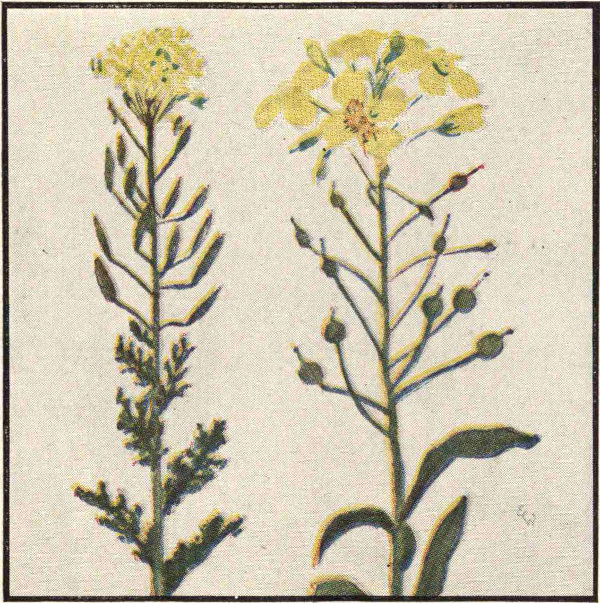
TANSY MUSTARD SLENDER BLADDER-POD
Tansy Mustard (Sophia pinnata) grows in dry soil across the continent, blooming in Texas in March and April. The narrow pods are about half an inch long, erect or ascending. The flowers are small, the petals yellow. In the southern part of the state it is very abundant and grows 2-3 ft. high. The name was given because of medicinal properties accredited to the plant.
Slender Bladder-Pod. Cloth-of-Gold (Lesquerella gracilis) can be recognized by its bladder-like pods, which are responsible for its common name of pop-weed. The yellow petals are narrowed at the base and streaked with orange. The first flush of yellow on plains and prairies is usually due to the bladder-pods. There are more than 20 species in the state, most of them being very abundant. The scientific name is in honor of Leo Lesquereux, a Swiss and American botanist.
The western wall-flower (Erysimum asperum), which grows in sandy areas in West Texas, is one of the showiest yellow mustards in the state. Several large-flowered purple mustards are common, including Streptanthus bracteatus.

GREGGIA SPECTACLE-POD
Greggia (Greggia camporum) is a white-flowered mustard which looks like the yellow western wall-flower. The flowers are about half an inch broad and sometimes tinged with purple. The stems are about a foot high and almost concealed by the broad gray-green leaves. The woolly pods are narrow, flattened, and about half an inch long. It is one of the commonest flowers in Southwestern Texas, blooming in April, May, and June.
Spectacle-Pod (Dithyraea wislizeni) is a common plant on sandhills and gravelly mesas in Western Texas and ranges to Utah and Mexico. Any one seeing the seed pods will think that the common name is most appropriate. The plants grow 1-2 ft. high and are topped by the showy clusters of white flowers. The leaves and flowers are very much like those of greggia, but the fruits easily distinguish them. It was first collected by Wislizenus in New Mexico in 1846.
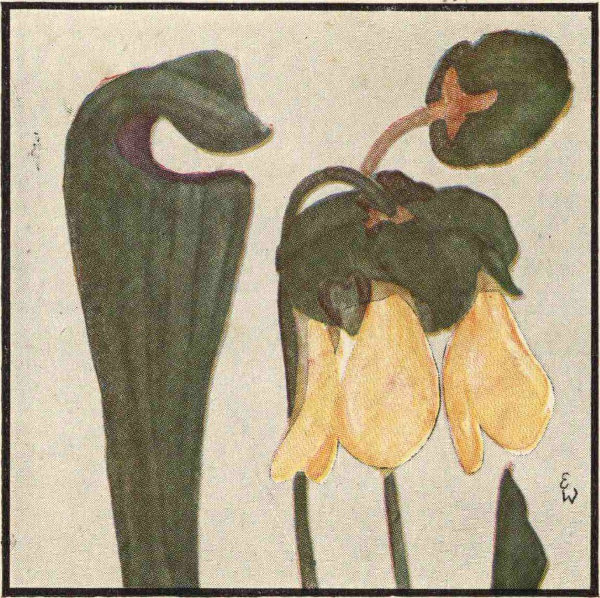
YELLOW PITCHER-PLANT
Herbs with tubular leaves; flowers nodding; sepals 4-5; petals 5, or absent; stamens numerous; style often umbrella-like; ovary 3-5-celled.
Yellow Pitcher-Plant. Trumpet-Leaf (Sarracenia sledgei) is also called trumpets, water-cup, watches, and biscuits. The last two names are suggestive of the broad, umbrella-shaped structure bearing the stigmas and occupying the center of the flower. The other names refer to the tubular, ribbed, trumpet-shaped leaves. The flowers are drooping at maturity, with 5 fiddle-shaped yellow petals and 5 shorter yellow sepals tinged with brown or red. It grows in swamps from East Texas to Alabama and is quite similar to the eastern Sarracenia flava. April-May.
The pitcher-plant is a most efficient collector of insects. The upper part of the leaf bends over, forming a lid whose inner surface is covered with minute honey-glands attractive to insects. The upper part of the tube is smooth, affording little foothold and causing the insect to fall into and drown in the sticky fluid given off in the lower part of the tube. Downwardly directed hairs prevent his escape. After a time his body is dissolved and absorbed by the plant. An overdose of animal food causes the browning and decay of the leaves.
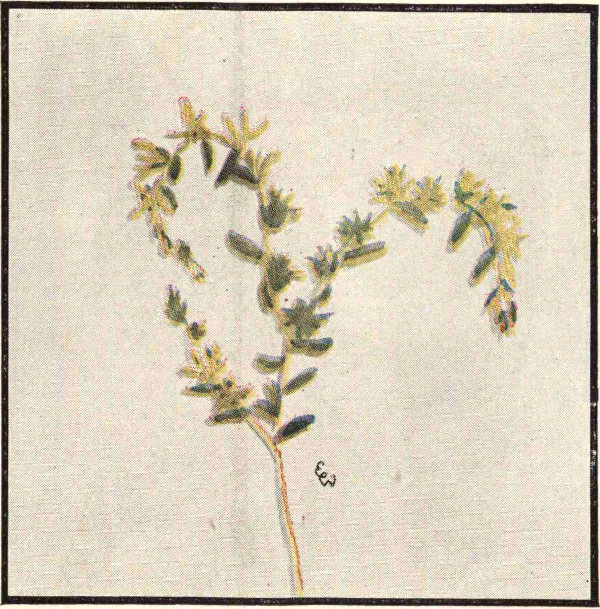
PRAIRIE STONECROP
Usually succulent herbs; leaves opposite or alternate; sepals 4-5; petals 4-5; stamens 5 or 10; carpels 4-5, free.
Prairie or Nuttall’s Stonecrop (Sedum nuttallianum) is an annual with forking branches covered with small yellow star-like flowers. The succulent leaves are short and rounded. The sedums are characterized by 4-5 sepals and petals, 8-10 stamens, and 4-5 small spreading seedcases. The prairie stonecrop grows in dry, open places from Missouri to Texas and blooms from April to June. It makes an excellent carpeting plant when used in sunny places.
The stonecrop belongs to a large group of plants, including live-forever and many other cultivated favorites, most of which are used for rockeries. Wright’s stonecrop (Sedum wrightii) is a white-flowered plant, very much like the prairie stonecrop, found in the mountains in the western part of the state, New Mexico, and Mexico. Sedum is from the Latin meaning “to sit” and refers to the low growth habit. In the same family are included the house-leeks, some of which are known as hen-and-chickens, or old-man-and-woman, because of the detached offshoots which form new plants.
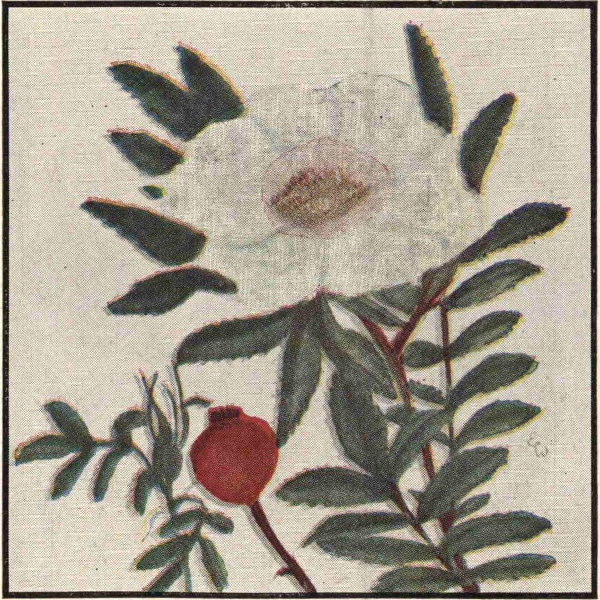
WHITE PRAIRIE ROSE
Trees, shrubs, or herbs; leaves simple or compound, stipules present; sepals 5; petals 5; stamens numerous; carpels 1 or more; sepals and petals borne on rim of calyx-tube.
White Prairie Rose or Woods’ Rose (Rosa woodsii) at first glance may be confused with the dewberry because of the low, bushy creeping stems and similar white flowers. The stems are 1-3 ft. high and are armed with straight prickles, usually in pairs; the leaves have 5-9 oval leaflets ½-1½ in. long. The flowers bloom in late May and early June, the dark red globe-shaped hips maturing in the late summer and fall. It may be found from Texas to Minnesota and Colorado. The white flowers are commonly two inches broad and very much like those of the McCartney rose, but it is more closely related to the cinnamon rose.
The McCartney rose (Rosa bracteata), early introduced from China into the Southern States and planted for windbreaks, is still very abundant on the coastal prairie, often forming great mounds about 10 ft. high. The thick evergreen leaves are divided into 5-9 oval leaflets, which are bright green and shining above. The sepals and the broadened portion of the stem below the white flower are densely silky.
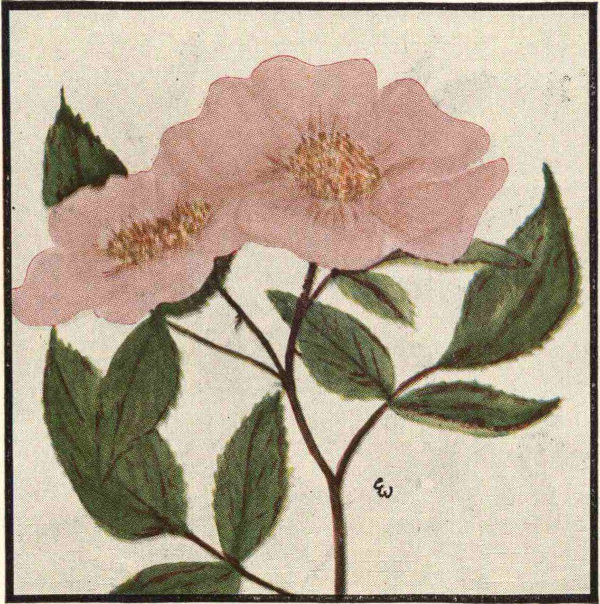
PINK PRAIRIE ROSE
Pink Prairie Rose or Climbing Rose (Rosa setigera) has climbing branches 6-15 ft. long with straight scattered prickles. The leaves are divided into 3-5 leaflets which are sharply pointed and 1-3 in. long. The showy pink flowers, 2 in. broad, grow in terminal clusters. This plant is considered one of the finest foods and covers for quail, grouse, and other birds. Native from Ontario to Texas and Florida, it is a hardy climber which has been widely introduced into other places, Baltimore Belle being one of the early cultivated forms. It is particularly abundant in Texas in the vicinity of Tyler, blooming in late May and June.
The wild roses are fairly rare in the state, but many cultivated roses are grown. Tyler has recently become a center of rose-growing, and carloads of rose plants are shipped throughout the United States. The scientific name retains the ancient Latin name.
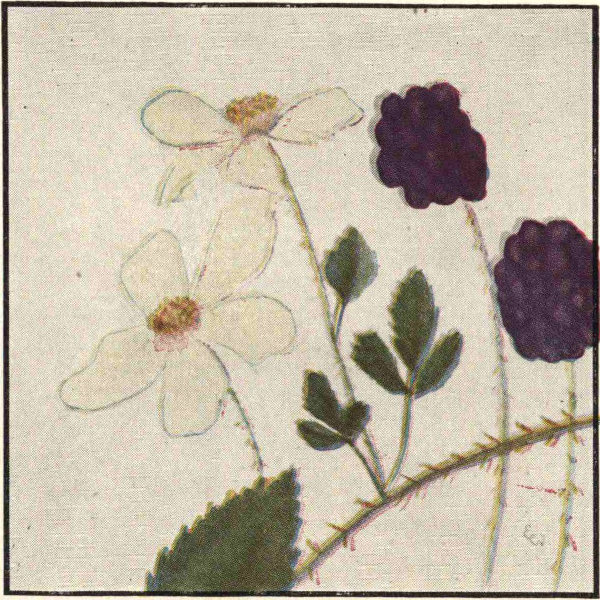
SOUTHERN DEWBERRY
Southern Dewberry (Rubus trivialis) has large white flowers very much like those of the wild rose, but the petals are narrower, particularly at the base. The fruit is a head of small, fleshy-seeded fruits, purplish-black when ripe. The flowers bloom in March and early April, the sweet and palatable berries ripening in the latter part of April. The plant is an evergreen shrub with trailing or low climbing stems, 10-15 ft. long, heavily armed with prickles. Fences along the roadside are often covered with dense masses of the stems.
Bush Blackberry (Rubus argutus) grows in moist woods in East Texas and on through the Gulf States to New Jersey. The stems are 3-4 ft. high, the branches erect. The flowers are white and grow in thick clusters. The berries are somewhat dry, oblong, and edible, but not very palatable.
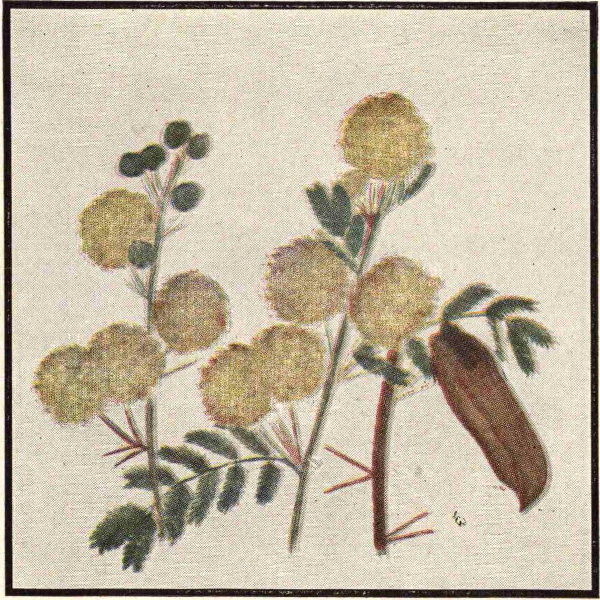
HUISACHE (Pronounced wee satch)
Usually trees or shrubs; leaves mostly twice pinnate; flowers small, in heads or spikes; sepals 5, calyx tubular; petals 5; stamens 5 or more; ovary 1-celled; fruit a pod.
Huisache (Acacia farnesiana), also known as opoponax, popinac, cassie, and sweet acacia, is a tropical shrub or small tree native to the Americas but widely introduced in other countries. The wide-spreading, graceful trees are almost evergreen, as the leaves are not shed before new ones appear unless affected by the cold. The slender, sharp spines occur in pairs at the base of the fern-like leaves, which are dark green and have 2-5 pairs of divisions with 10-25 pairs of narrow leaflets about ¼ in. long. The ball-like clusters of deep-yellow fragrant flowers usually appear before the leaves. The clusters are over half an inch broad, the many tubular flowers bearing numerous stamens, which give a feathery appearance to the clusters.
Various products from the trees are in use in many countries—forage from leaves, honey and perfume from the flowers, tannin from the bark and fruit, ink from the fruit, and medicinal products from nearly every part. In Southern Texas it is highly valued as a honey crop, the flowers blooming from February to April as a rule, but occasionally as early as December.
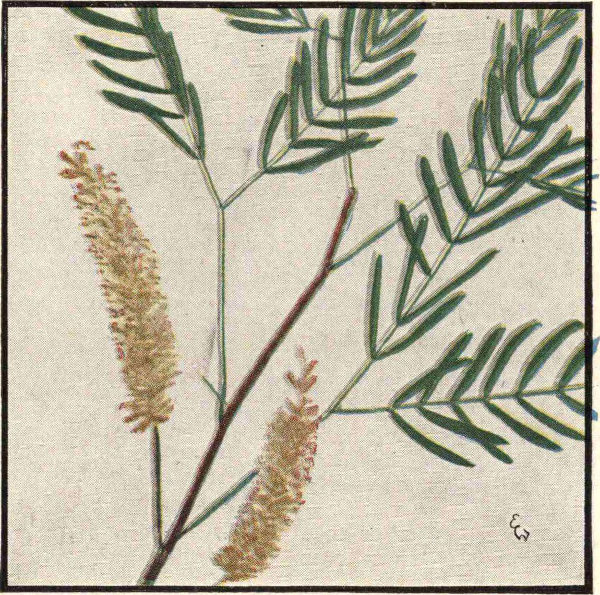
MESQUITE
Mesquite (Prosopis juliflora glandulosa) is found on prairies throughout the state but grows luxuriantly in the southwestern part. In moister regions it is a graceful tree with lacy yellow-green leaves and is armed with stout, vicious spines over an inch long, but in the drier regions it is a spreading shrub with large underground roots which Mexicans dig up for fuel. Spikes of greenish-white or cream flowers appear at intervals during the warm months. Long beans, 4-8 in. long, soon turning pale yellow, mature in a few weeks. The leaves have 2 or 4 widely spreading divisions and commonly bear 6-15 pairs of leaflets about 1 in. long.
Like the huisache, the mesquite has many uses. The beans are edible, the pulp containing 25-30 per cent grape sugar. The Indians used the beans for a food, first grinding them into meal in holes in the rocks. They form a valuable stock food in Hawaii, where the trees have been introduced. The wood is hard and takes an excellent polish, but is chiefly used for fence-posts, railroad ties, fuel, and paving blocks. The honey produced from the flowers is not so good as huisache honey nor is so much produced.
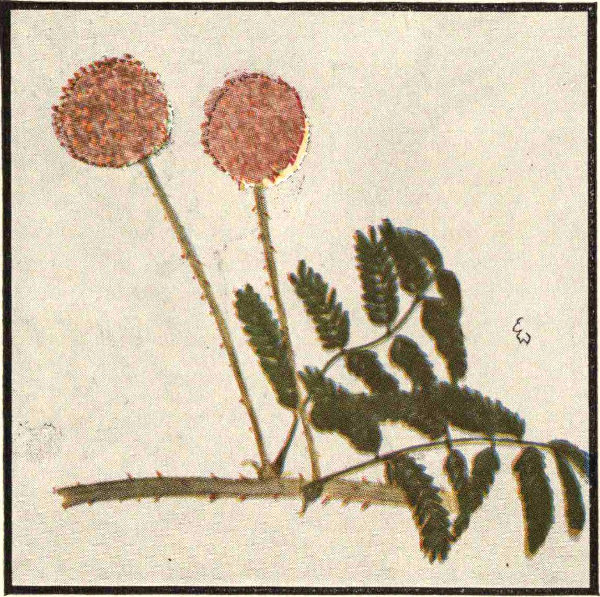
PINK SENSITIVE BRIAR
Pink Sensitive Briar (Leptoglottis uncinata) is also called pink mimosa and shame-vine, the latter name being given because of the leaf’s habit of closing when touched. The vines sprawl on the ground, growing out 2-4 ft. They are densely covered with small, recurved prickles. The leaves are divided as in other mimosas, having 4-8 pairs of divisions each bearing 8-15 pairs of short leaflets. The small, fragrant pink flowers are borne in dense heads. The pods are nearly round, densely covered with spines, and about 1½ in. long. It grows in dry soil from Virginia to Mexico, blooming in Texas in April and May.
Yellow Sensitive Briar (Neptunia lutea) is very much like the pink briar but has oblong heads of yellow flowers. The pods are smooth and flat and markedly narrowed at the base. The yellow briar grows in sandy soil from Oklahoma and Texas to Florida, blooming in June.
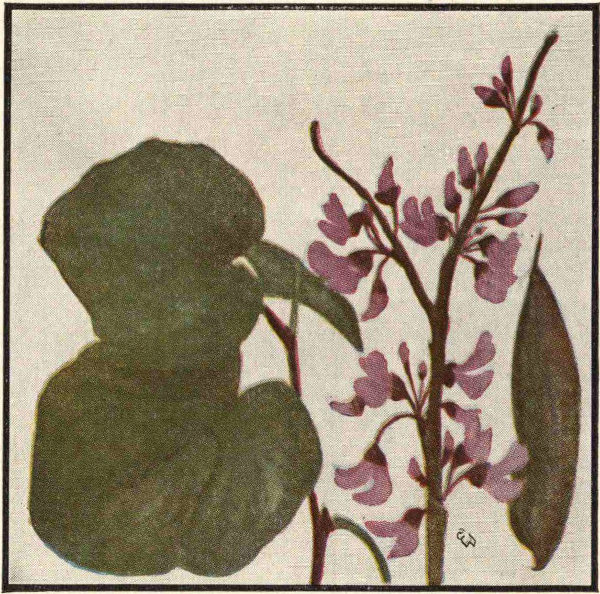
TEXAS REDBUD
Trees, shrubs, or rarely herbs; leaves usually once or twice pinnate; flowers mostly showy; sepals 5; petals 5; stamens mostly 10; ovary 1-celled; fruit a pod.
Texas Redbud (Cercis reniformis) is one of the handsomest shrubs of the limestone hill region of Texas and New Mexico. The pea-shaped flowers appear on last year’s wood in February or March, often remaining lovely for a month before the leaves appear. The leaves are a glossy green above, rounded and sometimes deeply notched or kidney-shaped (reniform), and usually 3-4 in. broad. The clusters of numerous red seed-pods are very conspicuous in the summer and autumn. The flat pods have a narrow wing on one side and are pointed at both ends, 2½-3 in. long and over ½ in. broad.
The Canadian or eastern redbud is found in the northern and eastern part of the state. It has smaller flowers and very pointed leaves. The western redbud grows in the mountainous region of the state and has similar leaves but smaller flowers.
The Asiatic redbud is called Judas-tree because Judas is supposed to have hanged himself from one of the trees. Redbud flowers, served either fried or pickled for salads, are sometimes eaten by people. It is an excellent shrub or small tree for highway and garden planting.
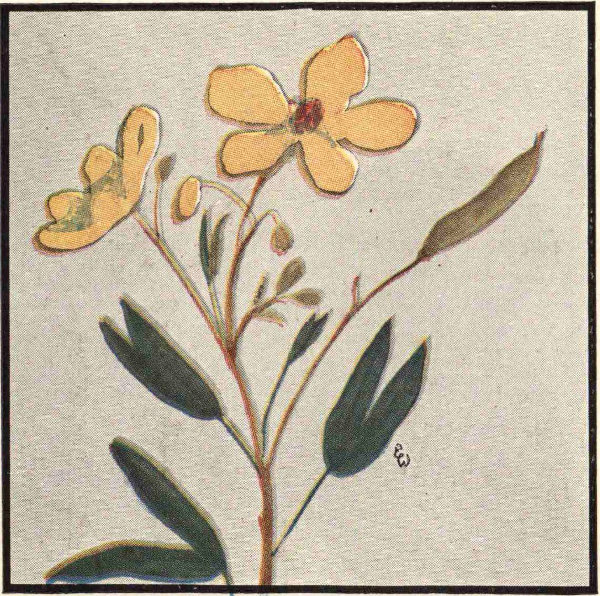
TWO-LEAVED SENNA
Two-Leaved Senna (Cassia roemeriana) gets its common name from the two spreading leaflets into which the leaf is divided. They are 1-2 in. long and have a slender stalk about the same length. The stems are commonly about 8-12 in. high, growing from a woody perennial root. The sparsely-flowered clusters of yellow flowers appear from spring until fall. The seed-pods are about an inch long and half an inch wide. This senna is very abundant from Central Texas into Mexico and New Mexico. It bears the name of Roemer, a geologist sent from Germany to study the geology of the grant made to the German colonists at New Braunfels. He was in Texas from 1845 to 1847, visited and botanized with Lindheimer at New Braunfels, and carried many new Texas plants back to Germany.
The senna group is very large and mainly tropical in distribution, many species being noted for medicinal properties. The coffee senna (Cassia occidentalis) and the American senna (Cassia marilandica) are common weeds in the eastern part of the state. The velvet-leaved or Lindheimer’s senna grows in the western part of the state.
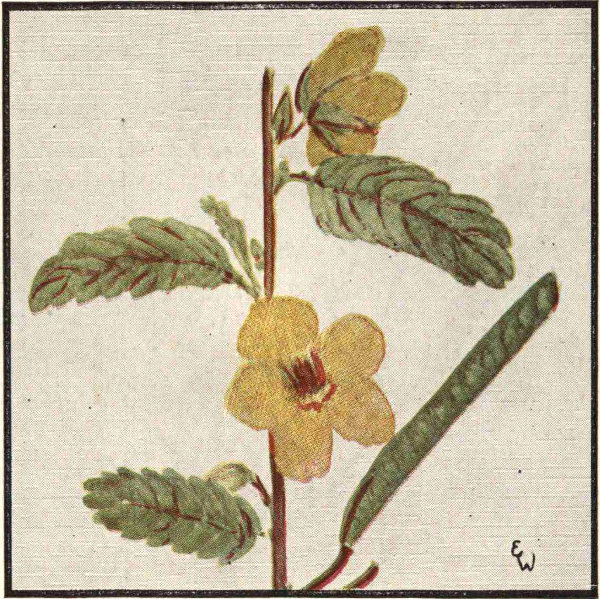
PARTRIDGE PEA
Partridge Pea. Prairie Senna (Chamaecrista fasciculata) is also called large-flowered sensitive pea, dwarf cassia, and magoty-boy-bean. It blooms in the summer months and is very abundant in sandy soil in Central and Eastern Texas, ranging to Mexico and the northern part of the United States. The oblong leaves have 8-14 pairs of linear leaflets and a conspicuous orange or brown gland near the base. The flowers have five yellow petals, somewhat unequal and irregular in shape. Several buds grow on a short stalk between the leaves, but usually only one flower on the stalk opens at a time. It is an erect annual plant growing about 2½ feet high and often widely branched above. The pods are flattened, about ¼ in. wide and 2 in. long.
Several shrubs of the senna family are popular in Texas gardens, among them the bird-of-paradise (Poinciana gilliesii). It is a South American plant with showy yellow flowers which have 10 long brilliant red stamens protruding 3-5 inches from the flower.
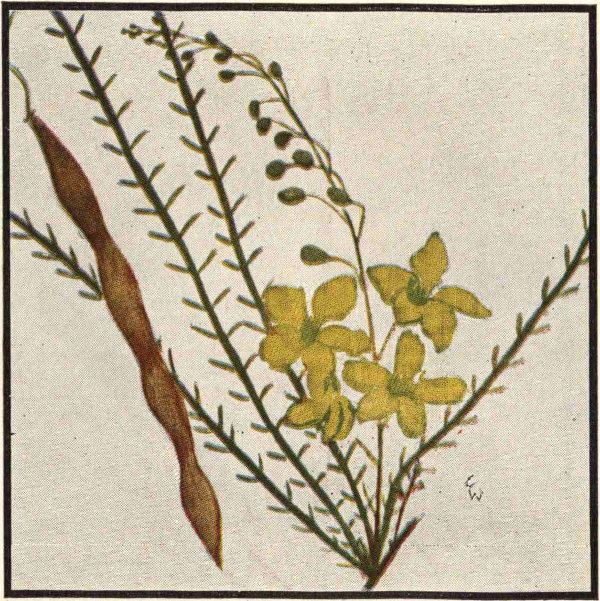
RETAMA. HORSE BEAN
Retama. Horse Bean (Parkinsonia aculeata) is also known as Jerusalem-thorn, shower-of-gold, and palo verde, the latter meaning “green timber” from the green trunk and branches. It forms a spiny shrub or small tree with long, graceful, somewhat drooping branches, bearing bundles of leaves and sprays of yellow flowers. The long divided leaves are somewhat unusual. The leaf-stalks are green, broad, and flattened, performing the functions of the small leaflets which often drop off quite early. The 5 yellow petals are almost equal, but one bears a honey gland at its base and soon becomes red, remaining on the stalk longer than the others. The pods are 3-5 in. long, very narrow and constricted between the seeds. It ranges from Central Texas to Mexico and tropical America, bearing a profusion of blooms through the warm months after rains.
Besides being a very ornamental shrub of value in landscaping, the plant has various other uses. The seeds are edible and have long been used as food by Indians, Mexicans, and many animals. Mrs. Quillin, author of Texas Wild Flowers, reports the use in the treatment of diabetes of a tea the Mexicans make from the branches and leaves.
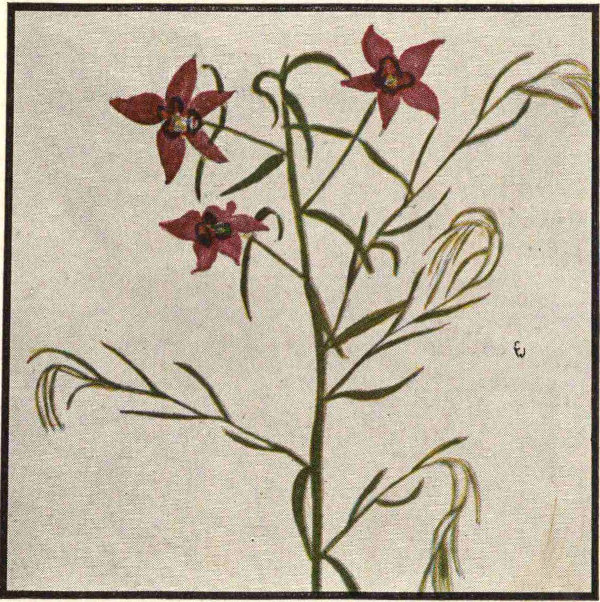
PRAIRIE SAND-BUR
Shrubs or perennials, leaves small; flowers irregular; sepals 4-5, petal-like; petals 4-5, smaller than sepals; stamens 3-4, united at base; fruit woody, armed with spines.
Prairie Sand-Bur. Linear-Leaved Krameria (Krameria lanceolata) is not the sand-bur of the grass family with which all children of the South are familiar; however, the burs are just as spiny, but are densely covered with white hairs. The flowers and short silky leaves grow on prostrate branches from a thick woody root. The 5 wine-red sepals may be mistaken for the petals which are smaller than the sepals and tinged with green, the 3 upper being united. The flowers are about an inch broad. The plant is not conspicuous but is quite abundant in dry, rocky soil from Kansas to Mexico, blooming from April to June.
Several shrubby kramerias grow in the southwestern part of the state. The name is in honor of an Austrian physician, Johann Kramer. Medicinal properties are reported for some of the species.
Chacate (Kameria grayi) is a densely branched shrub, 1-3 ft. high, with purple flowers. The bark of the root is used by Mexicans in dyeing leather a reddish-brown. It is found in the mountains of West Texas and Mexico.
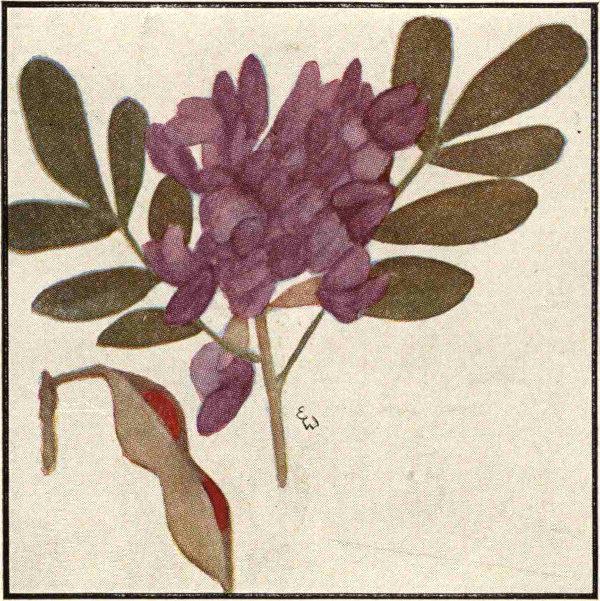
TEXAS MOUNTAIN LAUREL
Leaves simple or compound; flowers pea-shaped; sepals 5, united in a tube; petals 5; stamens often 10 and united in 1 or 2 groups; fruit a 1-celled pod.
Texas Mountain Laurel (Sophora secundiflora) is an evergreen shrub or small tree growing on limestone hillsides from Texas to New Mexico and Mexico; it is particularly abundant in Southwest-Central Texas. The dense clusters of violet-blue flowers, at their best in the latter part of March but blooming earlier or later in different sections, are very showy against the glossy dark-green, leathery leaves. Many variations in color exist in nature from dark violet-blue to violet-tinged and white. The flowers have a strong, heavy scent which is disagreeable to most people. The brilliant scarlet beans, which mature in a few weeks, contain a poisonous alkaloid.
The Texas mountain laurel is not at all related to the southern mountain laurel (Kalmia latifolia), a rose-flowered shrub of the heath family. The sophoras have retained the Arabian name and include in their group many handsome ornamental shrubs, among which is the Japan pagoda tree. The Texas sophora can be readily grown from seed but is seldom successfully transplanted.
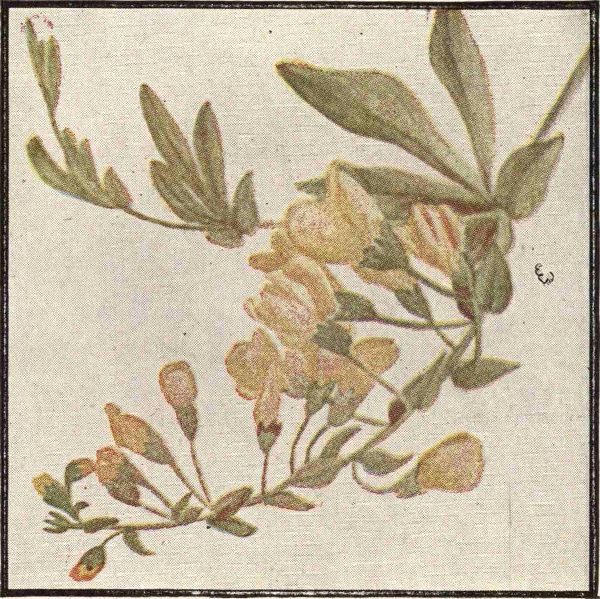
BUSH PEA
Bush Pea. Large-Bracted False Indigo (Baptisia bracteata) is sometimes called hen-and-chickens pea from the growth habit of the plant. The clusters of cream-colored flowers grow downward and peep out from the bushy leaf-growth. The flowers are about 1 in. long, and the 3 gray-green leaflets are 1-3 in. long. It grows on sandy slopes or moist prairies from the eastern part of Texas to Minnesota and South Carolina, blooming in Texas in April.
Texas Bluebonnet (Lupinus texensis) (see frontispiece) was widely known in pioneer days as buffalo clover. It grows in great abundance on limestone hillsides between the Brazos and Pecos Rivers from Dallas southward into Mexico. Seed-houses sell the Texas bluebonnet under the name of Lupinus subcarnosus, the bluebonnet of sandy areas. It has narrower flower spikes and rounded leaf-tips. Several other lupines are found in Texas but are not very common. The name is from the Latin meaning “wolf,” because it was thought the plants ruined the fertility of the soil. On the contrary, the lupines are excellent fertilizers, as the small nodules on the roots contain nitrogen-fixing bacteria which add to the soil nitrates. It blooms from March to early May. The bluebonnet was adopted as the state flower in 1901.
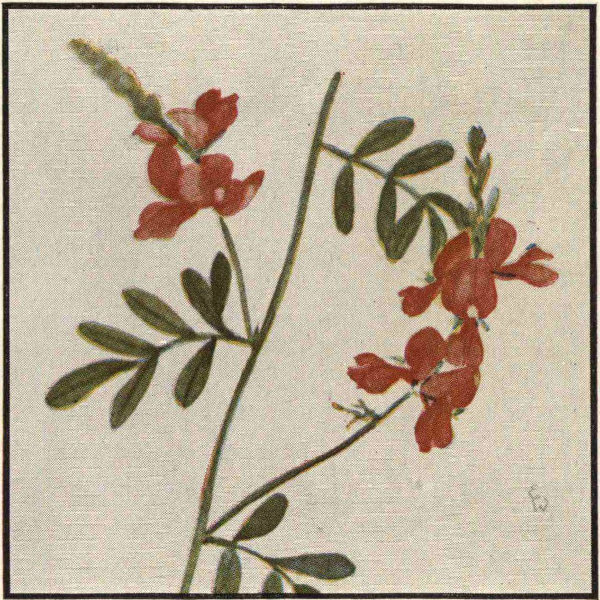
INDIGO-PLANT
Indigo-Plant. Scarlet Pea (Indigofera leptosepala) has prostrate branches growing from a woody root. The short, erect spikes of scarlet, pea-shaped flowers are borne near the ends of the branches, blooming from early spring until late summer, their blossoms forming an ever-increasing scarlet circle after each rain. The leaves are divided into 5-9 leaflets, narrowed at the base and about half an inch long. A small amount of indigo may be extracted from the foliage. While this is not a very conspicuous plant, it is one of the most widely distributed in the state and ranges to Mexico, Kansas, and Florida.
The indigo-plant belongs to a large group, mostly tropical, and many species, as the name indicates, are indigo-bearing. Commercial indigo, now a coal-tar product, was formerly obtained from a shrub (Indigofera tinctoria) introduced for cultivation into South Carolina in 1742. Several shrubby species of indigo-plants are found in the state, but none of them are very abundant.
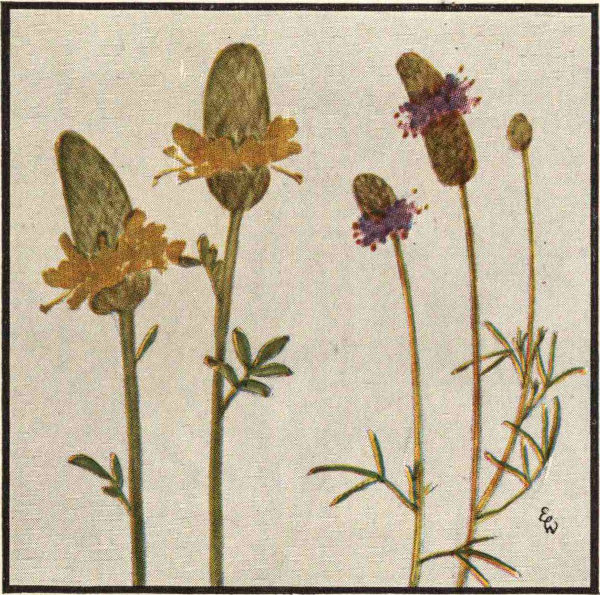
GOLDEN DALEA PURPLE PRAIRIE CLOVER
Golden Parosela or Dalea (Parosela aurea) may not be recognized at first glance as a member of the pea family, since the flowers grow in dense clusters at the top of erect branches, 1-1½ ft. high, which grow from a thick, woody root. The yellow flowers are small and pea-shaped, with a calyx which has slender, silky-plumose lobes. It may be found on chalky slopes of prairies from Texas to Missouri and South Dakota in June and July.
Several shrubby paroselas, very handsome when in full bloom, are found in the southwestern part of the state. Purple parosela (Parosela pogonathera) is a vivid, reddish-purple flowered species of the southwestern part.
Purple Prairie Clover (Petalostemon purpurea) is quite similar to the golden parosela in its growth habit, narrow glandular leaflets, and head-like flower clusters. It grows on prairies from Minnesota to Texas. The white prairie clover (Petalostemon multiflorum), with ball-shaped clusters of white flowers, is common on prairies from Kansas to Texas. Both prairie clovers bloom in June and July.
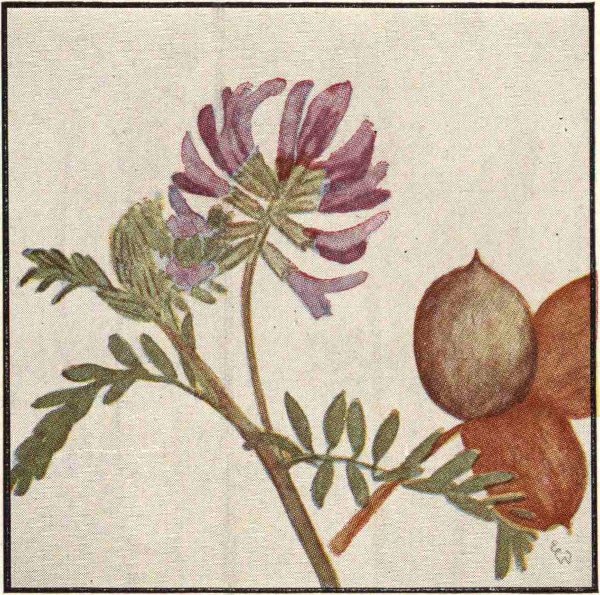
LARGER GROUND PLUM
Larger Ground Plum (Geoprumnon mexicanum) blooms with the first flowers of spring, forming conspicuous clumps on prairies from Illinois to Nebraska and Texas. The spreading prostrate branches grow 6-12 in. long and are covered with spike-like clusters of pale-purple flowers. The fleshy pods soon turn red and plum-like, maturing several weeks after flowering. The pods are edible and may be found in prairie-dog holes among the foods these animals have stored for the winter.
Loco Weeds are closely related to the ground plum, two of them being found in Texas and causing much loss to stockmen. They cause a slow poisoning of horses, sheep, and cattle but are particularly injurious to horses. The poisoning is chiefly due to the barium salts in the plant and is characterized by symptoms of staggering, some paralysis, and emaciation. The woolly loco weed (Astragalus mollissimus) has woolly leaves with 19-27 oval leaflets about half an inch long and spikes of violet-purple flowers. The stemless loco weed (Oxytropis lamberti) has basal leaves with 9-19 nearly linear leaflets about an inch long. Both are common on the plains, but the latter ranges into Southern Canada.
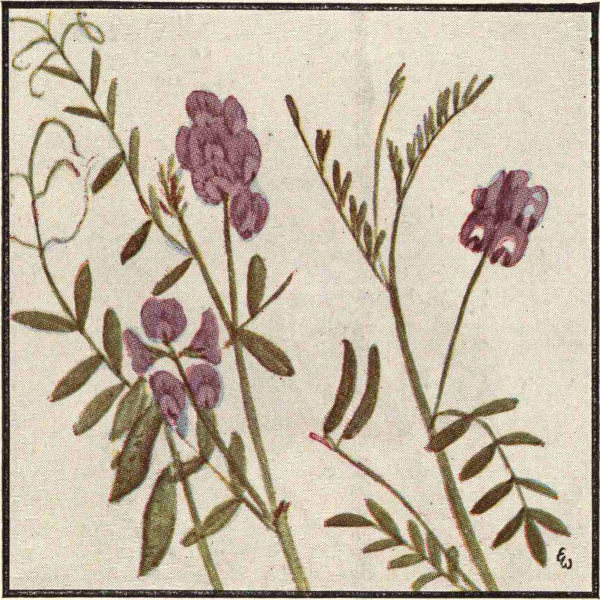
TEXAS CLIMBING VETCH NUTTALL’S MILK VETCH
Nuttall’s Milk Vetch. Turkey Pea (Hamosa nuttalliana) is a low plant with few-flowered clusters of small flowers. Although it is inconspicuous, it is so common in yards and fields from Arkansas to Arizona that many people are familiar with it. It blooms in March in the southern part and May and June in the northern part of its range. The narrow pods are slightly curved and nearly an inch long. There are several hamosas with similar pods which are common in the state.
Texas Climbing Vetch (Vicia texana) has prostrate branches, 1-2 ft. long, and divided leaves terminating in branched tendrils by which the branches climb over the low plants with which they come in contact. Clusters of the dainty, pale bluish-purple flowers appear in late March and April, the plants forming masses of bloom along roadsides in the sandy regions of the state from Central Texas to Arkansas and Mississippi.
Many of the climbing vetches are planted for cover crops, and one is a garden bean. Many of the garden beans belong to the Phaseolus group, among these being the tepary bean (Phaseolus acutifolius latifolius), a native bean from West Texas to Arizona.
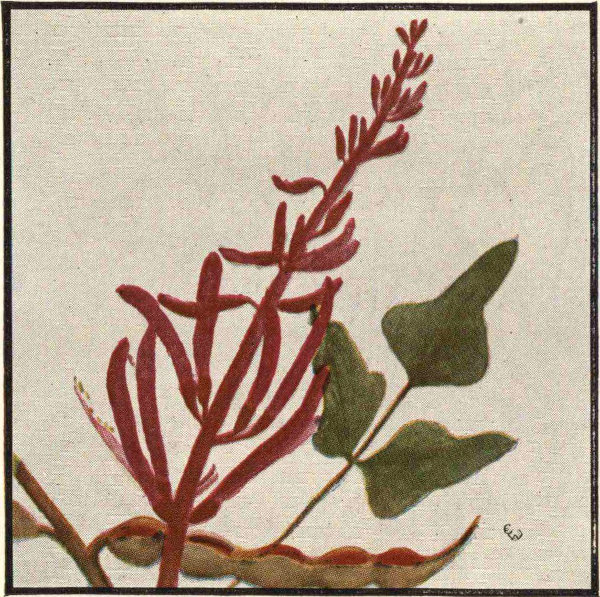
CORAL-BEAN
Coral-Bean (Erythrina herbacea) grows in woods along the coast from Texas to North Carolina. It has erect, herbaceous stems growing from a woody root. The flowers appear before the leaves in spike-like clusters at the ends of the branches. “Erythrina” is from the Greek, meaning “red” and refers to the color of the flowers, which are over an inch long and have the upper petal wrapped around the other petals. The leaves are 6-8 in. long and slender-stalked; they are divided into 3 broad leaflets.
The coral-bean belongs to a group of highly ornamental tropical plants. It does well in cultivation in Southern and Central Texas but is not suitable for a cut-flower, as the flowers soon drop off. The red beans are often used for necklaces. When the pods begin to open, the clusters may be gathered for winter decorations. The coral-tree (Erythrina cristagalli) from Brazil is common in cultivation and has broader and showier flowers than the coral-bean.
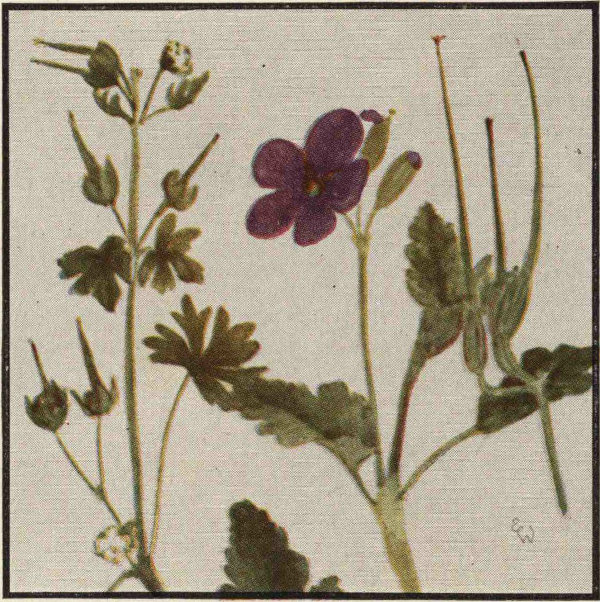
CRANE’S BILL STORK’S BILL
Leaves simple or compound; sepals 4-5; petals mostly 5; stamens 5, 10, or 15, more or less united at base; carpels 3-5, prolonged into styles.
Crane’s Bill. Texas Geranium (Geranium texanum) is very much like the Carolina geranium. The small white flowers are inconspicuous, but the seed capsules with their long beaks resembling the crane’s bill are very noticeable. The scientific name is from the Greek meaning “crane.” The Texas geranium differs from the Carolina geranium in having pitted seed and fewer flowers. The cultivated geraniums belong to the Pelargonium group.
Stork’s Bill. Pine Needle (Erodium texanum) has fruits similar to the Texas geranium, but the beaks are much longer, 1-2 in. long. The short-stalked flowers are quite showy while they are open, but they close in the heat of the day. The wine-red petals are marked with delicate purple veins. The low spreading branches are 2-12 in. long. This plant grows on rocky limestone hillsides from Texas to California and blooms in April and May.
Pin-Clover. Filaree. Alfilaria (Erodium cicutarium) has finely-divided, lacy leaves and small pink flowers. It is used in some places as a forage crop.
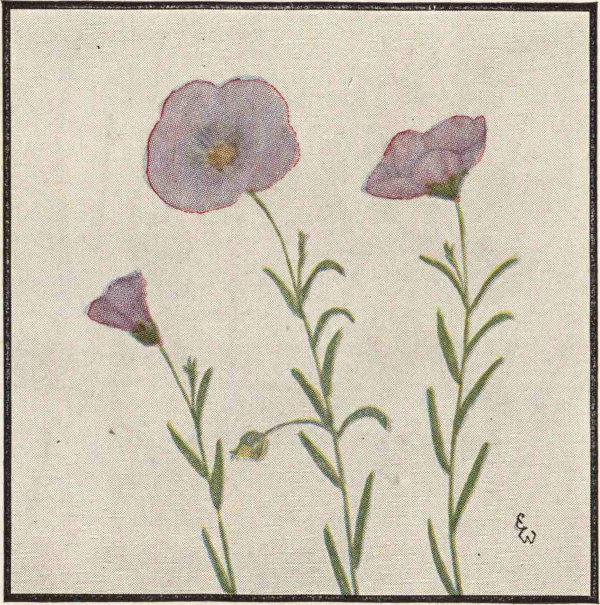
BLUE PRAIRIE FLAX
Leaves simple; sepals usually 5, free or united at base; petals usually 5, soon falling; stamens 5, united at base; styles 3-5, thread-like; capsules 3-5-celled.
Blue Prairie Flax (Linum lewisii) has lovely sky-blue flowers, 1-1½ in. across. The petals are veined with purple and drop off in the heat of the day or upon being disturbed. This flax is a slender, branched plant with a perennial root. It is very abundant on the prairies in the vicinity of Ft. Worth and Dallas, blooming there in May, and ranges to Arizona and Southern Canada. It may grow 1-2 ft. high, but in Texas it is often only about 8 in. high.
This flax is very much like the European perennial flax (Linum perenne) and the cultivated flax (Linum usitatissimum), from which flax fiber is obtained. “Linum” is the ancient Latin name for the flax plants. Many of them are showy plants of horticultural importance; for even though the flowers last only a few hours, the plants bear a profusion of blooms. They are valuable for Texas gardens, as they do best in sunny places. Flaxes may often be identified by the dropping off of the petals.
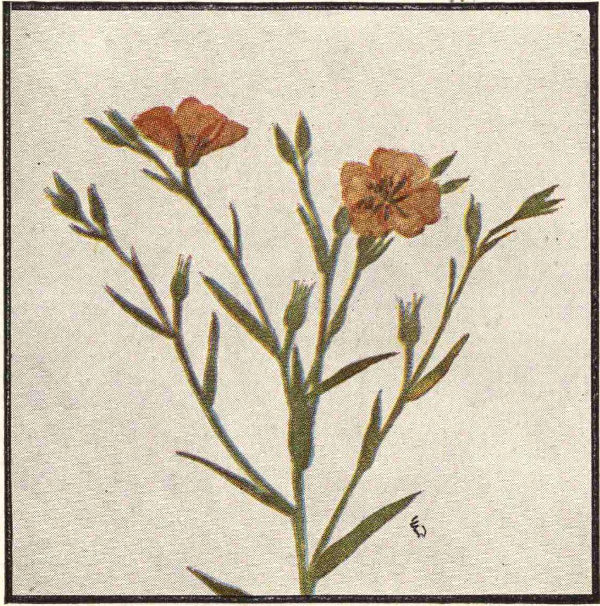
YELLOW PRAIRIE FLAX
Yellow Prairie Flax (Linum sulcatum) is a leafy, much-branched plant, 8-16 in. tall, with large yellow petals, orange-red and veined at the base. The leaves are narrow, about 1 inch long. The flaxes have 5 styles, sometimes united, as in this plant, and sometimes separate, but often remaining on the capsule until the seeds are shed.
The yellow flaxes are sometimes separated from the blue-flowered ones and called Cathartolinum. There are many of them in the state, most of them so closely related that only an expert can distinguish them. They bloom from March until June. In the southern part the commonest one is the dwarf flax (Linum multicaule), which has its stems densely covered with short leaves. Linum rigidum is a large-flowered flax with stiff stems common on prairies from Texas to Southern Canada. It has been reported as poisonous to sheep in the Pecos Valley.
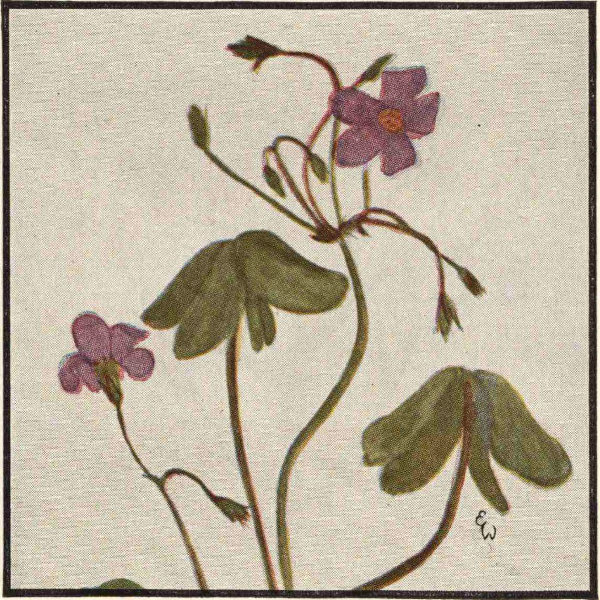
DRUMMOND’S WOOD-SORREL
Leaves digitately or pinnately divided; sepals 5; petals 5; stamens 10, slightly united at base; ovary 5-celled; styles 5, free; fruit a capsule.
Drummond’s Wood-Sorrel (Oxalis drummondii) is also called sour-grass, vinegar-grass, oxalis, and violet wood-sorrel. It grows in dry soil from Central Texas to New Mexico, blooming in the late summer and fall. It has flowers like the violet wood-sorrel with similar basal leaves growing from a bulb. As a rule, the plants and flowers are larger and the leaflets are crescent-shaped. Oxalis flowers usually open in bright sunlight, and the leaves close at night.
Violet Wood-Sorrel (Oxalis violaceae) is very abundant in the woods of East Texas and on into the Western United States. The plants are generally about six inches high. Children often eat the leaves, but a considerable quantity will cause violent convulsions. The poisoning is due to the presence of oxalic acid crystals, which give a sour taste to the leaves.
The bulbs of many wood-sorrels are potted in the fall to provide house flowers in February and March. Drummond’s wood-sorrel makes an excellent border plant.
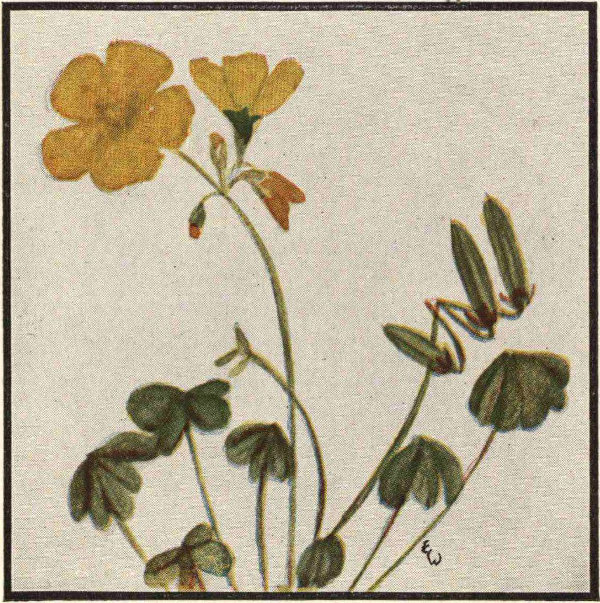
YELLOW WOOD-SORREL
Yellow Wood-Sorrel (Oxalis texana) is a large flowered wood-sorrel in East Texas. The golden-yellow petals are about ¾ in. long. The flower stalk is about twice the length of the stem and leaves. It differs from the large-flowered wood-sorrel of the Southern States (Oxalis macrantha) by having smooth instead of hairy stamen filaments.
Many of the yellow wood-sorrels are common weeds throughout the state. There are many different species. The white or pink-flowered wood-sorrel (Oxalis acetosella) is considered by many people as the shamrock of Ireland; but others consider white clover (Trifolium repens) as the true shamrock.
Dichondra-Leaved Wood-Sorrel (Oxalis dichondraefolia) is a low plant of Southern Texas and Mexico which has pale yellow flowers like the yellow wood-sorrels, but the leaflets differ in being rounded and entire and resemble the leaves of the dichondras (see page 101).
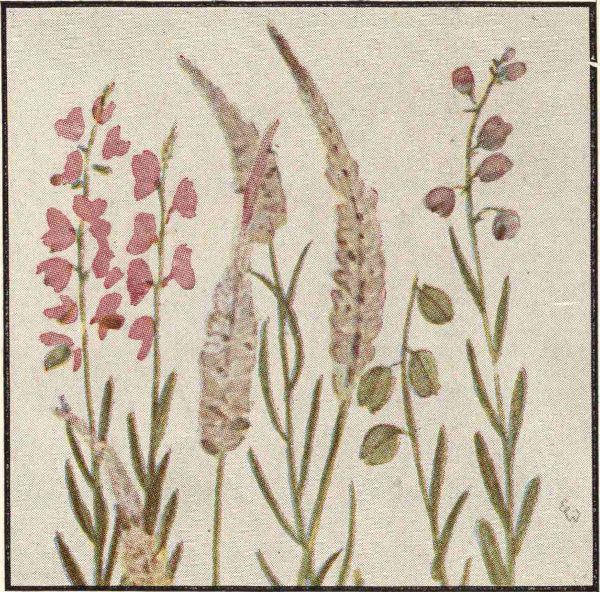
PINK MILKWORT WHITE MILKWORT PURPLE MILKWORT
Flowers pea-shaped; sepals 5, the 2 inner larger and often petal-like; petals 3 or 5, the lower concave, often fringed; stamens 8, united, opening by apical pores; fruit a 2-celled capsule.
Pink or Bitter Milkwort (Polygala polygama) is a showy-flowered milkwort growing in sandy woods in East Texas. It has erect branches with slender clusters of pink flowers about ¼ in. long and horizontal branches under the soil bearing closed flowers which are self-fertilized. It blooms in Texas in April.
White Milkwort (Polygala alba) has densely-flowered spikes of greenish-white flowers, the buds often tinged with purple. A drug obtained from the dried root is used as an irritant. Like the closely related Seneca snake-root (Polygala senega), it probably contains saponin, which will dissolve the red blood-corpuscles. The roots of the latter are used in medicine to produce vomiting and as an antidote for snake-bite. The white milkwort is common on prairies and chalky slopes from Montana to Mexico from April to July.
Purple Milkwort (Polygala puberula) grows in the mountains of West Texas, Arizona, and Mexico. It has much larger seed capsules than the two preceding. The capsule is one of the chief features for identifying the milkworts, being 2-celled and flattened.
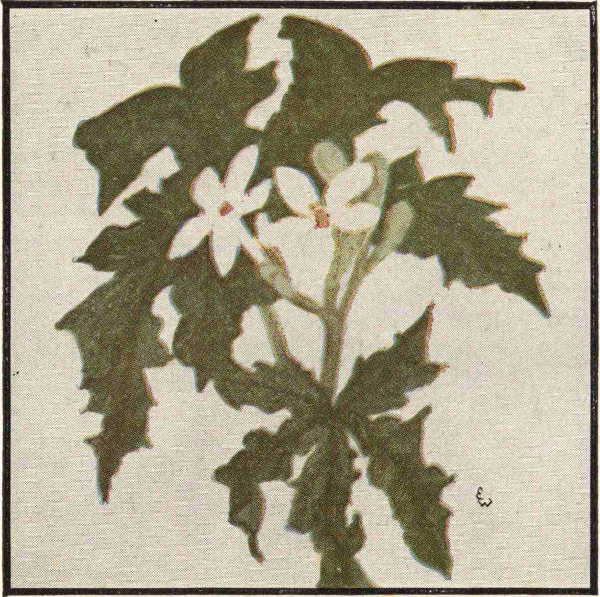
BULL NETTLE
Flowers staminate and pistillate, often borne in an involucre; sepals sometimes reduced or absent; petals usually absent; stamens 1 to 1,000; styles free or united at base; fruit usually a 3-lobed capsule.
Bull Nettle (Cnidoscolus texanus), also called tread-softly, spurge-nettle, and “mala mujer” (bad woman), is a vicious plant thickly clothed with stinging hairs and bearing clusters of tubular white flowers quite similar to the tuberose in appearance and fragrance. The plants grow 2-3 ft. high. The upper flowers bear stamens, and the flowers in the lower forks of the cluster produce seeds. The seed-capsules resemble those of other members of the spurge family in being nearly ball-shaped and deeply three-lobed. The seeds are large, edible, and very palatable. The plants are very abundant in waste places and sandy soil from Texas to Arkansas and Oklahoma, blooming from late spring until fall.
Some familiar commercial products are obtained from members of the spurge family; e.g., rubber, tapioca, and castor oil. In horticulture, the cactus-like spurges and the Christmas poinsettia are well-known favorites. The Chinese tallow-tree (Sapium sebiferum) is used as an ornamental tree, its leaves being very decorative in the fall.
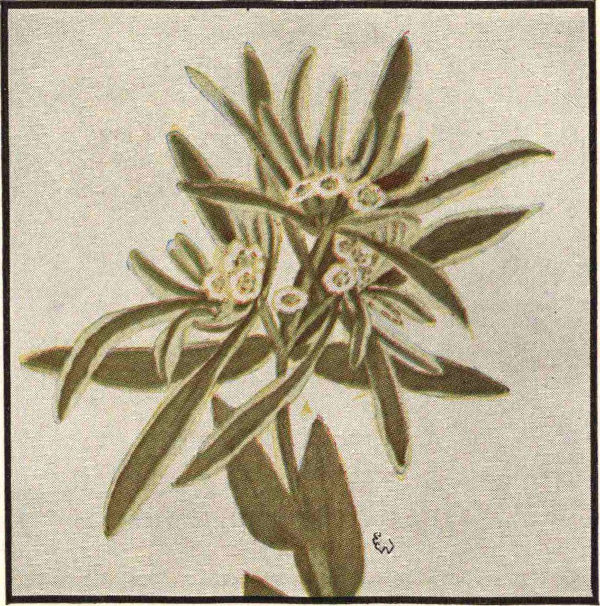
SNOW-ON-THE-MOUNTAIN
Snow-on-the-Mountain. Ghost-Weed (Euphorbia bicolor) grows in great abundance on the plains of Arkansas, Oklahoma, Louisiana, and Texas, being especially thick along dry creek margins. The plants are lovely in late August and September, their showy appearance being due to the green and white leaves surrounding the flower clusters. It bears rather unusual flowers which yield a poisonous honey. The green calyx-like structure is an involucre bearing numerous flowers, each consisting of a single stamen or pistil. Around the top of the involucre are 4-5 small glands each bearing a white appendage which is mistaken for the petals. The cultivated snow-on-the-mountain (Euphorbia marginata) has broader and shorter leaves. It is native on hillsides of Central Texas north to Minnesota.
Texas Croton (Croton texensis) is a weed, 2-3 ft. high, growing in conspicuous masses, particularly in the western part of the state. The flowers are inconspicuous among the gray-green foliage, the widely branched stems bearing numerous linear leaves. The fragrant leaves and stems from some of the crotons are gathered and dried by the Mexicans to use for tea or meat seasoning.
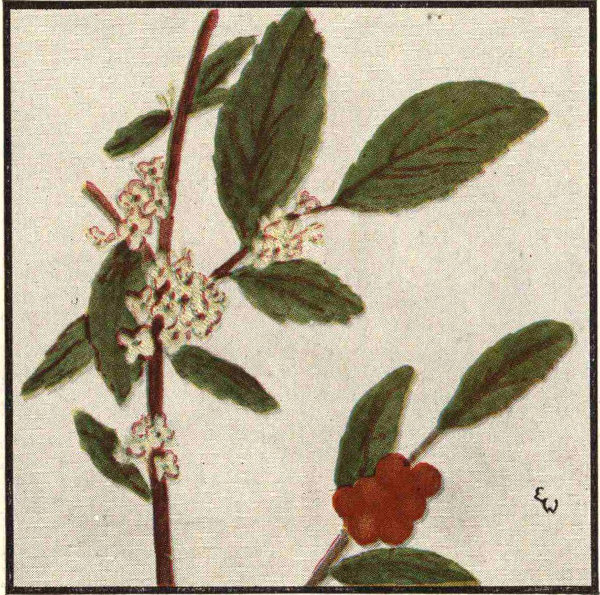
YAUPON
Trees or shrubs, mostly evergreen; sepals 3-6; petals 4-5; stamens 4-5, opposite petals; carpels 3 or more; fruit a drupe.
Yaupon. Cassine (Ilex vomitoria) with dark glossy evergreen leaves and red berries forms lovely hedges along the highways and fields and is scattered through woods in Central and East Texas, ranging to Virginia. The berries, an excellent bird food, usually remain on the shrubs until the small white flowers appear in late March or April. The plant forms a dense widely-branched shrub, which is of slow growth and very desirable for hedges. As the berries are produced on separate bushes from the pollen-bearing flowers, care should be taken to plant those producing berries if ornamental shrubs are desired. Cassine tea is made from the leaves, but it is bitter and contains much caffein and tannin. Like the American holly, which grows in East Texas, the yaupon is being exterminated for Christmas decorations. The deciduous holly (Ilex decidua) has larger leaves, which are shed in the early fall, and larger orange-red berries, which remain on the shrub or tree until late winter.
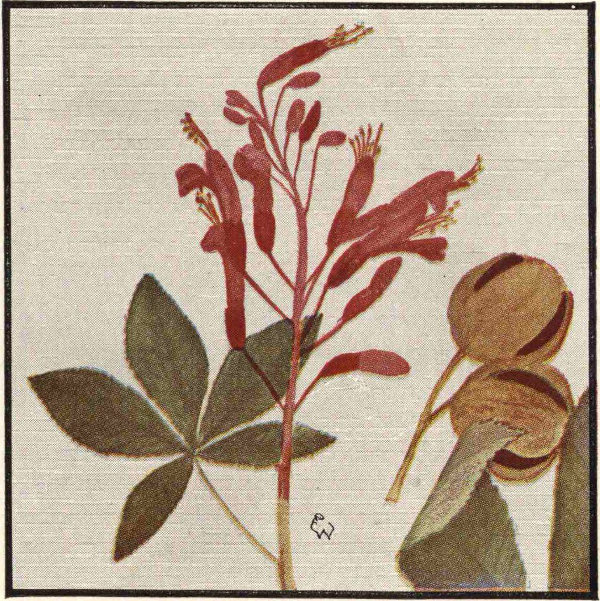
SOUTHERN BUCKEYE
Leaves digitate; calyx tubular, 5-lobed; petals 4-5, unequal; stamens 5-8, inserted on disk; capsules leathery, usually 3-celled; seeds large, shining.
Southern Buckeye (Aesculus discolor) is a handsome shrub or small tree with showy spike-like clusters of deep red or yellow flowers. The yellow-flowered shrub formerly known as Aesculus octandra is now called variety flavescens. The finely-toothed leaves are a glossy dark green above and whitish beneath. The red flowers have a red tubular calyx and 4 red petals, and the yellow variety has all-yellow flowers. Seldom more than 2 large brown seed develop in the 3-lobed leathery capsule.
The seeds and young shoots of buckeyes are usually considered poisonous, those of the horse chestnut (Aesculus hippocastanum) being especially so. Soap may be obtained from the roots and a black dye from the wood.
Western Buckeye (Aesculus arguta) is a yellow-flowered buckeye with leaves divided into 7-9 leaflets. It is found along streams in the western part of the state north to Iowa and Missouri. The buckeyes bloom in March or April. They shed their leaves quite early in the fall and are conspicuous in the winter because of their large buds.
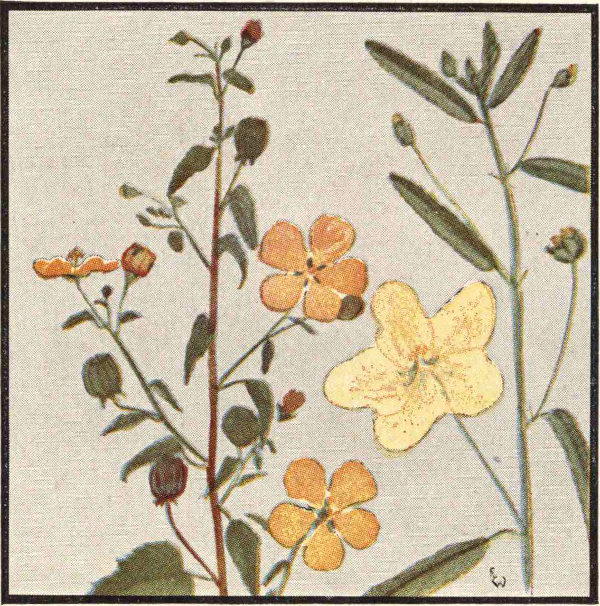
INDIAN MALLOW LARGE-FLOWERED SIDA
Leaves mostly palmately nerved; sepals 3-5, more or less united; petals 5; stamens numerous, united into a column; style branched above.
Indian Mallow (Abutilon incanum) is a much branched plant, commonly 2-4 ft. tall, with rather small ovate leaves, and yellow flowers nearly an inch across. It is a profuse bloomer in the summer and fall. Like other abutilons, it is sometimes called flowering maple because of the maple-like leaves, and may be easily recognized by the seed-capsules, which are about ½ inch high and divided into 7-9 cells. The flowers are typical of the mallow group, having 5 separate petals and numerous stamens united in a tube around the styles. The plants grow in dry soil from Arkansas to Mexico and Arizona.
Large-Flowered Sida (Sida texana) is a common perennial plant in the sandy regions of South Texas. The slender, erect stems bear a few linear-oblong leaves, paler below, and long slender-stalked flowers. The flowers are pale orange-yellow and have the irregularly-lobed petals characteristic of the sidas.
The mallow family includes the commercial plants cotton and okra, and numerous ornamentals, such as hibiscus, hollyhock, and althea.
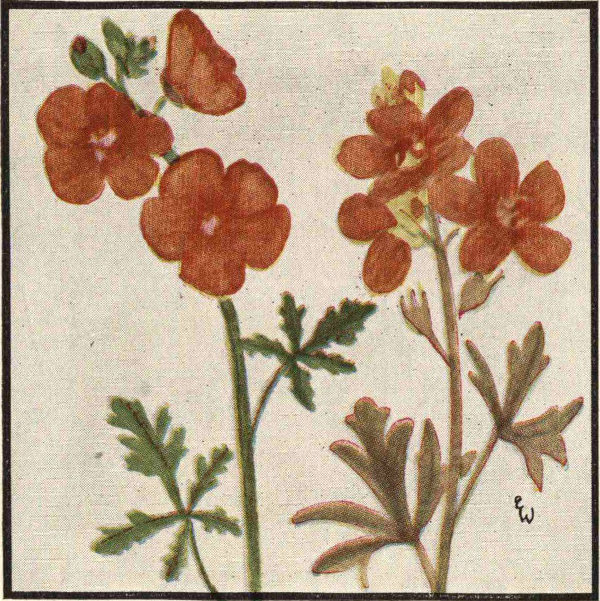
COPPER MALLOW RED STAR-MALLOW
Copper Mallow (Sphæralcea pedatifida) is often confused with the following mallow, but may be distinguished by its thin leaves clothed with a few star-shaped hairs, the 3 linear leaves (bractlets) under the calyx, and the seed capsules, which have one seed in each division completely filling the cell. Both have upper leaves divided into 5 parts and lower leaves into 3 parts. This plant is a low, spreading perennial which forms clumps about 1½ ft. broad. It grows in sandy or gravelly soil, Southwestern Texas, in April and May. Several copper mallows are very abundant in the Southwest.
Red Star-Mallow (Malvastrum coccineum) also has star-shaped hairs on the leaves, but they are very dense and give the leaves a gray, scurfy appearance. The cells are usually 1-seeded with an empty terminal portion above. The plant is also called prairie mallow, red false mallow, and rose moss. It grows in low clumps, spreading or erect, on prairies from Texas to Southern Canada and blooms from May to August.
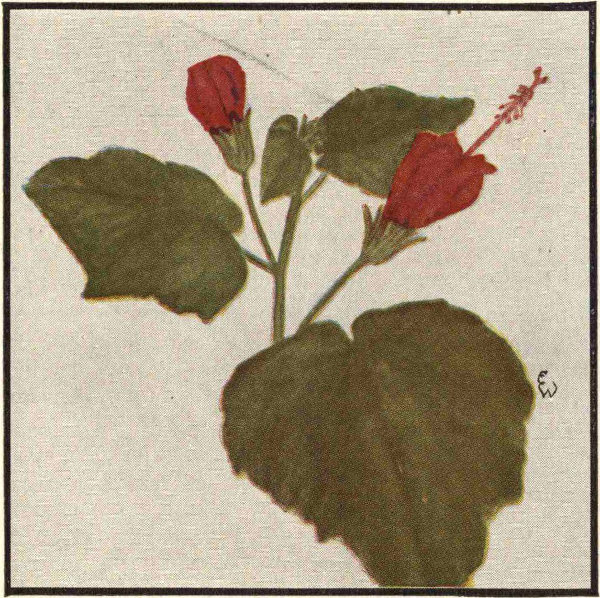
MEXICAN APPLE
Mexican Apple. Turk’s Cap (Malvaviscus drummondii) is also called red mallow. The showy red flowers somewhat resemble a Turkish fez. The broad petals remain closely wrapped around one another at the base but spreading above; the stamen column is conspicuously prolonged beyond the petals. The red apple-like fruits are nearly an inch broad and half as high. They have a delicious flavor and may be eaten raw or cooked. The fruits ripen in the late summer and fall, a few weeks after the blooms appear. They begin to dry soon after ripening and split into sections, scattering the seeds which are borne in the center.
The plants are perennial, the leafy stems branching and spreading, forming a clump which is commonly 2-3 feet high. Growing abundantly in shade along streams in the central and southern parts of the state and in moist woods in East Texas, it ranges from Florida to Mexico. It is a desirable plant for cultivation and is hardier but not as showy, as the large-flowered Turk’s cap (Malvaviscus grandiflora), a Mexican plant now widely cultivated for ornamental purposes in South Texas.
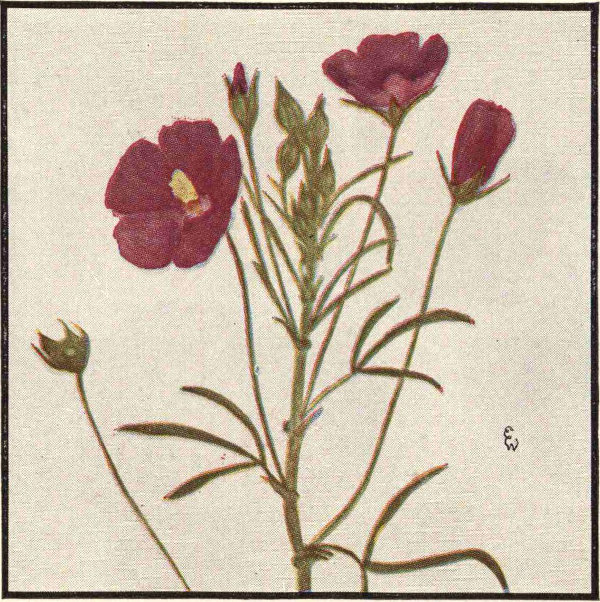
WILD HOLLYHOCK WINE CUP
Wild Hollyhock. Wine Cup. Fringed Poppy-Mallow (Callirrhoë digitata) grows in dry soil from Illinois and Kansas to Texas, blooming in Texas in April and May. It is a perennial, 1-1½ ft. high, with smooth, erect, gray-green stems topped by the flower cluster. The cup-shaped flowers are on slender stalks, the lower longer than the upper. The upper leaves are divided into 1-3 linear divisions and the lower into 5-7 divisions. The petals vary in color from cherry-red to pink and white, often being quite fringed across the top. The slightly yellow stamens are borne in a dense oblong column from which the 10 red styles appear after the flower has been opened several days.
Wine Cup. Red Poppy-Mallow (Callirrhoë involucrata) is the common poppy-mallow throughout the state and ranges from Minnesota to Mexico, a solitary flower standing erect from a prostrate branch. The five-pointed leaves are more or less divided or lobed, sometimes with very linear divisions. Covering acres and acres of the southern coastal prairie in March and April, and more or less common on the drier prairies, this wine cup is a favorite flower. White and pink forms of it exist, but the wine-red color is predominant.
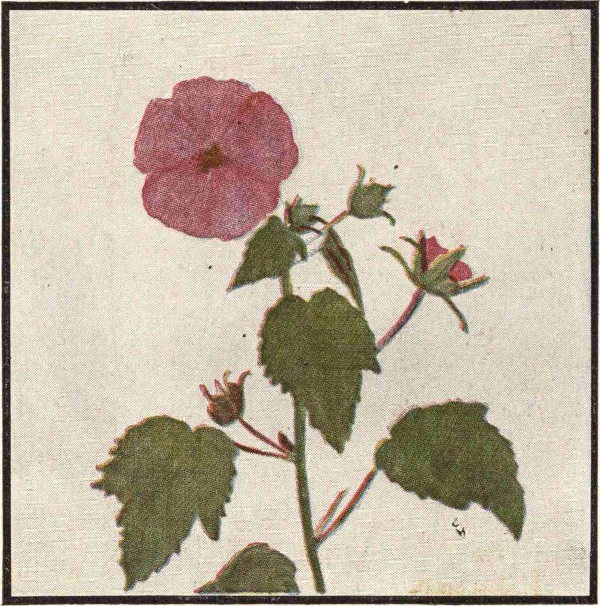
ROCK ROSE. PAVONIA
Rock Rose. Pavonia. Pink Mallow (Pavonia lasiopetala) has attractive, deep-pink flowers, which are broadly spreading, about 1½ in. wide. The plant is branching and shrubby, commonly growing about 2 ft. high, with ovate or rounded leaves 1-2½ in. long. It is not extremely showy but makes an excellent low shrub for the garden and will produce an abundance of blossoms from late spring until fall. It is found in dry, rocky woods from Central Texas to Mexico.
Pavonia gets its name from the botanist, J. Pavon, who worked particularly with South American plants. Several South American species are in cultivation. The Texas pavonia is being introduced in gardens and rivals the shrubby althea as a summer bloomer, but the plants and flowers are much smaller.
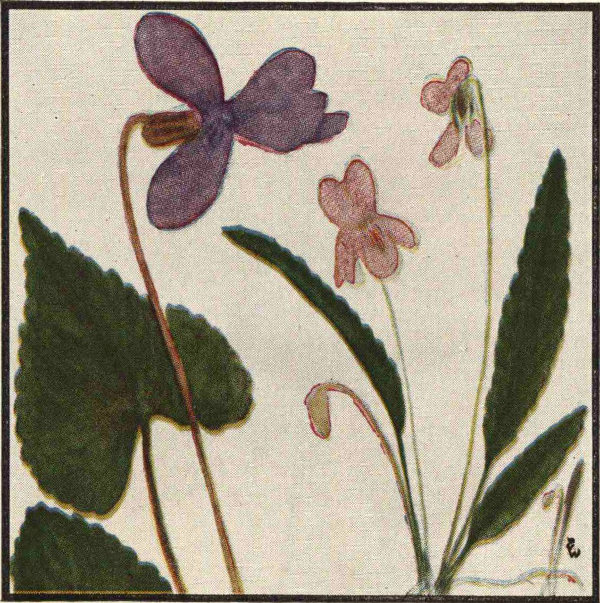
MISSOURI VIOLET LANCE-LEAVED VIOLET
Small or leafy stipules on leaves; sepals 5; petals 5, the lower usually larger and spurred; flowers often cleistogamous; fruit usually a capsule.
Missouri Violet (Viola missouriensis) grows in low grounds and moist woods from Missouri to Louisiana and Texas, the flowers blooming in Texas in March and April. They are very much like the common cultivated violet (Viola odorata) introduced from Europe.
Water or Lance-Leaved Violet (Viola lanceolata) is a small violet found in swampy places in East Texas and north to Nova Scotia. It resembles the white violet, Viola vittata, so abundant on the Coastal Plain, which has narrower leaves and is taller.
About twenty different violets have been reported from the state, mostly from the eastern part. The bird’s-foot violet (Viola pedata) comes into East Texas. It has large flowers, 1-1¾ in. across, the 3 lower petals much lighter than the dark purple upper ones. It resembles the cultivated pansy, which, however, has been derived from Viola tricolor of Great Britain. The native violets bloom from February to May.
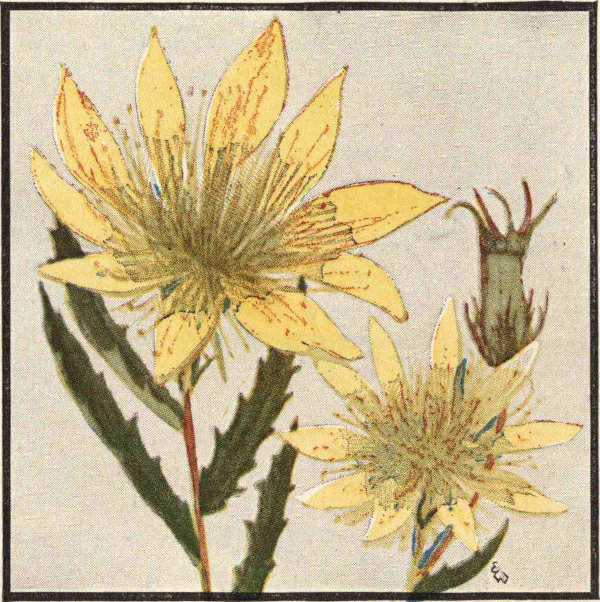
PRAIRIE-LILY STIFF NUTTALLIA
Usually herbs which are clothed with rough, bristly hairs; sepals usually 5, calyx tube joined to ovary; petals usually 5; stamens numerous, the outer petal-like; ovary inferior.
Prairie-Lily. Showy Mentzelia (Mentzelia decapetala) is a handsome-flowered plant which ranges from the Panhandle to Southern Canada. The large flowers, 3-5 inches across, greatly resemble those of the cactus group and have the same tendency to open in the afternoon. The stout, branching plant grows 2-2½ feet high. The stems are quite conspicuous, as they soon become white and shining; the leaves are noticeable because they cling very closely to the clothing by means of barbed hairs. This clinging characteristic is responsible for the Mexican name of “buena mujer” (good woman), applied to this and other similar species.
Stiff Nuttallia (Mentzelia stricta) has smaller, paler flowers, but otherwise it is very much like the showy mentzelia except for the small leaves on the seed capsule. It grows in sandy soil, blooming in the summer and fall. Other common names include stick-leaf, poor-man’s patches, star flower, and good woman. Bartonia aurea of garden culture is a member of the group which was introduced from California.
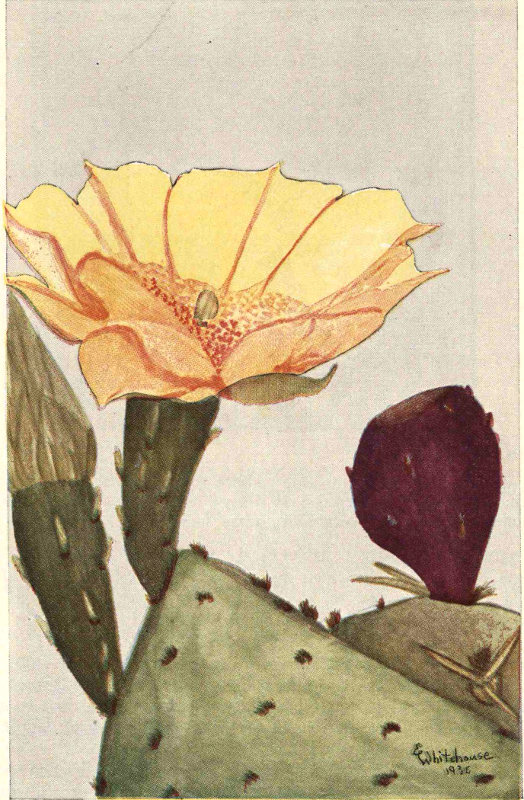
LOW PRICKLY PEAR TEXAS PRICKLY PEAR
Succulent herbs and shrubs; stems usually spiny and leafless; sepals and petals not differentiated, few or many; stamens many; ovary inferior; fruit pulpy, often edible.
Devil’s Tongue. Low Prickly Pear (Opuntia humifusa) grows in dry, rocky or sandy soil from Texas to Missouri, the flowers blooming in May and June and the fruits ripening to a rose-red in the late summer and fall. The flat-jointed stems are often oval but vary in shape and in the number of large spines growing from the spine cushions scattered over the stems. Sometimes no spines are present, but often 1-2 occur along the margins. Numerous short leaves, which are present only in the spring in this and other cacti, grow from the spine cushions. The spine cushions also bear dense clusters of slender, short brown spines. The flowers are yellow with red centers, 3-4 in. broad, widely spreading. Like many other cacti, they open in bright sunlight. The plant is low and has tuberous roots.
Texas Prickly Pear. Lindheimer’s Cactus (Opuntia lindheimeri) has flowers which are yellow upon opening but which take on a lovely saffron-red the next day. Flowers of both colors are often present on the same joint. The large purple pear-shaped fruits are edible and ripen in the summer and fall. The plants often grow in large clumps and attain a great height. The spine cushions of the oval joints bear 2-3 rather short, stout, stiff spines. It is the common prickly pear from Central Texas south into Mexico.
The pencil cactus or tasajillo (Opuntia leptocaulis), conspicuous for its small stems and bright red fruits, is abundant in the state and Mexico. “Cholla,” or walking-stick cactus (Opuntia imbricata), with long slender stems and purple flowers, is common on western plains.
The cactus family has numerous representatives in Texas, but drastic legislation is needed to save some of the natural beauty spots of the western part of the state. The showy “viznaga” or barrel-cactus, used in making cactus candy, is almost exterminated in the vicinity of El Paso; and cactus fanciers are making great ravages on many others. The fruits of many are edible; the young leaves of the prickly pears are cooked for greens; and the stems are used for cattle feed after the spines have been burned.
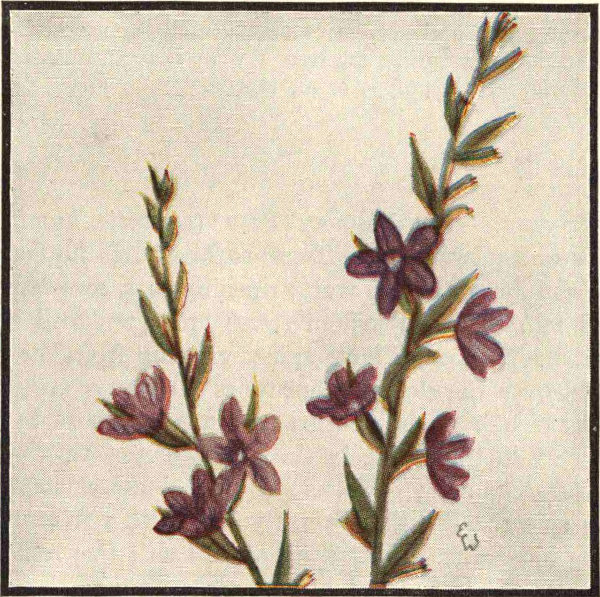
LANCE-LEAVED LOOSESTRIFE
Leaves opposite or whorled; sepals 4-6, united into a tube; petals 4-6, or absent, attached on calyx tube; stamens few or many; ovary superior.
Lance-Leaved Loosestrife (Lythrum lanceolatum) grows in low grounds or swamps from Texas to Oklahoma and South Carolina. The loosestrife family is close kin to the evening-primrose family and has 4-6 petals borne above the seed capsule. “Lythrum” is from the Greek meaning “gore” and refers to the red-purple color of some of the flowers. The common name of loosestrife comes from an old legend that they free from strife. The plant has slender stems 2-4 ft. high and numerous flowers borne in loose spikes. The short, narrow leaves are seldom more than 1-2 in. long. The delicate petals are somewhat darker veined and do not last long. It blooms in the late spring and summer.
Crape Myrtle (Lagerstroemia indica), native of China or India, is widely cultivated in the state and is being planted along highways. It has escaped cultivation in the woods in East Texas. It is a shrub or small tree which is covered during the summer months with a profusion of white, pink, lavender, or rose flowers.
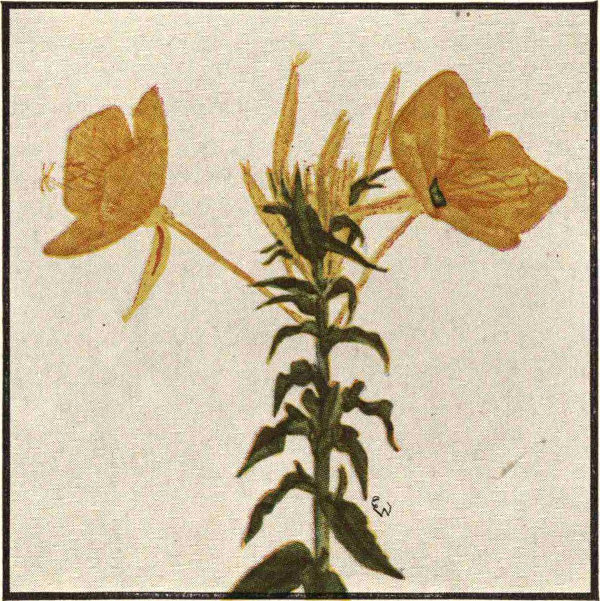
ERECT EVENING-PRIMROSE
Calyx joined to ovary and often produced beyond it; petals usually 4; stamens usually 4 or 8; ovary inferior; seeds numerous.
Erect Evening-Primrose (Œnothera heterophylla) grows in sandy soil in Florida and on the edge of post oak woods in South-central Texas. The plants bloom in April and May. It is very much like the rhombic evening-primrose (Œnothera rhombipetala) but has slenderer, shorter stems and is not often branched. The petals are similar, and their rhombic shape easily distinguishes both of these plants from other evening-primroses. The rhombic primrose grows 2-3 feet high and is very abundant throughout the sandy area of North-central Texas to Minnesota and Indiana.
There are many yellow evening-primroses very much alike in flower which are usually called buttercups, a name first applied to the crowfoots. The flowers usually have four showy petals which last only a day, opening in the late afternoons and closing in the heat of the following day. The seed capsules are usually long and narrow and are borne below the petals. The fireweed is a well-known member of this group. The water evening-primrose (Jussiæa diffusa) is abundant in ponds in Central and East Texas.
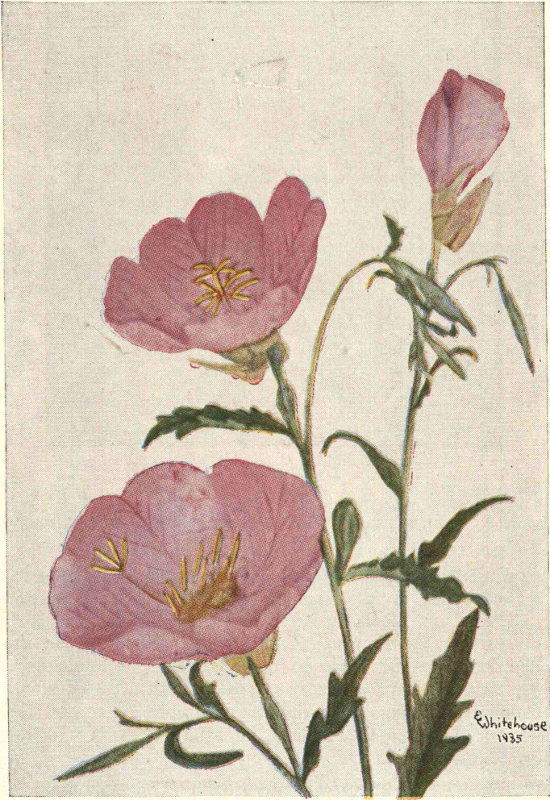
PINK EVENING-PRIMROSE
Pink Evening-Primrose. Pink Buttercup (Hartmannia tetraptera) blooms best in April, but a few scattered plants may continue to bloom through the summer months. It is a perennial plant which does well in cultivation. White, pink, blush, and other shades were introduced by Childs in 1892 from seeds collected in Texas and were known as the Mexican evening-primrose.
The earlier flowers are usually much larger than those which bloom late in the season. The flowers are cup-shaped, 2-4 inches broad, with 4 broad petals marked with deeper-colored veining and greenish-yellow at the base. The sepals are united into a narrow tube above the seed capsule and below the petals. This tube is about as long as the capsule, sometimes a little shorter. The sepals do not overlap, are slow about splitting, and are pushed to one side of the flower by the opening petals. The seeds are borne in a club-shaped capsule which is prominently ridged, the slender base being as long as the enlarged seed-bearing portion.
The stems are usually trailing and branched at the base, sometimes forming clumps two or more feet broad. The leaves are quite variable in shape but are generally oblong and narrowed at the base, with margins ranging from entire to deeply lobed and divided.
The group name honors Emanuel Hartmann of Louisiana; “tetraptera” is from the Greek meaning “four-winged” and refers to the shape of the seed-capsule. The plants in this group are sometimes placed with the yellow evening-primroses of the Œnothera group, but characteristics other than color separate them.
Showy Primrose (Hartmannia speciosa) is a large-flowered white primrose found on plains and prairies from North Texas to Missouri. The seed-capsules are narrowed at the base but are not stalked, and the calyx tube is longer than the capsule.
Rose Primrose (Hartmannia rosea) is a small-flowered primrose found in Southern and Southwestern Texas and Mexico. The flowers are small, an inch or more broad, with rounded deep-pink petals. The calyx tube is much shorter than the long-stalked capsule.
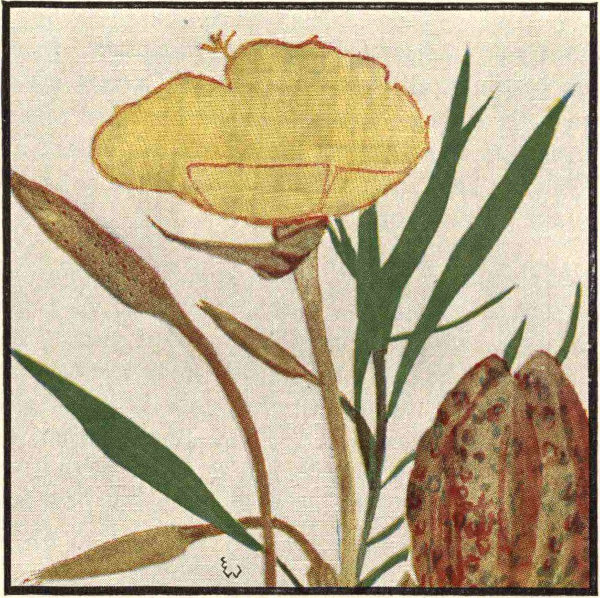
FLUTTER-MILL
Missouri Primrose. Flutter-Mill. Broad-Winged Evening-Primrose (Megapterium missouriense) clings to the side of a gravelly cliff or grows on rocky limestone hillsides from Missouri to Colorado and Texas. The flowers bloom in Texas in April and May, opening in the afternoon and closing the next morning. The plants grow in low clumps about a foot high. Numerous flowers are borne on the stem along with the slender leaves. Four broad yellow petals make up the cup-shaped portion of the flower above the slender calyx-tube, which is 4-6 in. long. The seed-capsules at the base of the flower develop four broad papery wings and reach at maturity a width of 3 in. These broad wings are responsible for the scientific name of the plant. The capsules are easily blown about by the wind, and the seeds are widely scattered.
The evening-primroses usually produce large, thready masses of pollen. Every child is initiated into a buttercup fraternity at some period in his life by being invited to smell of the flower and having his nose smeared with the profuse pollen.
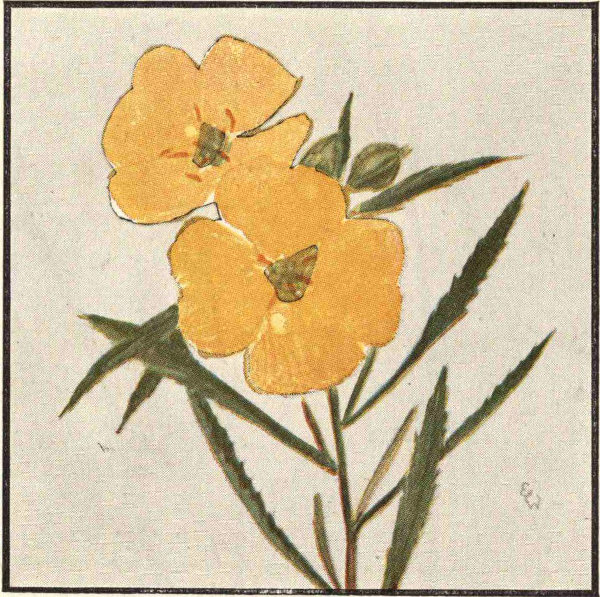
SQUARE-BUD PRIMROSE
Square-Bud Primrose. Day Primrose. Creamcups (Meriolix spinulosa) has yellow cup-shaped flowers which last only twenty-four hours but which are open during the day. It may readily be distinguished from other evening-primroses by the slender woody stems which soon become reddish or straw-colored. The stems grow 1-1½ ft. high with clusters of flowers at the top. The flowers are nearly two inches broad and have four petals. The short, broad sepals are winged on the back and make the buds appear square and pointed.
Another distinguishing feature is the disk-shaped stigma which is sometimes yellow and sometimes black or dark brown. In the evening-primroses previously mentioned, the stigma is divided into four narrow lobes. The plants grow on gravelly hillsides from Arkansas to Mexico. The slender capsules are over an inch long. Several other day primroses are found in the state. They are all sometimes grouped with the œnotheras.
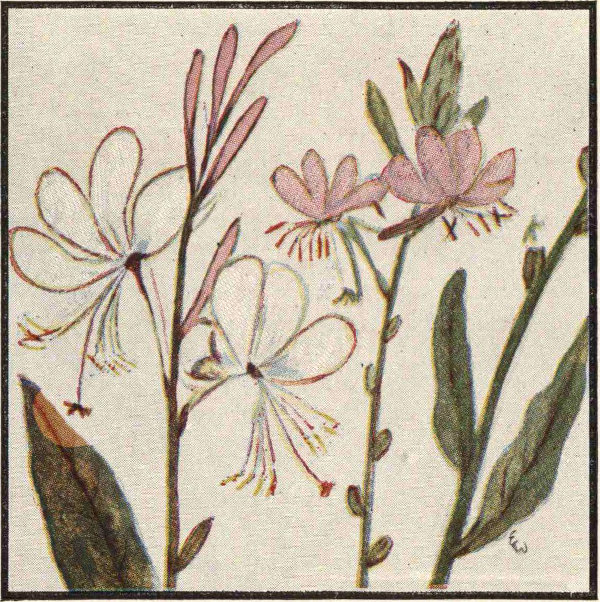
LARGE-FLOWERED GAURA WILD HONEYSUCKLE
Large-Flowered or Lindheimer’s Gaura (Gaura lindheimeri) is, like other members of this group, called kisses and wild honeysuckle because of its sweet fragrance. Most of them produce an abundance of nectar and make excellent honey plants. This is the handsomest member of the group in Texas and is known in cultivation as a hardy plant. It is native to the prairies of Southeast Texas and Louisiana and blooms from March to May.
The four white petals have the group characteristic of turning fan-wise toward the upper side of the flower, and the 8 long stamens and the long style hang toward the lower part. Only a few flowers open at one time around the spike, but numerous buds are densely crowded above the open flowers. This plant has erect-ascending branches and grows 2-5 feet high.
Prairie Gaura. Wild Honeysuckle (Gaura brachycarpa) sometimes grows 2-3 feet high, but is usually much lower. With favorable rains, the flowering spikes grow quite long. This gaura may be recognized by its stalkless 4-angled seed capsules. It blooms on Texas prairies in April and May. Many other gauras are found in the state.
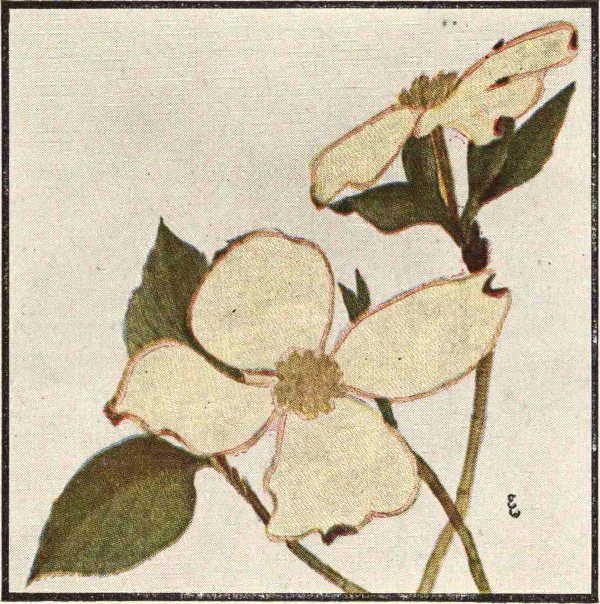
FLOWERING DOGWOOD
Leaves usually opposite; sepals usually 4, calyx tube joined to the ovary; petals usually 4, or absent; stamens 4, alternate with the petals; ovary inferior; fruit a drupe.
Flowering Dogwood (Cornus florida) grows from Massachusetts to Ontario, Texas, and Mexico, but few people realize that it grows very luxuriantly and is widespread in the woods of East Texas. The beauty of the dogwood is not in the flowers, as one might expect, but in the four broad white floral leaves (bracts) which surround the flower-cluster. These bracts are a creamy white but are often tinged with pink. The minute greenish-white flowers have four petals and bloom in March before the leaves appear. The oblong scarlet fruits, about half an inch long, ripen in the fall.
It is said that dogwood gets its name from the fact that the bark of an English dogwood was used to treat mangy dogs. Another source for the name is given in a recent magazine which shows a photograph of a section of wood from a dogwood tree. By means of the growth rings of the tree, the section depicted the head of a swimming dog. Among the useful substances obtained from the tree are quinine from all parts, scarlet dye from the bark, and wood for tools. Enough quinine is obtained by chewing the twigs to ward off malarial fever.

SMALL-FLOWERED DOGWOOD
Rough-Leaved Cornel. Small-Flowered Dogwood (Cornus asperifolia) is hardly recognized as a dogwood because it does not have showy floral bracts. The rough leaves become very lovely in the fall as the veins take on a reddish-purple color. It is a very common shrub in thickets along streams or in moist ground from Texas to Southern Ontario. The flowers bloom in Texas from April to June, and the white fruits mature in the fall. The fruits are about ¼ inch in diameter and contain 2 seeds with a stony coat which is covered by a thin pulp.
The dogwood family includes several other trees and shrubs which are common in Texas. Black gum (Nyssa sylvatica) has 2-3 blue oval fruits about half an inch long in a cluster. It is one of the first trees in East Texas whose foliage takes on an autumnal coloring. Lindheimer’s garrya (Garrya lindheimeri), an evergreen shrub with thick leathery leaves, is very abundant in the hills of Central and West Texas. It bears dense clusters of small blue berries less than ¼ inch in diameter.
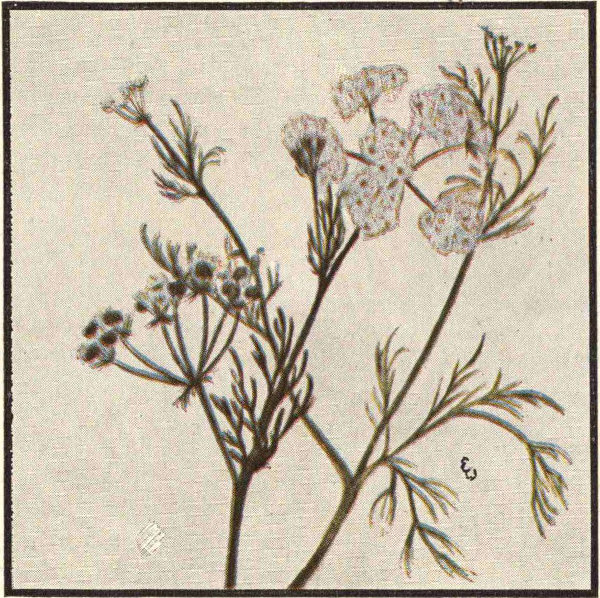
PRAIRIE LACE
Furrowed stems; leaves usually much divided, sheathing at the base; sepals 5, calyx tube joined to ovary; petals 5; stamens 5; ovary inferior; fruit 2-celled, prominently ribbed and often with resin canals.
Prairie Lace. Dwarf Queen Anne’s Lace (Bifora americana) is the pride of the North Texas prairie in late April and May. It is also found in Oklahoma and Arkansas. In favorable seasons it grows in great masses with the Indian blankets and the false coreopsis. The umbrella-clusters of white flowers are very showy. The plants do not have oil tubes, as do most members of the carrot family, and so lack the strong scent common to many.
It usually grows about a foot high and is widely branched at the top. The leaves are finely divided with numerous thread-like divisions. The flowers are one-fourth inch broad and have five notched petals which are broader than long. The fruits have two ball-shaped divisions, each about one-eighth inch in diameter and faintly ridged.
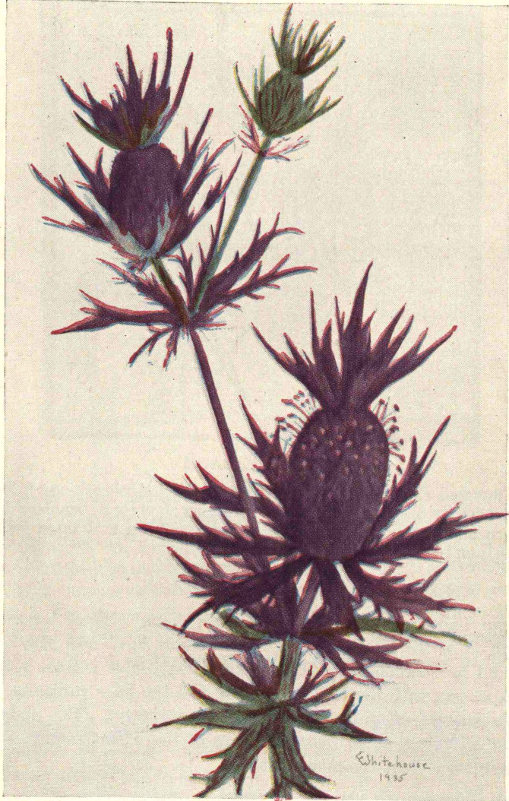
FALSE PURPLE THISTLE. ERYNGO
False Purple Thistle. Eryngo (Eryngium leavenworthii) is not a true thistle, but it is popularly known as one. The ancient Greeks had the same idea, for the name “Eryngium” is their name for a kind of thistle. Correctly speaking it is a purple carrot, as it belongs to a large group of the carrot family, some of which are widely cultivated abroad for their striking purple foliage. The flowers are clustered in an oblong head, quite different from the dainty flower clusters of Queen Anne’s lace. Other common names of this group include sea-holly, rattlesnake master, and button snake-root, the two latter from their accredited property of curing snake-bites. Candelabrum plant is a name sometimes given which is very appropriate because of its branching habit of growth.
The plants grow one to three feet high, usually in dense masses along roadsides and fields and on prairies from Central Texas to Kansas. In August the gray-green foliage of the plants is quite conspicuous against darker greens, but it gradually takes on a royal purple hue. Few plants can rival it for beauty in late August and September. The dense heads of purple flowers with their long, slender dark-blue stamens add to the vividness. The dried plants are often kept for winter decoration, but the purple does not remain so intense.
The stems are branched at the top, the flower heads growing on short stalks in the forks of the branches. The deeply lobed leaves clasp the stem, the leaf segments bearing many spiny-teeth. A tuft of small, rigid, spiny leaves grows out of the top of the flower head.
Several eryngoes are found in the state. The yucca-leaved eryngo (Eryngium aquaticum) grows in the summer in sandy areas or low grounds from Texas to Minnesota and Connecticut. It bears little resemblance in habit of growth or coloring to the purple thistle. Most of the long leaves are clustered at the base, and a stout flower stalk bears at the top several head-like clusters of white flowers.
The carrot family is a large group of plants, most of which have lacy, fern-like leaves and dainty umbrella-clusters of small flowers and fruit which separates into two ribbed 1-seeded divisions. The plants are usually rich in oil tubes, and some contain deadly poisons.

BEGGAR’S TICKS
Beggar’s Ticks. Seed-Ticks. Bird’s Nest Carrot (Daucus pusillus) is probably more familiar in fruit than in flower. The clusters of seeds resemble a bird’s nest. The fact that the seeds are covered with several rows of barbed prickles makes them very difficult to remove from clothing. Their presence in wool renders it inferior in quality. It is very abundant throughout the state from April to June and occurs in most of the Southern and Western States.
The small white flowers grow in a dense, lace-like cluster at the top of slender stems 1-2 ft. high. The leaves are finely divided. The flower cluster is long-stalked and is surrounded by a circle of the green leaves; thus the flowers as well as the seeds have a nest-like appearance.
Wild Carrot. Queen Anne’s Lace (Daucus carota), the ancestor of the garden carrot, was introduced from Europe and may be found in scattered places over the state. It is a larger plant than the beggar’s ticks, with very wide-spreading and dainty flower clusters. It does not bloom until summer.

WILD DILL
Wild Dill. Prairie Parsley (Pleiotaenia nuttallii) is a conspicuous plant on prairies throughout the state and ranges to Michigan and Alabama. The flowers bloom in April and May, and the seeds mature and fall in June and July. The stiff, stout stems, commonly two feet high, become dry and brown but remain standing through the winter months. The upper leaves are not divided so much as the lower, which are deeply divided and have broad segments. The flowers are small and greenish-yellow and grow in clusters about 2 inches broad.
The foliage and seeds were used for seasoning by pioneers. It is very much like the cultivated dill (Anethum graveolens), a native of Southeastern Europe. The latter is taller and has leaves with threadlike divisions.
Other well-known members of the carrot family include the parsnip, parsley, myrrh, chervil, caraway, and celery. The well-known poison hemlock (Conium maculatum), by which Socrates met his death, is a native of Europe but may now be found in North and South America. It grows in great abundance along the streams of the Edwards Plateau between Fredricksburg and Austin.
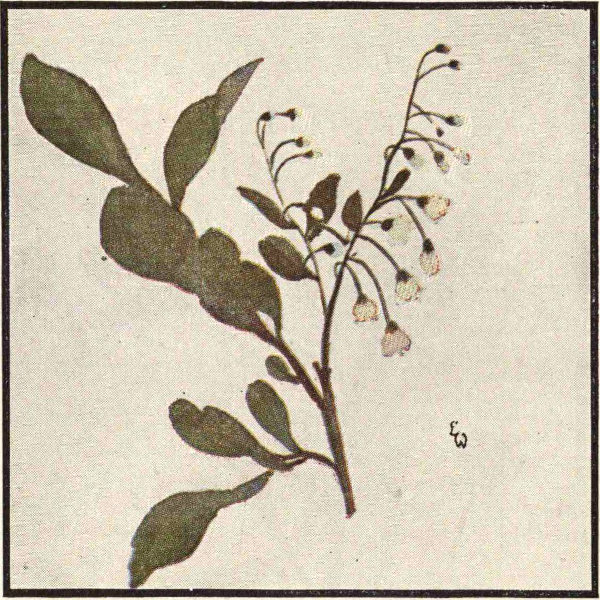
TREE-HUCKLEBERRY
Herbs or shrubs; sepals 4-5; corolla urn-shaped or cylindric, 4-5-lobed; stamens 8 or 10; anthers opening by terminal pores; ovary superior or inferior.
Tree-Huckleberry. Farkleberry (Batodendron arboreum) is also known as upland-huckleberry, sparkleberry, and gooseberry. The name is Greek and means “blackberry tree.” The huckleberries are often placed in a family separate from other heaths. The tree-huckleberry is a shrub or small tree, very abundant in the woods of East Texas and the Southern States. The dainty, drooping sprays of white bell-shaped flowers remind one of the lily-of-the-valley. The shining oval leaves are short-stalked, 1-2 in. long. The black berries are not edible.
Well-known members of the heath family include the trailing arbutus, cranberry, blueberry, bean-berry, winter-green, rhododendron, and azalea. Thickets of the pink azalea or swamp-honeysuckle (Azalea nudiflora) occur in a few places in East Texas. In the mountains of Southwest Texas may be found the arbutus-tree, madroña, or naked Indian, so called because of its red wood and scaling bark. Its small, red fleshy fruits look like strawberries. Stagger-bush (Neopieris mariana) is a common shrub in swampy places.
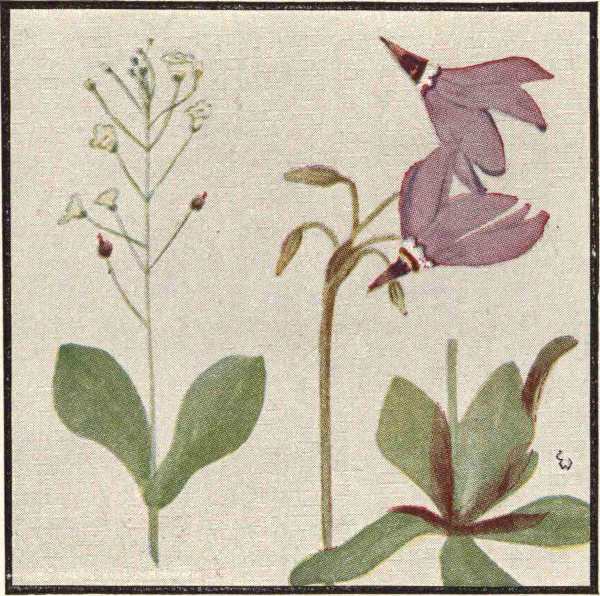
TEXAS WATER-PIMPERNEL SHOOTING STAR
Leaves often basal; sepals usually 5, often leafy; corolla tubular, 5-lobed; stamens 5, opposite the petals; ovary superior; fruit a capsule.
Texas Water-Pimpernel. Brookweed (Samolus cuneatus) is a plant found wherever springs or moist ledges occur in limestone hills of Texas. The plants have a basal rosette of broad rounded leaves. The slender stems are 6-12 inches high and bear a few leaves which are narrowed at the base. The 5-lobed white flowers are short and bell-shaped and appear from April to September. The pink water-pimpernel (Samolus ebracteatus) grows in sandy soil along the coast.
Shooting Star (Dodecatheon stanfieldia) is a rare plant and should be afforded protection. It is found in rich, moist soil from Central Texas to Louisiana. The flowers are very much like those of Dodecatheon meadia but are larger and have broader petals.
The primrose family is represented in horticulture by many primroses from Asia, cyclamens from Greece to Syria, and the cowslip from Europe. The scarlet pimpernel (Anagallis arvensis) is found on sandy prairies in South Texas in the spring.
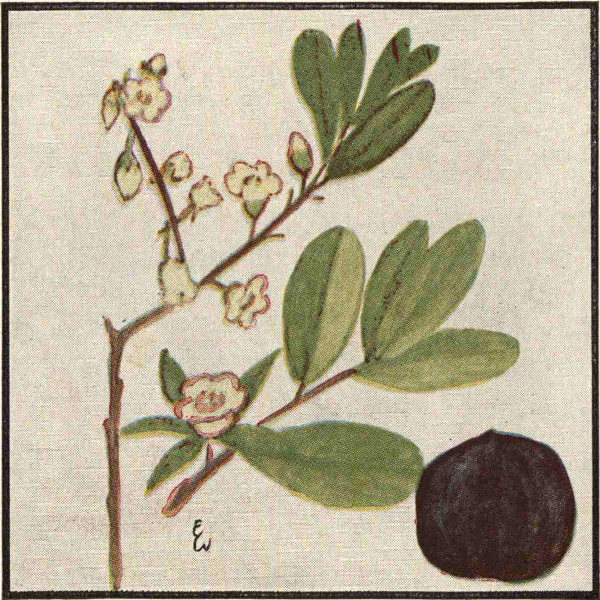
MEXICAN PERSIMMON
Trees or shrubs; leaves usually leathery; calyx 3-11-lobed; petals united, 3-7; stamens 6-14, or more; ovary superior.
Mexican Persimmon (Diospyros texana) is also called ’possum plum, “chapote,” and black persimmon. It is a shrub or small tree found in river-valleys and on limestone hills from Central Texas to Mexico. It may be easily recognized by its smooth, light-gray bark, small leaves, and creamy heath-like flowers. The bell-shaped flowers are in dense clusters on the tree which has pollen-bearing flowers, whereas the seed-bearing flowers, which grow on a separate tree, are larger and fewer in number. The black fruits ripen in August, when the pulp becomes juicy but somewhat insipid.
The black wood is hard and, like other species of ebony, takes an excellent polish. It is used for making tools. The Mexicans use a black dye obtained from the fruits in dyeing sheep-skins. The common persimmon (Diospyros virginiana) is found wild from Connecticut to East Texas, where the sprouts are vicious pests in plowed lands.
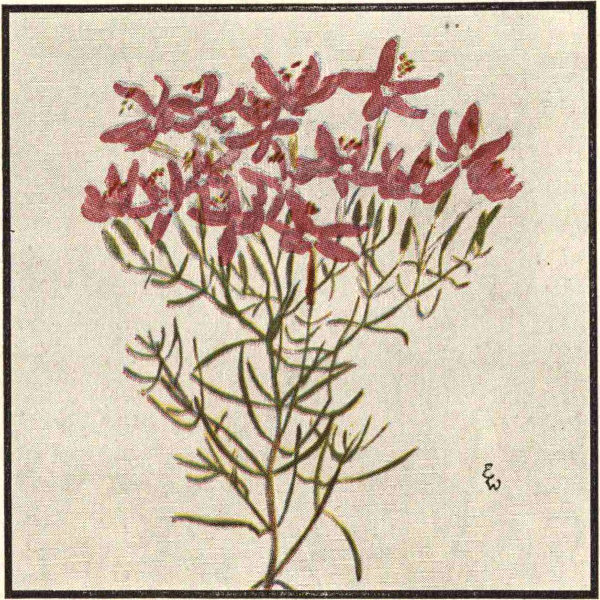
MOUNTAIN PINK
Leaves opposite; calyx usually tubular, 5-lobed; petals united at base, 4-12; stamens as many as petals; ovary superior.
Mountain Pink. Showy Centaury (Erythraea beyrichii) grows on gravelly limestone hills in Texas and Arkansas. The stems are branched near the base and often form hemispherical clumps a foot in diameter which are covered with pink flowers in June. The plants are being rapidly exterminated for ornamental purposes, for they are very showy and the flowers will last two weeks or more. The flowers have a united tubular corolla with 5 lobes.
The scientific name is from the Greek meaning “red.” The flowers of some species are red, but those in Texas are pink. The Texan centaury (Erythraea texense) is a very small plant with small flowers. It is found from Texas to Missouri in June and July. Buckley’s centaury or pink gentian (Erythraea calycosa) is found in moist soil in the western part of the state. It is a tall, slender plant 1-2 ft. high. It ranges from Missouri to Mexico. The centaury plants were formerly valued as a medicine for fever. They were gathered and dried at flowering time.
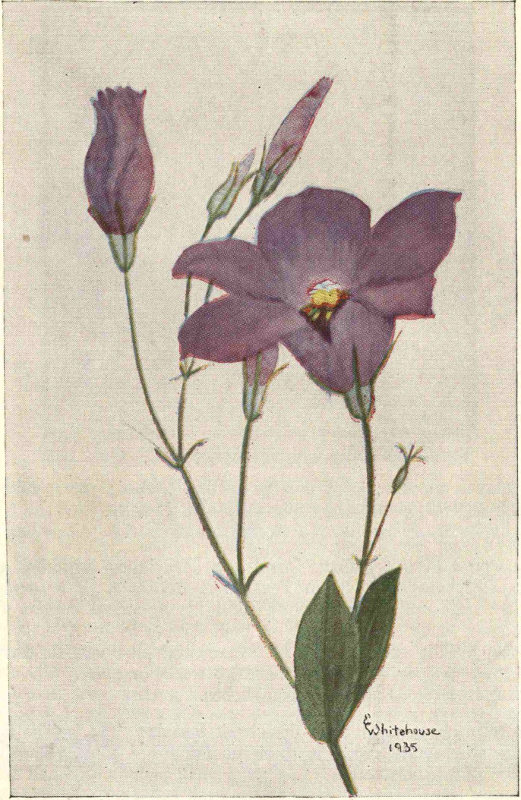
PURPLE GENTIAN. BLUEBELL
Purple Gentian. Bluebell (Eustoma russellianum) is also called Russell’s eustoma, Texas bluebell, blue gentian, blue marsh lily, and bosque blue gentian. The latter name is used in El Paso, where the purple gentian grows on the flood plain of the Rio Grande River. It is one of the loveliest flowers in the state, sometimes occurring in great profusion on moist prairies from Mexico to Colorado and Louisiana. It is especially abundant in Southeast Texas, where it is gathered in wholesale quantities by florists. It is an excellent cut-plant, the flowers lasting for several days and new buds continually opening.
Few people have had success in transplanting the purple gentian into their gardens. Only recently has there been a report of seeds successfully germinated. It is said that soaking for 48 hours in water will produce germination. Each flower produces a number of very minute seeds.
The large, bell-shaped flowers, 2-3 inches broad, are a bluish-purple; in fading, they spread widely and take on more of the blue tinge. They are constricted into a short narrow tube at the base. Inside, the flowers are marked with yellow at the base and have purple markings in the throat. The five stamens with large anthers are attached to the corolla tube. At the time the pollen is shed, the anthers lie in a horizontal position around the style. The stigmas are interesting. There are two diamond-shaped lobes which are erect until they are ready to receive pollen, and then they take a horizontal position. The calyx has five linear lobes which are united at the base with a colorless membrane. The oblong capsules are about half an inch long.
The plants are very smooth and are erect, with a few erect branches. The leaves are ovate-oblong and are usually 1-2½ inches long.
“Eustoma” means “open mouth”, referring to the large throat of the flower. The smaller bluebell in Southern Texas and Northern Mexico is Eustoma gracile.
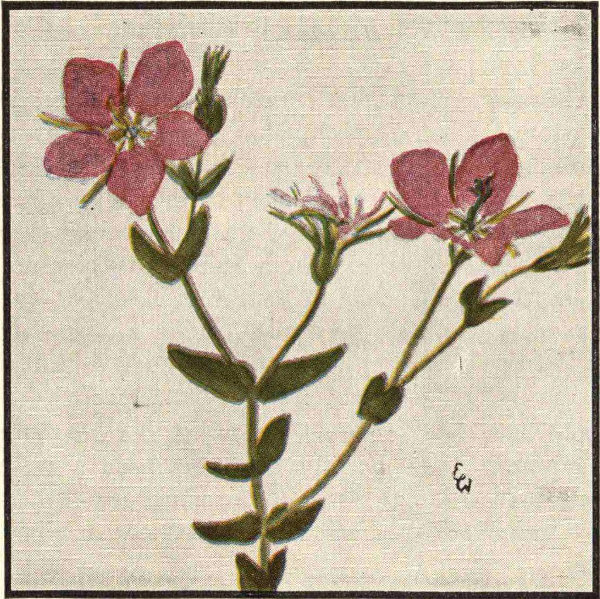
PINK TEXAS STAR
Pink Texas Star. Prairie Sabbatia (Sabbatia campestris) is also known as meadow pink, rose pink, pink prairie gentian, marsh pink, and sea star. It ranges from Missouri and Kansas to Texas and is found on moist prairies throughout Central Texas from April to June. It is particularly abundant on southern coastal prairies where it makes a showy landscape display with phlox, coreopsis, and other plants in March and April. The sabbatias are named in honor of two Italian botanists, L. and C. Sabbati.
The plants are low, 3-12 inches high, and have wing-angled stems and short smooth leaves about ½-1¼ inches long. The flowers are about 1½ inches broad, much larger than those of the mountain pink, and more cup-shaped. They are usually deep pink in color, but purplish-pink and white forms may occasionally be noted. Around the throat are yellow, star-shaped markings over the white base of the petals. The long, linear calyx lobes are quite conspicuous when the flower is in bud or after the corolla has wilted.
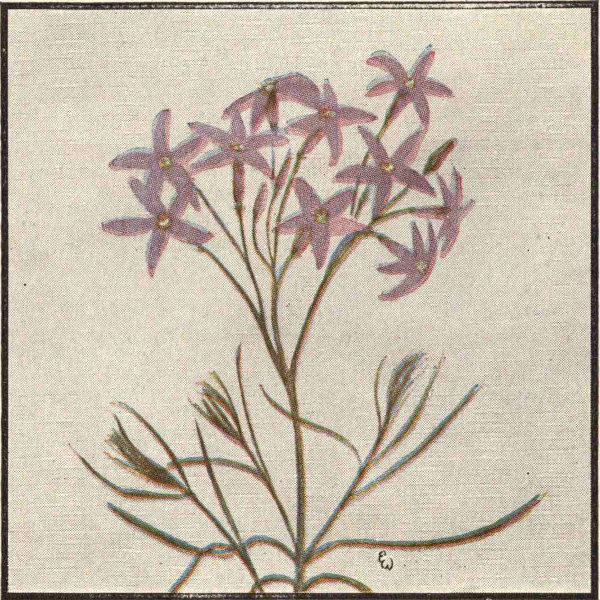
BLUE TEXAS STAR
Plants with milky juice; sepals usually 5; corolla tubular, 5-lobed; stamens usually 5, inserted on corolla tube and alternate with the lobes; ovary superior; fruit mostly of 2 spreading follicles.
Blue Texas Star. Texas Dogbane. Blue-Star (Amsonia texana) belongs to a group named in honor of Charles Amson, a colonial physician. The stems are usually unbranched, 8-12 inches high, and are covered with narrow linear leaves. Like that of other amsonias, the tubular throat is lined with white hairs. The name of twin-pods might be given to the amsonias. The numerous seeds are borne in two narrow, erect pods which are united at the base and split along the inner sides. The pods are 3-4 inches long. The plant is perennial, growing in low clumps on limestone hillsides of Texas. The plants in North Texas form a conspicuous bluish-green line on low hills, when the flowers bloom in late March and April.
The oleander, periwinkle, and vinca are well-known members of the dogbane family. They all have a milky sap which is quite poisonous in the oleander, Indian hemp, and others. “Bane” is the common word in Northern Europe for “murderer” and is applied to poisonous plants.
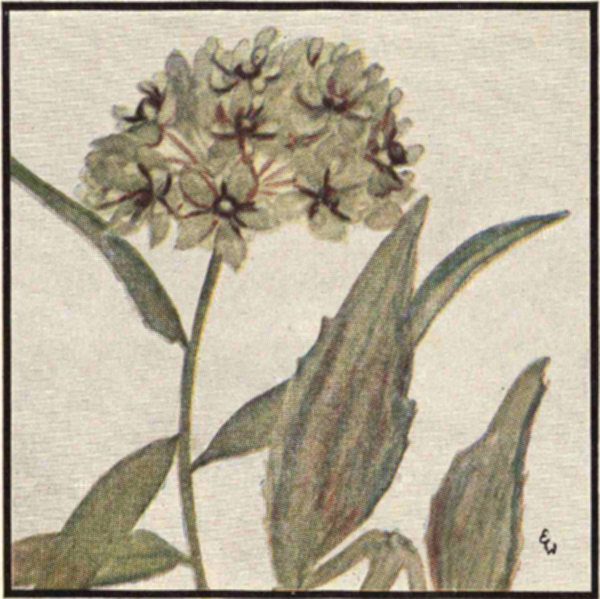
GREEN-FLOWERED MILKWEED
Leaves usually opposite or whorled; sepals 5; petals 5, usually reflexed and with a 5-lobed crown; stamens 5, the pollen united into 1 or 2 waxy masses in each sac; carpels 2, free except for the united disk-like stigma.
Green-Flowered Milkweed. Silkweed (Asclepiodora decumbens) is a widespread plant from Arkansas to Utah and Northern Mexico. It is found on the central and western plains, blooming in early spring and sometimes again in the fall. The stout, leafy stems, topped by the ball-shaped heads of flowers form conspicuous clumps about a foot high. The flowers have a sweet nectar which draws many insect visitors. They bloom in April and early May, and the large warty pods mature in a few weeks. As the seeds bear a tuft of hairs at one end, they are easily scattered by the wind and other agents. It is one of the first plants to appear on burned-over areas.
The milkweeds get their name from the bitter milky sap. The flowers are quite different from other flowers in that there is a crown between the petals and the stamens. In many the pollen is borne in two pear-shaped masses with a thread-like connection. In the green-flowered milkweed, purple hoods are attached to the crown and hang over the pollen-sacs.
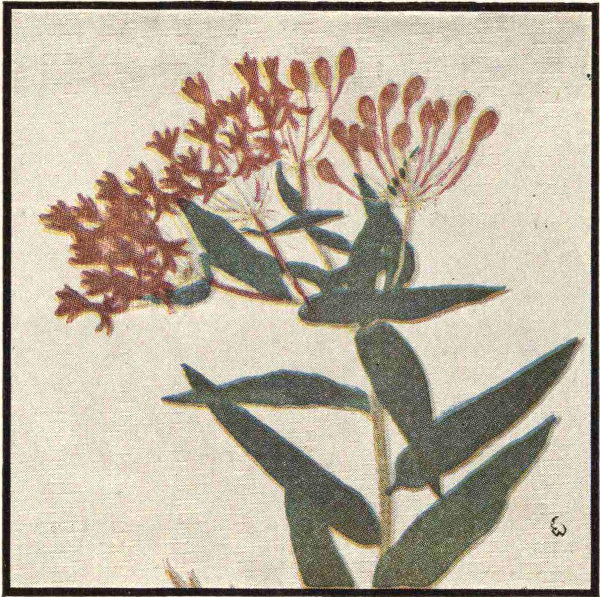
BUTTERFLY-WEED
Butterfly-Weed. Pleurisy-Root (Asclepias tuberosa) is a well-known plant in dry fields from Maine and Ontario to Northern Mexico. In Texas it is found in the sandy areas of the eastern and central parts. It blooms in the late spring and summer. Other common names include orange milkweed, orange-root, Indian posy, and orange swallow-wort. The leaves are poisonous to stock, but the honey is not considered poisonous. The monarch butterfly is a voracious feeder on the plant. It was at one time valued for its medicinal properties, but is now little used. Several plants are known by the common name of “swallow-wort” and are so called because they bloom in the spring when the swallows appear.
The leafy stems often grow one to two feet high. At the top of the stem are several clusters of small orange-colored flowers. The petals hang down when the pollen is ready to be shed. There is a crown of five erect, orange-colored hoods around the flat stigma.
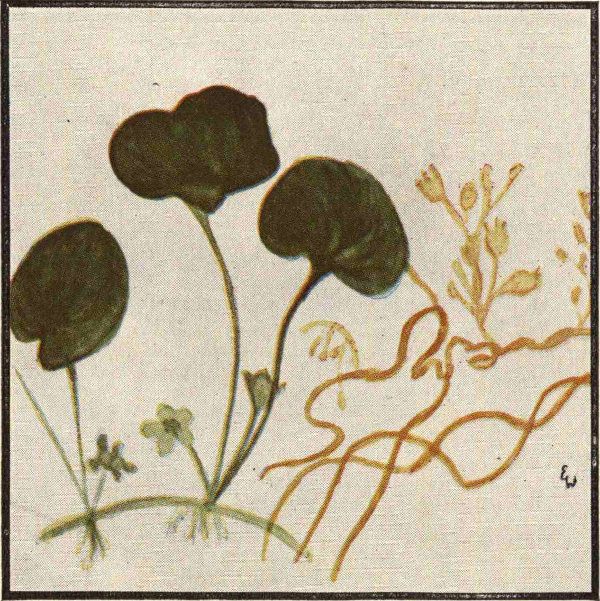
CAROLINA DICHONDRA PRETTY DODDER
Herbs with creeping stems; sepals 5; corolla bell-shaped, 5-lobed; stamens 5; carpels 2, separate.
Carolina Dichondra. Ground Ivy (Dichondra carolinensis) is, of course, not even kin to the ivy, but it does form a green carpet over the ground in places. It is widely scattered in the state and in many other localities. The greenish-white flowers are small and inconspicuous under the round leaves and are almost buried in the soil. The leaves are about an inch broad and are slender stalked. The plant is a perennial which is often hard to remove from lawns. The silvery-leaved dichondra (Dichondra argentea) occurs in West Texas.
Pretty Dodder. Love Vine. Strangle-Weed (Cuscuta indecora) may be noted in conspicuous orange or gold masses covering other plants. It is a leafless parasitic vine bearing small clusters of white flowers. The flowers are less than one fourth inch broad and have the petal-tips turned inward. There are many dodders in the state, and each kind is parasitic only on certain plants. The pretty dodder attacks the wild verbena and other herbs and low shrubs from Illinois to Texas and other parts of America.
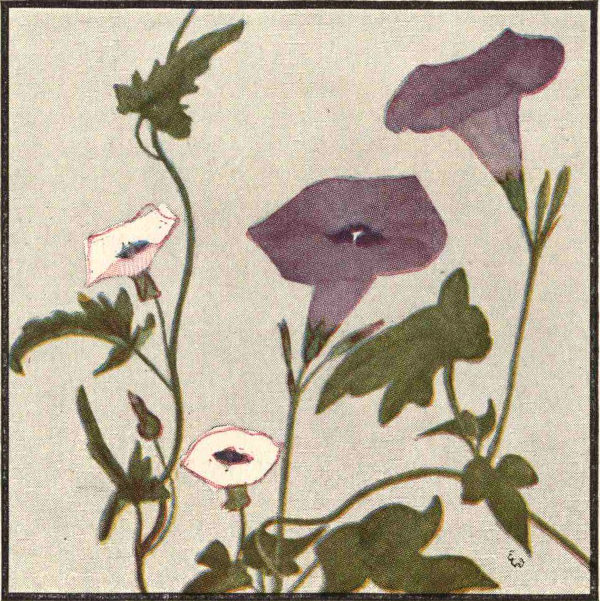
TEXAS BINDWEED PURPLE MORNING-GLORY
Plants twining or erect; sepals 5; corolla mostly funnelform, 5-lobed; stamens 5, on corolla tube; ovary superior; fruit usually a ball-shaped capsule separating into 2-4 lobes.
Texas Bindweed (Convolvulus hermannioides) has small white morning-glory flowers with a dark-red center. They are seldom more than an inch broad. The spreading or twining vines reach a length of several feet. The leaves are very variable in shape and often have spreading lobes at each side of the base like the hoary bindweed (Convolvulus incanus). Both grow on Texas plains, but the hoary bindweed is widely distributed from Kansas and Arkansas to Mexico. The Texas bindweed may be distinguished by the ear-like projections at the base of the sepals. The flowers bloom from April to August.
Purple Morning-Glory. Bindweed. Tie-Vine (Ipomoea trifida) is a lovely but pernicious vine of Texas, Mexico, and tropical America. The roots are perennial and very difficult to eradicate from cotton and corn fields. It blooms from spring to fall, the flowers opening only in the morning. The morning-glory group is very large, and many showy forms are found in Texas. The sweet potato (Ipomoea batatas) and others are valued for their tuberous roots.
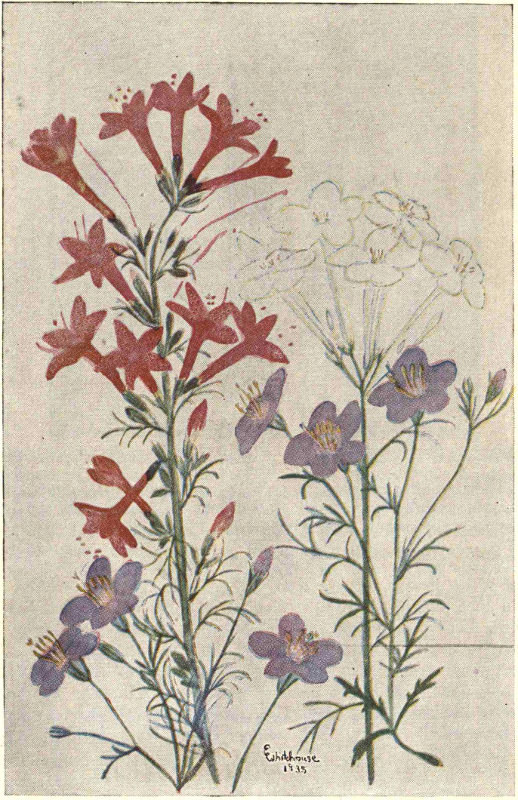
STANDING CYPRESS BLUE GILIA WHITE GILIA
Mostly annual and perennial herbs; calyx 5-lobed; corolla tubular, 5-lobed; ovary usually 3-celled; style often 3-parted; stamens 5, inserted on corolla-tube; capsules small.
Standing Cypress. Red Gilia (Gilia rubra) might also be called torch flowers, for the tall spikes with their masses of red tubular flowers make flaming spots of color on the edges of the post oak woods in May and June. It is sometimes known as Indian plume, Texas plume, or red Texas star.
The plants are usually unbranched and grow two to three feet high; however, if the top of the stem is removed or injured near the time of flowering, it will branch into several flowering spikes. The stems are pale green and quite leafy with the finely dissected leaves. The narrow tubular flowers are over an inch long and have broad spreading lobes which, on their inner surface, are a pale orange-red dotted with a darker red. The flowers, which resemble those of the cypress vine, are closely clustered on the stem, those at the top opening first. The capsules are nearly an inch long and contain numerous papery seeds.
Blue Gilia. Golden Eye (Gilia rigidula), differing markedly from the red gilia in the shape of the flowers, has a short, broadly flaring corolla with a conspicuous yellow center. The flowers are nearly an inch broad. The plants are perennial and are often widely branched at the base, forming clumps nearly a foot broad. The blue gilia is found on hills and stony plains from Central Texas to Mexico and New Mexico and blooms from March to October.
White Gilia. Long-Flowered Gilia (Gilia longiflora) has slender, erect stems, 1-2 feet high, terminated by a flat-topped cluster of tubular white flowers. The flowers have a narrow tube, about 1½ inches long, and 5 broad, spreading lobes. The leaves have threadlike divisions. The plants are very showy when they are in bloom and are especially abundant in sandy regions of Northwest Texas in the late summer and fall.
Few flower groups show such a decided red, white, and blue as the gilias. The group is a large one, mostly of Western North America, and is named in honor of the Spanish botanist, Philipp Salvador Gil. Some of the gilias are known in cultivation and are considered hardy plants of easy culture. The standing cypress may be grown from seeds planted in August or September, or plants may be transplanted in the spring.
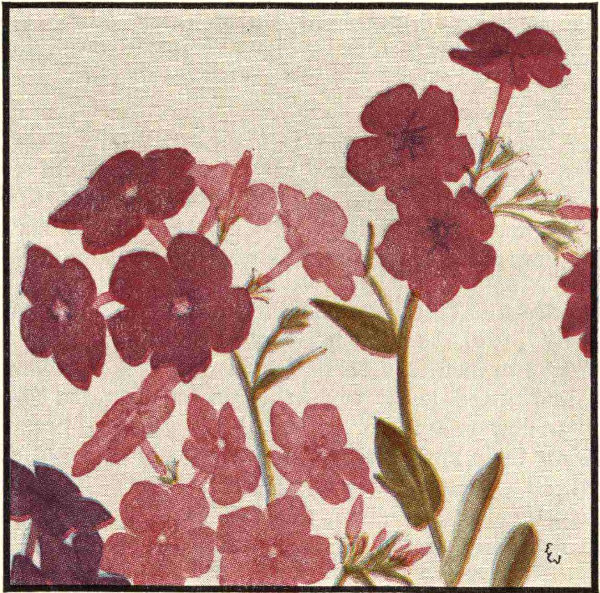
DRUMMOND’S PHLOX
Drummond’s Phlox (Phlox drummondii) has rightly been called “Texan pride.” A drive late in April through the post oak sandy region east of Austin to the Brazos River and southeast to Victoria will disclose it in all its glory. The seeds were collected by Thomas Drummond in 1834 and sent to W. J. Hooker in the spring of 1835. Hooker, an eminent botanist, described it from the plants grown from those seeds in the Kew Gardens in London. According to his description, the plants were mostly of a brilliant rose-red with more or less purple in the flowers of some plants and darker red eyes in nearly all. It is quite probable that Drummond collected his seeds in the vicinity of Gonzales, the western limit of his Texas trip, where today wild phloxes which match his description occur in great profusion. The seeds collected may have included some from hybrid plants, as red phloxes with a white eye are found on the eastern edge of the red-phlox area, and the dark-eyed purple and red are found on its western limits in close proximity to the “phlox purple” variety.
The plant has long been a horticultural favorite, and more than 200 varieties have been described, few of which excel the native varieties in size or coloring.
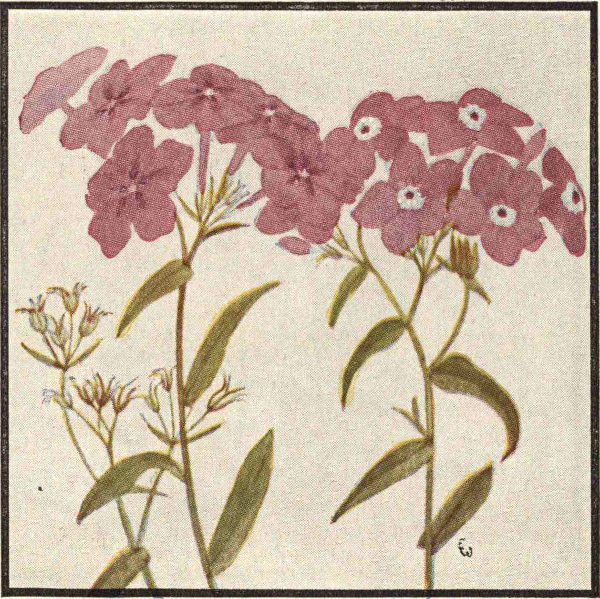
PURPLE PHLOX
Purple Phlox (Phlox drummondii-purple varieties) grows in sandy soil in Central Texas. The variety with the white throat and red-star eye is common in the southeastern part of the state. It is especially abundant in Wilson and Karnes Counties, where extensive masses of purple may be noted in open sandy places among mesquite and post oak trees. This is a very vigorous phlox and produces large stems and flowers. Studies are being made to determine whether these purple phloxes are varieties of Drummond’s phlox or should be called by other names.
The variety with the purple throat and the two white marks at the base of each corolla lobe grows northwest of the range of the red-flowered Drummond’s phlox. It blooms from April to June and seems to withstand cold better than any of the annual phloxes except the dwarf phlox.
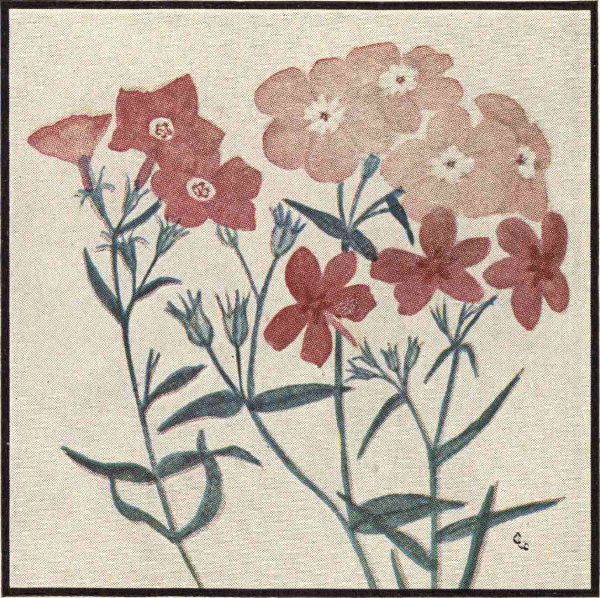
HELLER’S PHLOX BERLANDIER’S PHLOX THARP’S PHLOX
Berlandier’s Phlox (Phlox glabriflora) differs from Drummond’s phlox in many particulars. The flowers are usually a bluish-lavender which at a distance suggests the wild verbena. Like the other phloxes on this page, it has both stem and leaves clothed with scattered, long, soft hairs. The large corolla is marked with white at the base of the lobes and has a short, smooth tube. The vigorous plants branch profusely and often form masses two and three feet broad. This phlox may be found on sandy prairies south of Kingsville and west of Hebbronville in the winter and spring months but is at its best in February and March. It was first collected by Louis Berlandier at several places along the southern coast in 1828 and 1829.
Heller’s Phlox (Phlox helleri) is a close relative of Berlandier’s phlox but has a hairy corolla-tube, smaller flowers, and shorter leaves. It is found from March to May in sand near the coast around Copano, Aransas, and Nueces bays.
Slender Phlox (Phlox tharpii) has a long, hairy corolla-tube, and the slender stems are usually unbranched. Only four flowers are borne in a cluster. It is very abundant in Frio and Dimmit Counties in April. Theodore Roosevelt, in describing a peccary hunt south of Uvalde in April, 1904, mentions these fields of purple.

ROEMER’S PHLOX DWARF PHLOX
Roemer’s Phlox (Phlox roemeriana) has lovely flowers which vary in color from deep rose to phlox purple or pink. It is the only annual phlox marked with yellow around the eye or throat. Its large capsule, containing 12 or 15 seeds, is another conspicuous feature and shows its relationship with the perennial phloxes of West Texas. It forms a lovely display with bluebonnets and low prairie spider-worts in the limestone hill region in April and early May.
Dwarf Phlox (Phlox tenuis) is the smallest and most widely distributed of the annual phloxes, ranging from the south-central coast to Louisiana and into Southern Oklahoma. It is found on the coastal prairie and in sandy soil along the edges of post oak woods from March to May. The plants are usually six to eight inches high and unbranched, but branched varieties are known. The flowers are about half an inch broad, with narrow lobes which are marked with two reddish-purple lines at their base.
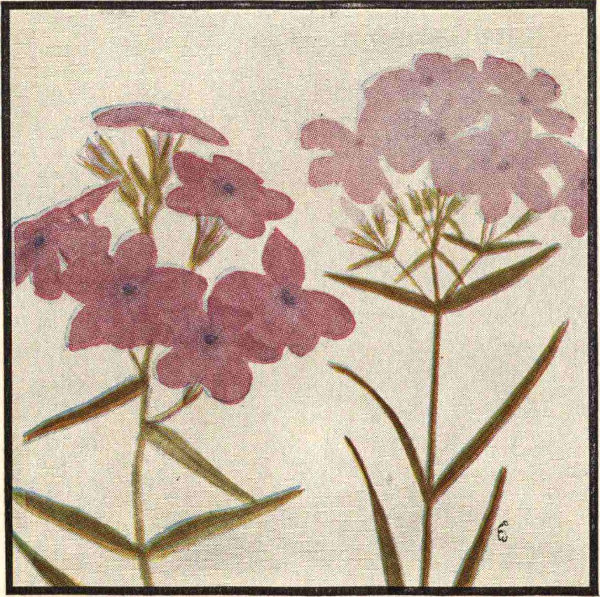
LARGE-FLOWERED PRAIRIE PHLOX PRAIRIE PHLOX
Prairie Phlox. Prairie Sweet William (Phlox pilosa) has a delightful fragrance common in lesser degrees to many of the phloxes. The widespread prairie phlox was named in 1753 from plants taken to France from Virginia. The stems are low and have a few opposite leaves which are pointed and widely spreading. The flat-topped clusters of pale pink, blue, white, or purple flowers bloom in March and April in Texas. The stems and flower clusters are clothed with soft hairs.
Large-Flowered Prairie Phlox (Phlox villosissima) grows in a strange environment for a phlox. Charles Wright found it in 1849 on the gravelly bars of the Nueces River, where it still grows. It is also found on other rivers in Southwest Texas. It has long, woody roots reaching toward the necessary moisture. The flowers are very large, and only a few are open at a time. It differs from the prairie phlox in its shorter and more numerous leaves, its larger flowers with their broader lobes, and alternate branches in the flower cluster. The prairie phloxes are perennial and are easily grown in Southwest gardens.
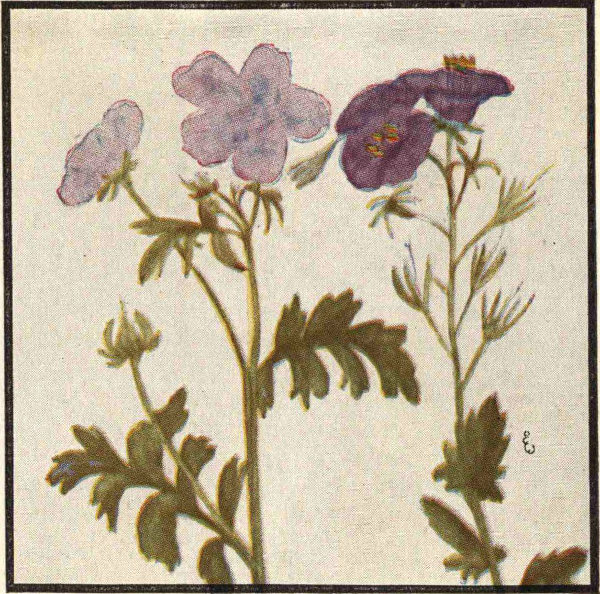
BABY BLUE-EYES PURPLE PHACELIA
Flowers usually in curled clusters; calyx deeply 5-lobed; petals united, usually 5; stamens 5, on corolla-tube; ovary superior; styles 2.
Baby Blue-Eyes. Flannel Breeches (Nemophila phacelioides) forms a lovely carpet on banks and in moist woods near the prairie regions of Texas and Arkansas. The dainty flowers are about one inch broad, with 5 broadly-spreading lobes of lavender, paler at the base. The leaves are divided into 5-9 broad segments which are irregularly toothed. It is not known in cultivation, but a similar plant from California is used to cover beds in which bulbs are planted.
Purple Phacelia (Phacelia patuliflora) is a low, spreading annual growing on sandy prairies in the southern part of the state. “Patuliflora” means “spreading flower” and refers to the royal purple corollas which are widely spreading and nearly an inch broad. It is the handsomest phacelia among the fifteen or more species found in the state. It blooms from February to May.
Blue nama (Nama ovatum) is a water-leaf growing in ponds and streams of East Texas and blooming in the summer. It has lovely sky-blue flowers nearly an inch broad and spiny stems. Sand bells (Nama hispidum) has small, reddish-purple, bell-shaped corollas.
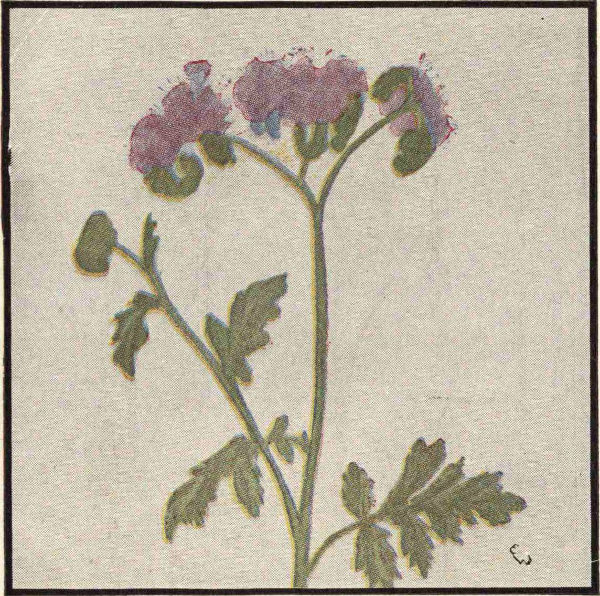
BLUE CURLS
Blue Curls. Fiddle-Neck (Phacelia congesta) is also known as spider-flower, caterpillars, snail-flower, and wild heliotrope. It has curled flower clusters and lavender-blue flowers very much like those of some of the heliotropes and borages. A California borage is also called fiddle-neck. The flowers are tubular at the base with 5 broadly spreading lobes. The 5 spreading stamens extending from the flowers are responsible for the name of “spider-flower.”
The erect, unbranched stems may be seen on gravelly limestone slopes or in open woods from Central to Southwestern Texas. The large, thin leaves are finely divided and clothed with soft hairs. In woods the plants may grow 1½-2 ft. high, but on rocky slopes they are seldom more than a foot high. The flowers bloom in April and May, a long blooming season resulting from the numerous flowers which open as the curling stems unfold. It is an annual plant which does well in cultivation and makes a lovely addition to the flower garden.
Nearly a hundred phacelias are found in Western North America. The name is from the Greek meaning “cluster.” Most of them are showy plants, but few are known in cultivation.
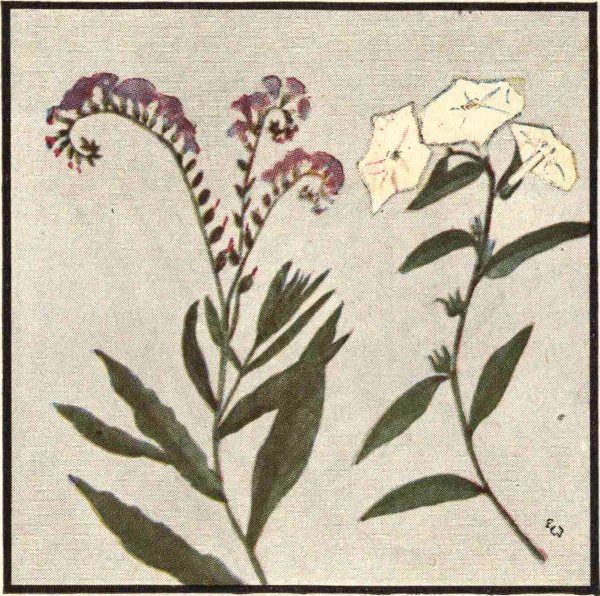
SOUTHERN HELIOTROPE BINDWEED HELIOTROPE
Leaves usually alternate; flowers often in curled clusters; sepals 5; petals 5, united; stamens 5, on corolla-tube; ovary often deeply 4-lobed; fruit a drupe or of 4 nutlets.
Southern Heliotrope (Cochranea anchusaefolia) grows in limestone soil from Central Texas to Florida and tropical America. It may often be found from spring to fall in the shelter of mesquite or prickly pear. The white-flowered sea-heliotrope (Heliotropium curassavicum) is very abundant in saline soil in South and West Texas. Plains heliotrope (Heliotropium tenellum) does not have curled clusters of flowers but has a few small white ones borne on short branches. It is widespread in the South-central United States.
Bindweed Heliotrope (Heliotropium convolvulaceum) has white flowers quite similar to those of the bindweed, about one inch broad. It is found in sandy soil in South and West Texas to California and Nebraska from spring to fall. The plant has widely branching stems, about a foot long, and the foliage is somewhat rough-hairy. The heliotropes get their name from Greek words which mean “sunturning.”
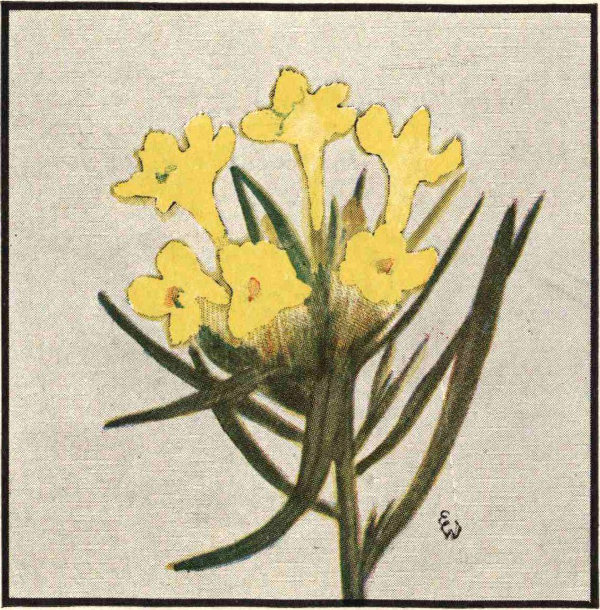
GOLDEN PUCCOON
Golden Puccoon. Narrow-Leaved Puccoon (Lithospermum linearifolium) is another harbinger of spring on the prairies. The scattered plants may be found throughout Texas to British Columbia and Indiana. Several slender stems grow from a long, thick black root. The plant gets its name from the Greek word meaning “stone-seed” and refers to the hard nutlets of the fruit. In the narrow-leaved puccoon, the nutlets are ovoid, white, shining, and more or less pitted. The flowers have a narrow tube with 5 spreading lobes which have crinkled margins.
Orange Puccoon (Lithospermum gmelinii) is a striking woodland plant of the Eastern States which is widespread in East Texas. It can be easily identified by its showy yellow-orange flowers. The clustered stems, 1-1½ feet high, grow from a deep root. It blooms in April and May.
Most of the puccoons have a red root from which a dye is obtained. Some of the European forms have blue flowers and are known in cultivation.
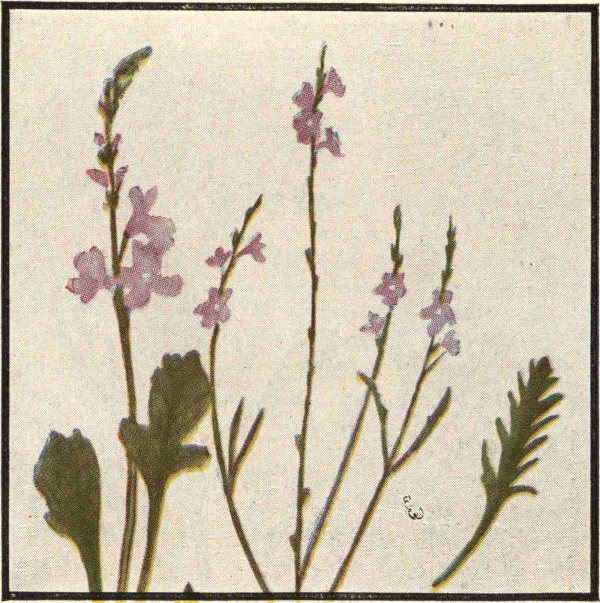
LARGE-FLOWERED VERVAIN SLENDER VERVAIN
Branches often 4-angled; leaves opposite; flowers often whorled; calyx 5-lobed; petals 4-5, united; calyx and corolla often 2-lipped; stamens 4, on corolla-tube; ovary often 4-celled.
Slender Vervain (Verbena halei) was, until a few years ago, considered the same as the European vervain (Verbena officinalis), but it is now recognized as a different plant. Misty-looking purple patches on the roadside ahead usually turn out to be masses of the slender vervain. It is a perennial which takes on renewed blooming activity from early spring until fall, but usually only scattered plants bloom after June. It is very abundant in this state and other Southern States.
The flowers are small and scattered along the slender branches at the top of the stem. The upper leaves are narrow, those of the mid-stem divided; and the lower are broad and irregularly toothed.
Large-Flowered Vervain (Verbena plicata) shows some variation in color from white to lavender, the flowers commonly being a bluish-lavender. The flowers are about half an inch broad and grow in long showy spikes. The plants are perennial, and numerous stems form erect clumps 1-2 ft. high. It is especially handsome southwest of San Antonio and ranges into Mexico. It blooms from February to May.
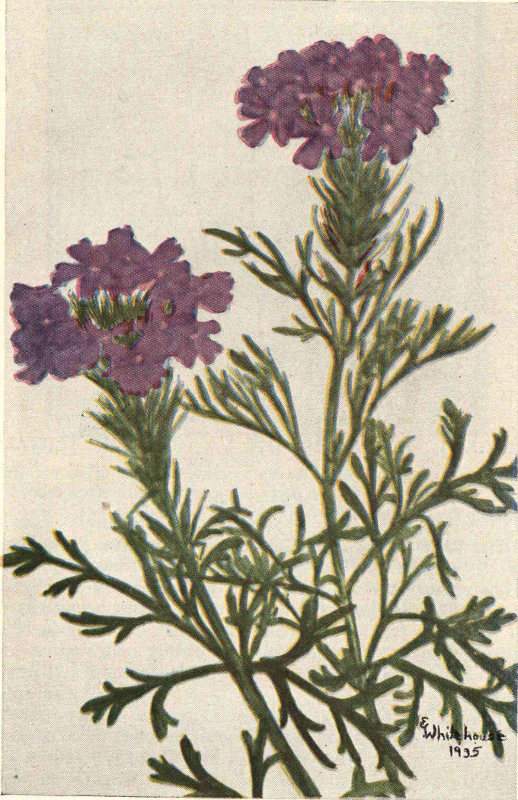
PLAINS VERBENA
Wild or Plains Verbena (Verbena bipinnatifida) is sometimes called sweet William, a name which properly belongs to the blue woodland phlox (Phlox divaricata) or to the clove pink. There is only a faint fragrance to the wild verbena.
Along highways and in the fields the wild verbena blooms in great profusion from spring until the plants are killed by a severe freeze. The flower stalks often grow quite long and are topped by a flat cluster of flowers around the new buds. The old calyx tubes surrounding the small nutlets remain on the stalk for many weeks. Children delight in pulling off the purple tubular corollas so that they can suck the abundant nectar from the tube and then string them together for a necklace, which they make by inserting the base of one tube into the throat of the adjoining corolla.
The wild verbena is a perennial plant with many prostrate branches. The leaves are thick, rough, and divided into narrow segments. It is one of the most familiar plants of the South Plains region, ranging from Missouri and Arizona to Northern Mexico. It is seldom used in gardens, but it is one of the plants used by the highway department for roadside planting. Where it has been used in gardens for low border mass effects, it has been a delight throughout the warm months with its showy, profuse blooms.
“Verbena” is the Latin name for a sacred plant. There are nearly one hundred species of verbenas, one of which is European and the others American. About twenty-five of these are found in Texas, part of them belonging to the vervain group. The plains verbena and the slender vervain are the ones most widely distributed. Among other very lovely verbenas found in the state are Wright’s verbena in West Texas and Lambert’s verbena in East Texas. A South American verbena (Verbena venosa), with brilliant purple flowers, has escaped cultivation in Southeast Texas.
Wright’s Verbena (Verbena wrightii) is quite similar to the plains verbena but has larger flowers of a reddish-purple color. The plants are larger, and the foliage is coarser.
Lambert’s Verbena (Verbena canadensis) has ovate leaves which are toothed or lobed but not divided. The flowers are a reddish-purple and have a white eye surrounded by a line of black. This is a handsome verbena which does well in cultivation but is little used. Garden hybrids have been reported from it. The origin of the common garden verbena is not definitely known.
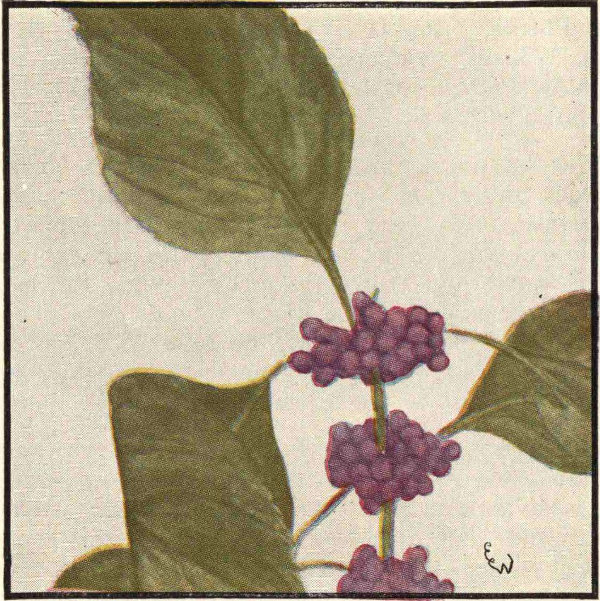
FRENCH MULBERRY
French Mulberry (Callicarpa americana) is a low shrub 3-6 ft. high, also known as the Bermuda mulberry or sour-bush. It is easily recognized in the fall by the clusters of reddish-purple berries and large ovate leaves 3-6 in. long. The showy berries are responsible for the scientific name which means “beautiful fruit.” It grows in woods of sandy areas from Central Texas to Florida and Virginia, and also in the West Indies. The variety with white fruit is not so common as the purple-fruited variety. The flowers are inconspicuous, pale pink or white. The shrub is well-known in cultivation but is not so hardy as the Japanese callicarpa.
The verbena family includes many tropical and sub-tropical shrubs, some of which are widely cultivated in Texas. Lantana (Lantana camara) has orange and yellow flowers and is a profuse summer bloomer. The common lilac lantana in cultivation was introduced from Brazil, but there are two native lilac lantanas in Southern Texas. Lavender, or vitex, introduced from Europe, is an excellent shrub for summer bloom.

PRAIRIE SKULLCAP
Stems usually 4-angled; leaves opposite; calyx 5-lobed, often 2-lipped; corolla 4-5-lobed, usually 2-lipped; stamens 4 or 2, on corolla-tube; fruit of 4 nutlets.
Prairie Skullcap (Scutellaria resinosa) turns its saucy flowers upward and covers the dense clumps with a purple glow. The tubular flowers are nearly an inch long and 2-lipped, with two short lobes forming the velvety, arched upper lip and with three broad lobes forming the spreading lower lip. The middle lobe is marked by a conspicuous white spot dotted with purple. Numerous stems grow from a woody, perennial root on rocky prairies and limestone slopes from Texas to Arizona and Nebraska.
The many skullcaps in the state are easily distinguished from other mints by the crest on the upper surface of the calyx. Most of them have small oval or rounded leaves, and all have purple flowers. They get their scientific name from the Latin word meaning “dish,” referring to the shape of the calyx.
The mint family is a large one, well represented in Texas. The European horehound (Marrubium vulgare) has become a pernicious weed in the pastures of Central Texas. Rosemary, sage, thyme, lavender, majoram, and the mints are familiar members of the mint family.
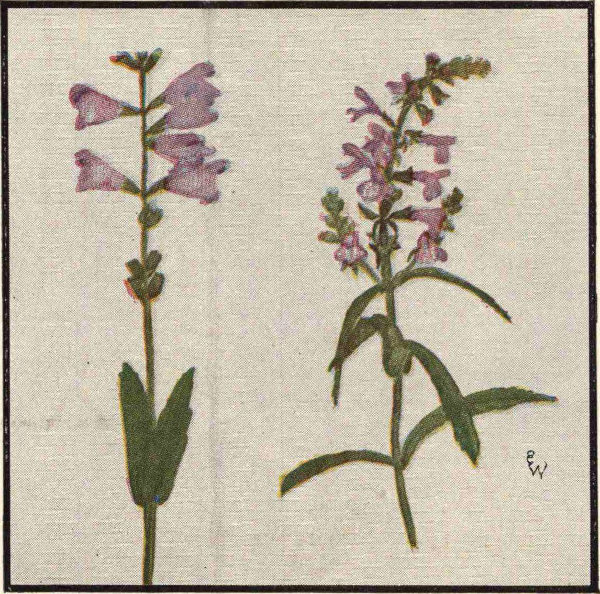
SLENDER DRAGON-HEAD BRAZOS MINT
Slender Dragon-Head or Lion’s Heart (Physostegia intermedia) has spikes of delicate lavender flowers. The slender stems, 1-3 ft. high, grow from perennial roots in moist soil on prairies from Texas and Louisiana to Missouri and Kentucky from April to July. The physostegias are rapidly growing in favor as garden flowers, as different species will produce blooms throughout the season, if the flowering spikes are cut and not allowed to seed.
Brazos Mint (Brazoria scutellarioides) is a lovely little annual found on the plains of Central Texas. The plants are usually less than a foot high and seldom branched, but the dense spikes of lavender flowers make it quite conspicuous during favorable seasons. Although the name indicates a resemblance to the skullcap, it might be mistaken for a dwarf physostegia. The corollas have much the same delicate lavender coloring, but the flaring calyx more closely resembles that of the Texas salvia. It is also called twin-flower, wild lilac, and honey plant.
Brazoria truncata, with larger and paler flowers, is very abundant in sandy soil in Central Texas, being especially common in Gonzales County. This plant was first collected near the Brazos River, a fact commemorated in the scientific name of “Brazoria.”
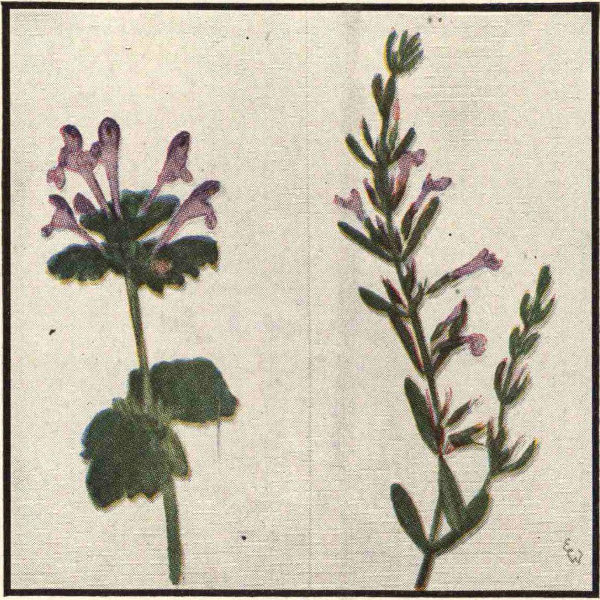
HENBIT PRAIRIE PENNYROYAL
Henbit. Dead Nettle (Lamium amplexicaule) is a troublesome weed on lawns everywhere in the state and in most of the United States. It is a winter annual introduced from Europe and Asia. The flowers often begin to bloom in December and continue until March or April. The stems branch from the base, and the flowers grow in stalkless clusters with the upper leaves.
Prairie Pennyroyal. Lemon Mint. Mexican Tea (Hedeoma drummondii) is a low perennial plant characterized by the lemon-like odor of the foliage, the narrow, tubular lavender corollas, and the bulging finely-ribbed tubular calyx. The flowers and leaves are about half an inch long. The low, bushy clumps grow on rocky plains and hillsides throughout Texas, the flowers blooming during the late spring and summer. A tea made from the foliage, either fresh or dried, is considered of value for its soothing effect. A few leaves in iced tea add a piquant flavor. The name is from the Greek and means “sweet smell.”
The American pennyroyal is Hedeoma pulegioides. The leaves and flowering tops are collected in July and August and dried. It yields an oil used in medicine.
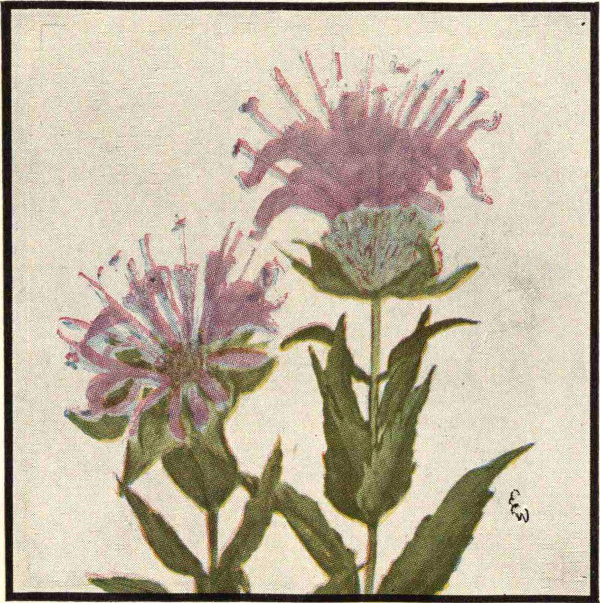
PALE WILD BERGAMOT
Pale Wild Bergamot (Monarda fistulosa mollis) is a very lovely member of the horsemint group. The slender stems are branched at the top, each branch having a terminal cluster of lavender flowers. The flowers are tubular and two-lipped, 1-1½ in. long, the upper lip narrow and the lower broad and three lobed. The upper lip is clothed with soft hairs.
The wild bergamot grows in the states east of the Rocky Mountains, and several varieties are known. In Texas it grows in moist woods in the eastern part and along streams in North Texas. It is a perennial which is sometimes cultivated. The stems are usually about two feet high. The leaves are short-stalked and lance-shaped, the margins having a few short teeth. The leaves have a pleasant aroma and are used in flavoring tea. Medicinally they are used as a stimulant and as a remedy for colic pains.
The brilliant, scarlet-flowered Oswego tea (Monarda didyma) of the Eastern States is not native to Texas. It is used as a substitute for tea.
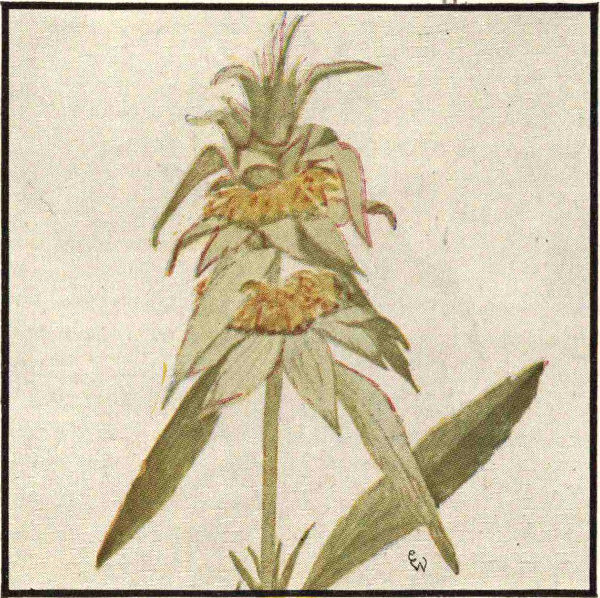
GREEN HORSEMINT
Green or White Horsemint (Monarda punctata) differs from the wild bergamot in having numerous clusters of flowers at the top of the stem. These clusters are surrounded by many short, drooping floral leaves which are blotched with white or occasionally have a purplish tinge. The yellow corollas are dotted with purple and are about an inch long. The calyx tube is ribbed, and the lobes are short and triangular. In growth habit and shape of leaves it is very much like the purple horsemint, but in flower it is readily distinguished by the yellow flowers and green and white floral leaves. The plants are perennial, much-branched, and somewhat downy. They are found in the Eastern and Central States and bloom in Texas from late May to July.
Dwarf Horsemint (Monarda clinopodioides) is another horsemint of sandy plains in Texas and Oklahoma. The plants are usually less than a foot high. They have white corollas, and the short bracts are purplish-brown with hairy margins. This horsemint is not so widespread as the green and purple horsemint.
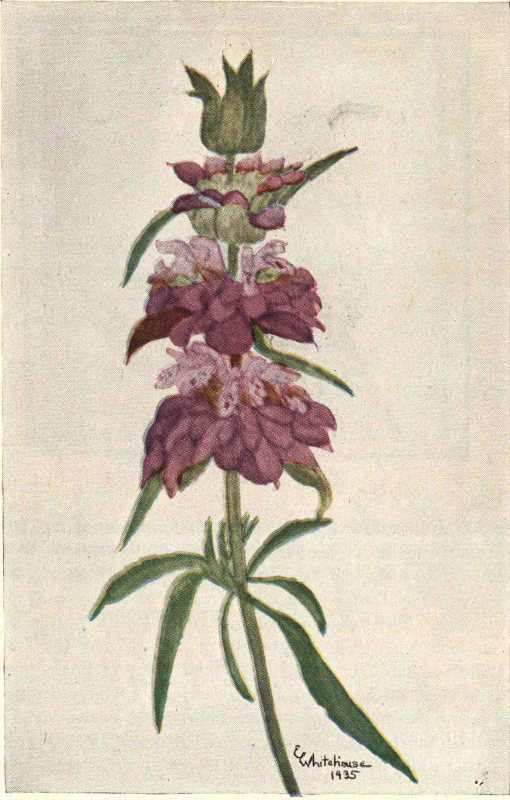
PURPLE HORSEMINT
Purple Horsemint. Lemon Monarda (Monarda citriodora) is lovely not only because of its dainty flowers but especially because of the floral leaves or bracts surrounding the flowers. These bracts take on a reddish-purple color and may be marked with white and green. The purple varies from rosy tints to a royal hue.
The flowers grow in whorls or rosettes at the top of the stem, new ones appearing with continued growth until there may be ten or more clusters on a stem. The corollas are narrow, tubular, and two-lipped, varying in color from lavender to white and commonly marked with small purple dots. The tubular calyx has five very narrow lobes, which are hairy and as long as the tube; the throat of the calyx is closed by a dense ring of white hairs.
Growing in erect clumps one to two feet high, the plants form conspicuous patches along highways and cover many pastures. The leaves are short-stalked and narrowed at both ends, the margins being sharply toothed. The purple floral leaves are oblong, with the midrib prolonged into a slender bristle or awn. These numerous bracts curve downward and overlap, the lower ones being longer.
The purple horsemint is common on plains from Mexico to Missouri and Kansas and ranges eastward to Florida. It blooms from May to August but is most profuse in June.
The monardas are North American plants named in honor of Nicolas Monardes, a Spanish physician and botanist. Some are valued for their perfume oils, and some have a slight medicinal value. The purple horsemint is rich in nectar, but the honey produced is not of the first quality. The dried plants are used in hens’ nests to drive off mites and fleas.
Plains Lemon Monarda (Monarda pectinata) is the common horsemint on the dry western plains in the state and ranges to Arizona and Nebraska. The flowers are pink or white but are not spotted with purple. The floral leaves are lance-shaped.
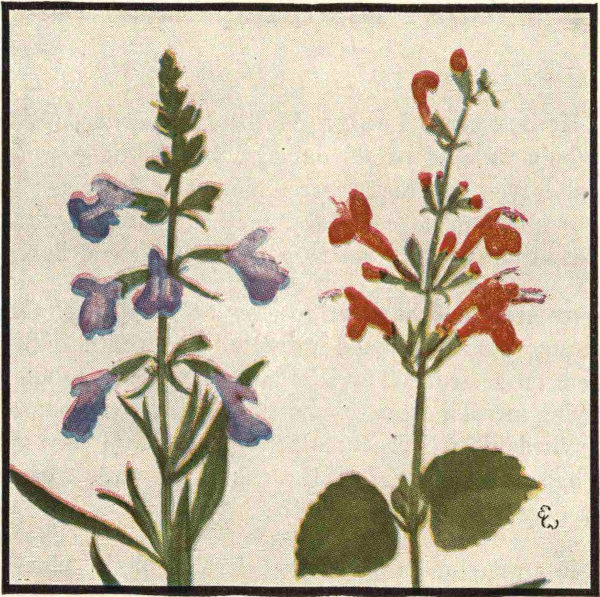
PRAIRIE SAGE RED SAGE
Prairie Sage (Salvia pitcheri) grows in scattered clumps throughout the central prairie region from Texas to Illinois and Minnesota. Because of its sky-blue, tubular, 2-lipped flowers, it is one of the plants most easily identified. The gray-green leaves have the characteristic sage odor and can be used for sage tea. The plants are two to three feet high and bloom from late spring to November.
Red Sage or Salvia. Indian Fire (Salvia coccinea) is a hardy plant in cultivation and blooms nearly all the year. It is native to the Gulf States, in Texas growing in woods near the coast. The red flowers are nearly an inch long.
There are nearly five hundred salvias known. Three European species are cultivated for their leaves, and many others are grown for ornamental purposes. The common bedding salvia is Salvia splendens, native of Brazil. The handsomest flower in the state is the red-flowered Salvia regla, found in a few mountain canyons in West Texas. Cancer weed (Salvia lyrata) is the common salvia of East Texas woods.
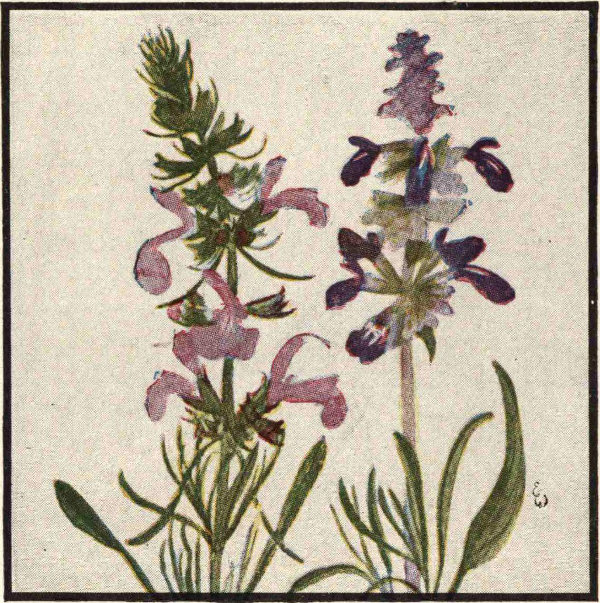
TEXAS SAGE BLUE SAGE
Blue Sage. Blue Salvia (Salvia farinacea) is a lovely plant which is native and abundant in the limestone regions of the state. It has long been known in cultivation, being especially adapted for rock gardens and highway plantings. It blooms with renewed activity after every rain from April to November. The corollas are usually purple but vary to blue and white. They have a narrow upper lip which is velvety with violet hairs on its outer surface. The calyx is velvety with violet-gray hairs. The stems grow from perennial roots and form clumps two to three feet high.
Texas Salvia. Texas Sage (Salviastrum texanum) blooms from March to May, growing in a low bushy clump 12-18 inches high on limestone hillsides from Central Texas to New Mexico. The spikes are densely covered with lavender flowers about an inch long. Unlike the true salvias, it has a flaring calyx which is densely bearded in the throat.
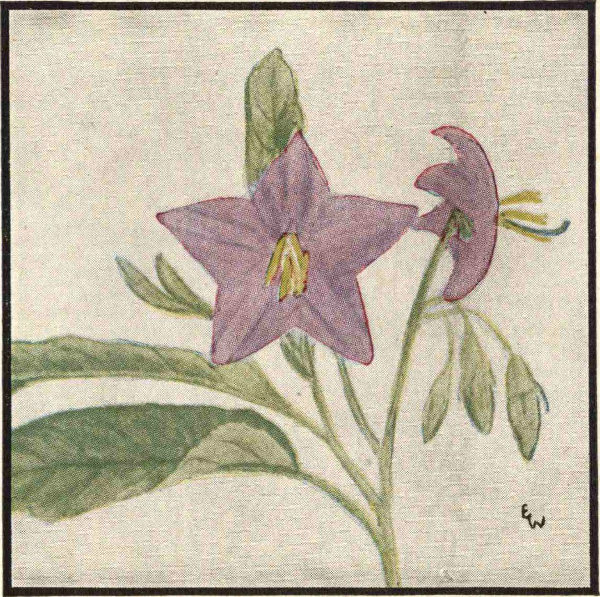
PURPLE NIGHTSHADE
Leaves alternate; calyx 4-6-lobed; petals united, 5; stamens 5, on corolla-tube, anthers often opening by apical pores; ovary 2-celled; fruit a capsule or berry.
Purple Nightshade (Solanum elaeagnifolium) is sometimes called silver-leaved nightshade or “trompillo.” Although bearing lovely star-shaped lavender flowers, the purple nightshade is considered a pernicious weed in fields and gardens. It grows from deep, woody perennial roots and blooms profusely even in seasons of drouth from May to October. It is found on plains from Missouri to Texas and Arizona. The branched plants grow 1-3 ft. high and are more or less covered with prickles. The yellow fruits resemble small tomatoes and remain on the old stalks for months. They are said to be poisonous.
Torrey’s Nightshade (Solanum torreyi) is a plant similar to the purple nightshade, but it has broader, irregularly-toothed leaves and larger flowers and seldom grows as high.
The solanum group comprises nearly a thousand species and includes many well-known plants, among which are the Irish potato and the egg-plant. Bitter-sweet and Jerusalem cherry are cultivated for their showy fruits. Several members of the group are said to be very poisonous.
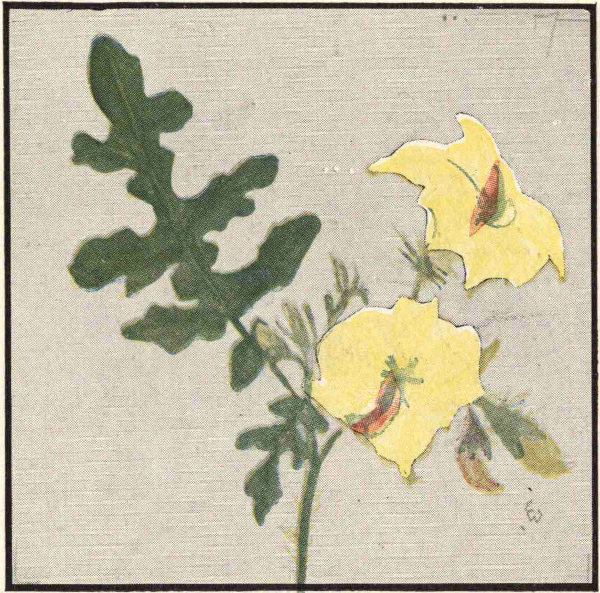
BUFFALO-BUR
Buffalo-Bur. Yellow Nightshade (Solanum rostratum) is a common weed in waste places and on prairies from Tennessee to Mexico, but the spreading plants are often covered with their yellow star blossoms. Children call them sticker-weeds because of the vicious prickles on the foliage. They are also called tread-softly, Texas nettle, prickly potato, and bumble-bee bush, the latter name being given because of the numerous bee visitors. The name of buffalo-bur dates back to the days when buffaloes roamed the plains, the prickly fruits clinging to the shaggy coats of the huge beasts.
The yellow flowers which bloom from May to October resemble those of the purple nightshade in shape and size. The stamens of the nightshades shed their pollen through small openings at the top of the pollen-sac. The buffalo-bur has one stamen very much larger than the other four. The leaves are once or twice divided into broad rounded segments. The berries are enclosed in the enlarged and spiny calyx.
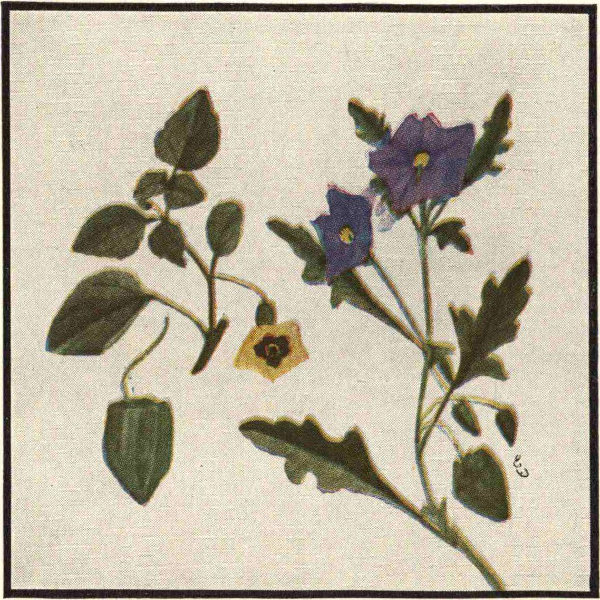
LOW GROUND CHERRY PURPLE GROUND CHERRY
Low Ground Cherry (Physalis mollis) is a common weed throughout the state and ranges to Arkansas, Mexico, and California. The flowers and fruits are usually hidden beneath the leaves. The fruit, a berry very much like a small tomato, is enclosed in the enlarged sac-like calyx. The scientific name is from the Greek word meaning “bladder” and refers to the inflated calyx. Some ground cherries are cultivated for their fruits which are edible and are used for making preserves and pies.
Purple Ground Cherry (Physalis lobata) flaunts its gay purple flowers for all to see. The plant has low, spreading branches which are covered with purple blooms, one inch broad. It ranges from Mexico to Kansas and California, blooming in Texas from spring to fall.
The potato family includes the tomato and tobacco plants. Wild tobacco (Nicotiana repanda) is very abundant in the southern part of the state. The white flowers resemble those of the cultivated petunia, which also belongs to this family.
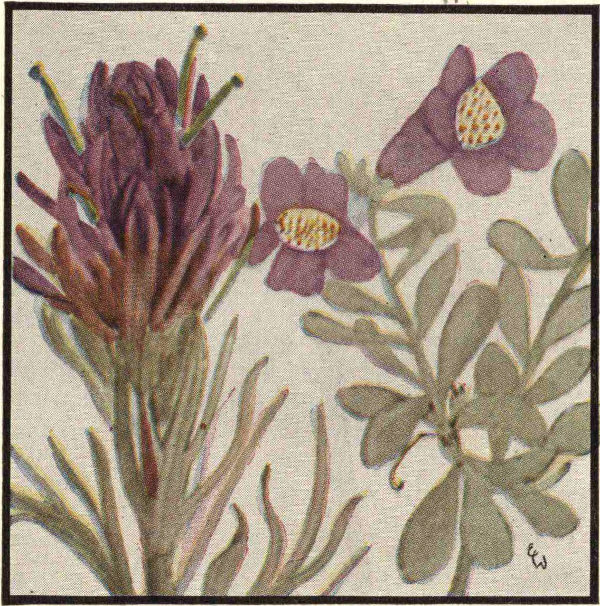
PURPLE PAINT-BRUSH CENIZO
Leaves alternate, opposite, or whorled; sepals, 4-5; corolla tubular, 4-5-lobed, 2-lipped; stamens often 4, in pairs on corolla-tube, sterile stamen often present; ovary 2-celled, superior.
Purple Paint-Brush (Castilleja purpurea) grows on limestone slopes and rocky prairies in North-central Texas. The low stems grow from a woody perennial root. The flowers and floral leaves are both conspicuously colored, varying from rose to purple. The divided leaves are a lovely ashy-gray.
Leucophyllum. White Leaf. Cenizo (Leucophyllum texanum) covers hillsides in the southern and southwestern parts of the state. The low bushes seldom grow more than three or four feet high. It is a startling and lovely sight to see a hillside which was a mass of gray transformed overnight into a delicate hue of lavender. This happens shortly after heavy rains, and for this reason the plant is sometimes called barometer bush. Leucophyllum has been widely introduced as a shrub in Texas gardens, where the ashy-gray leaves are quite effective against dark green shrubbery. The name is Greek and means “white leaf.”
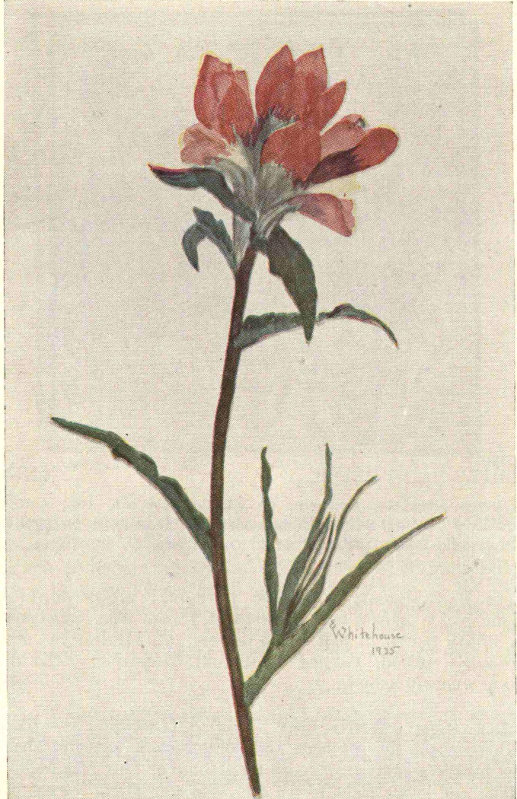
SCARLET PAINT-BRUSH
Scarlet Paint-Brush (Castilleja indivisa) is also called Indian paint-brush, painted-cup, entire-leaved paint brush, and Indian pink. One of the most inspiring landscape displays of native flowers is formed by the scarlet paint-brush. It is found in sandy soil from the northeastern to southwestern parts of the state and blooms from March to May but is at its best in April. The paint-brush display of red is equalled or excelled only by that of two other wild-flower favorites—the red Drummond’s phlox in south-central sandy regions and the beautiful gaillardia of black land prairies.
The intense scarlet-red is due to the coloring of the broadened floral leaves (bracts) at the tip of the stem. These bracts almost hide the inconspicuous cream-colored flowers which are about an inch long. The bracts are oblong, the tips being broader than the base and deeply stained with scarlet.
The scarlet paint-brush is an annual plant, commonly six to twelve inches high, and is sometimes branched at the base. The leaves are rough-nerved and wavy-margined. Occasionally the leaves have two linear basal lobes somewhat like those of the eastern or swamp scarlet paint-brush (Castilleja coccinea), which has similar flower clusters but grows in swampy places.
The castillejas are mostly Western American plants, some being parasitic on the roots of other plants. They are named in honor of D. Castillejo, a Spanish botanist. In addition to the scarlet and purple paint-brushes, several other castillejas are found in the state. Lindheimer’s paint-brush (Castilleja lindheimeri) is very much like the purple paint-brush, but it has red or orange bracts. It is a perennial plant which grows on limestone hillsides of Southwest-central Texas. The woolly-stemmed paint-brush (Castilleja lanata) has woolly-gray stems and leaves and red flower clusters. It may be noticed in chaparral thickets and canyons in West Texas.
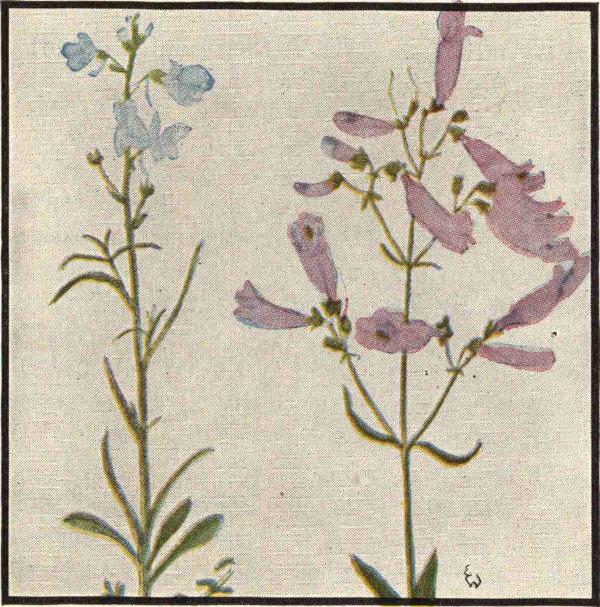
TEXAS TOAD-FLAX SMALL-FLOWERED BEARD-TONGUE
Small-Flowered Pentstemonor or Beard-Tongue (Pentstemon laxiflorus) grows in the sandy soil of post oak woods in Central and East Texas. The slender stems are 1-2 ft. high and are topped by slender-stalked flower clusters. The corollas are a pale lavender, about an inch long. This is a very common plant in the state and has been given various names by botanists, the latest one being laxiflorus. It is a close relative, probably a variety, of the slender beard-tongue (Pentstemon gracilis) of moist prairies from Minnesota to Oklahoma.
Texas Toad-Flax (Linaria texana) has pale blue flowers similar to those of the Canada toad-flax. The corollas have a slender spur about half an inch long. The slender stems are 1-2 feet high, growing from a cluster of basal leaves which are finely divided into somewhat rounded segments. It is widespread in sandy soil from Florida to California and blooms early in the spring.
Many other figworts are found in the state. The nearest relative to the garden snapdragon is the climbing snapdragon (Maurandia antirrhiniflora). Mullein is widespread in the state. The common monkey-flower is Mimulus glabratus.
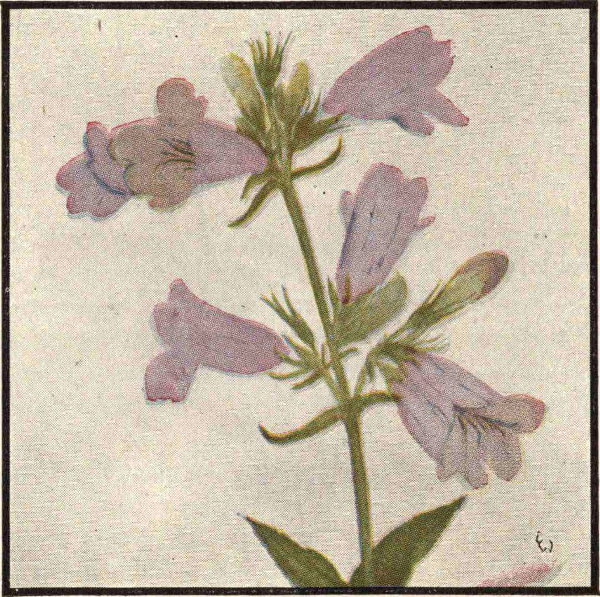
LARGE-FLOWERED BEARD-TONGUE
Large-Flowered Beard-Tongue or Pentstemon (Pentstemon cobaea) is also known as false foxglove, dew flowers, fairy thimbles, wild belladonna, and balmony. It was called “balmony” by early settlers, who made a tea from the leaves to be used as a laxative. Several erect stems from perennial roots grow on the rocky slopes of prairies from Texas to Missouri and Kansas. It blooms in Texas in April and May.
The flowering spikes of bell-shaped flowers are large and showy. The corollas are usually pale, tinged with reddish-purple and marked with darker lines. The fifth stamen is sparingly bearded. The stems are 1-1½ feet high, and the flowers are 1½-2 inches long. The leaves are broad and partly clasping at the base, the margins usually indented with sharp teeth. It is thought that the common garden pentstemon is a hybrid derived from this beard-tongue and Hartwig’s pentstemon, a Mexican plant.
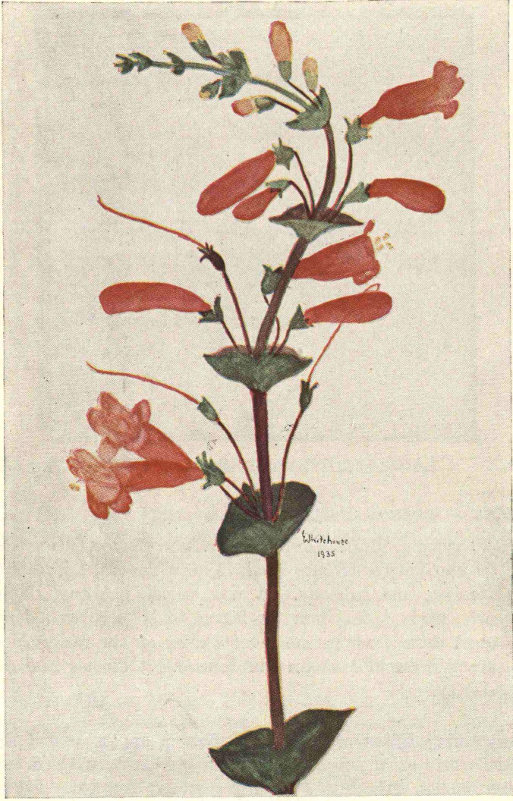
SCARLET PENTSTEMON
Scarlet Pentstemon or Beard-Tongue. Murray’s Pentstemon (Pentstemon murrayanus) is a very lovely plant growing in sandy soil in post oak woods of Central and East Texas and Arkansas. The plants are three feet high, the reddish stems having a few opposite, clasping leaves, those on the upper part being united and cup-shaped. The foliage is very smooth and has a somewhat downy covering.
The flowering upper portion of the stem is often over a foot long and bears a profusion of tubular scarlet flowers about an inch long. The stamens extend beyond the corolla, and the fifth stamen is not bearded. The long slender style remains on the capsule long after the corollas have fallen away. The flowers usually bloom the latter part of March in South Texas and the middle of April in North Texas. The plants are quite hardy and may be successfully transplanted or grown from seeds, but should be planted in sandy soil.
“Pentstemon” is Greek meaning “five stamens.” Nearly all members of the figwort family have only four stamens, but the pentstemons have five; however, the fifth stamen does not bear a pollen-sac and is often bearded. “Beard-tongue” refers to this bearded stamen. There are nearly a hundred and fifty species of pentstemons, about thirty of them being found in Texas. With the exception of one found in Southeastern Asia, they are all North American plants.
Murray’s pentstemon is quite similar to two red-flowered pentstemons of the mountains of West Texas. These two are likewise tall, vigorous plants and have showy clusters of flowers. Torrey’s pentstemon (Pentstemon barbatus torreyi) has narrow pointed leaves, and the superb pentstemon (Pentstemon superbus) has broad oblong leaves. The common blue-flowered pentstemon in West Texas is Pentstemon fendleri, with leaves nearly as broad as long.
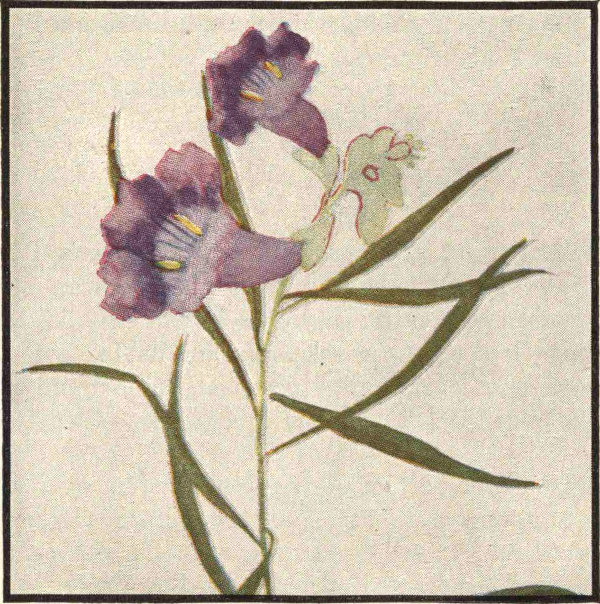
DESERT WILLOW
Leaves opposite, mostly compound; flowers showy, often 2-lipped; calyx tubular, 5-lobed; petals 5, united; stamens 4 or 2, in pairs on corolla-tube; capsules often long, with winged seeds.
Desert Willow (Chilopsis linearis), also called flowering willow, willow-leaved catalpa, and “mimbre,” is a common shrub along water courses from West Texas to Southern California and Northern Mexico. When it is not in flower or fruit, it may be mistaken for the black willow (Salix nigra), which has similar leaves. The delicate, lavender, trumpet-shaped flowers are about two inches long. White and pale-lavender forms occur. It is a shrub or small tree frequently cultivated for ornament in Texas and California. It blooms from May through the summer months. Mexicans use the wood for fence-posts and the branches for baskets. A tea made from the flowers is used as a remedy for heart and lung diseases.
Several other members of this family are native to the state and are well-known in cultivation. Among these are the red-flowered trumpet-creeper (Campsis radicans), the yellow-red cross-vine (Bignonia capreolata), the catalpa found in East Texas woods, and the yellow-elder (Tecoma stans) in South Texas and the mountains of West Texas.
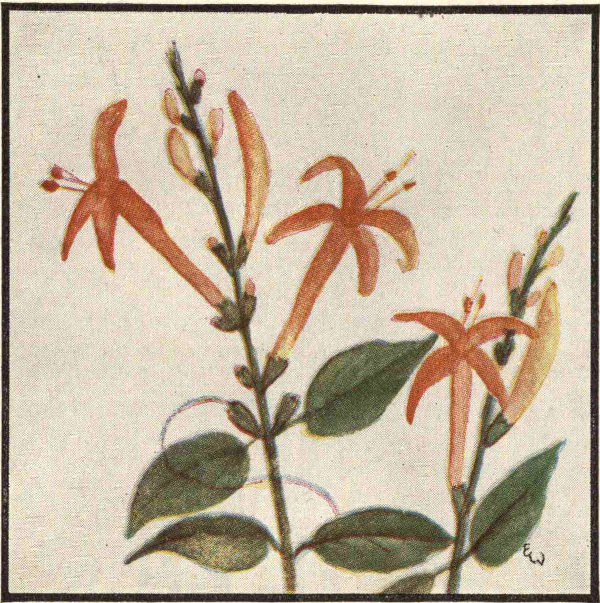
FLAME ACANTHUS
Leaves opposite; calyx 4-5-lobed; sepals 5; petals 5, united, sometimes 2-lipped; stamens on tube, 2 or 4 in 2 pairs; fruit a capsule, often club-shaped, opening elastically.
Flame Acanthus (Anisacanthus wrightii) is covered with scarlet flowers from early summer until frost. It is a low, widely branched shrub, about 2 feet high, found in rocky soil of the mountains of West Texas. The corollas have a narrow tube and five narrow, spreading lobes which are nearly equal but somewhat 2-lipped. The two stamens and the style extend beyond the corolla. The small leaves are ovate-lanceolate in shape and are 1-2 inches long.
The flame acanthus is an excellent garden shrub for dry regions and has been known in cultivation for some time. This species is named in honor of Charles Wright, an early collector of Texas plants and one of the first teachers in the state. Wright was a Yale graduate who collected plants in Texas from 1837 to 1852 for Dr. Asa Gray of Harvard University. He accompanied a baggage train to El Paso in 1849, and in 1851 he joined the Graham Boundary Survey. On both of these trips he collected many plants not previously known to science.
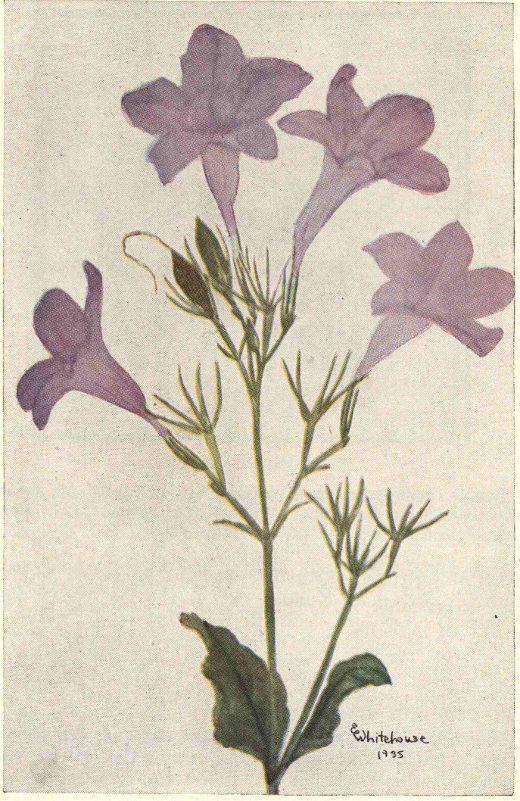
WILD PETUNIA
Wild Petunia. Ruellia (Ruellia nudiflora) has flowers very much like those of the cultivated petunia, a member of the potato family. It is a very common plant in Central and South Texas, growing in open woods or on rich prairies. It frequently takes possession of lawns and flower beds.
The plants are erect, 12-16 inches high, and have few branches. The few leaves are oval, narrowed at the base, wavy-margined, and blunt or rounded at the apex. The forking flower clusters have one to five flowers open at the same time. The flowers do not last very long. Leaves and stem are often marked with red or purple.
The delicate, funnel-shaped corollas have five spreading lobes and are about two inches long. The four stamens are inclosed in the tube. The seed-capsules are nearly an inch long and turn brown as they mature.
This ruellia was formerly confused with Ruellia tuberosa, a tropical plant with tuberous roots. The ruellias belong to a large group of plants with about 200 species most of which are found in tropical South America. They are named for Jean de la Ruelle, an early French physician and botanist.
There are several other ruellias widely distributed in the wooded sections of the state. The hairy ruellia (Ruellia ciliosa) is abundant on the prairies in Texas and the Eastern States. Miss Eaton, in an article in the National Geographic in 1925, reports that carpenter-bees use circular pieces of the corolla to plug off their nesting cells made in tunnels in soft wood. Drummond’s ruellia (Ruellia drummondiana) is found in woods in Central Texas. The flowers are rather small and are nearly hidden by the leaves.
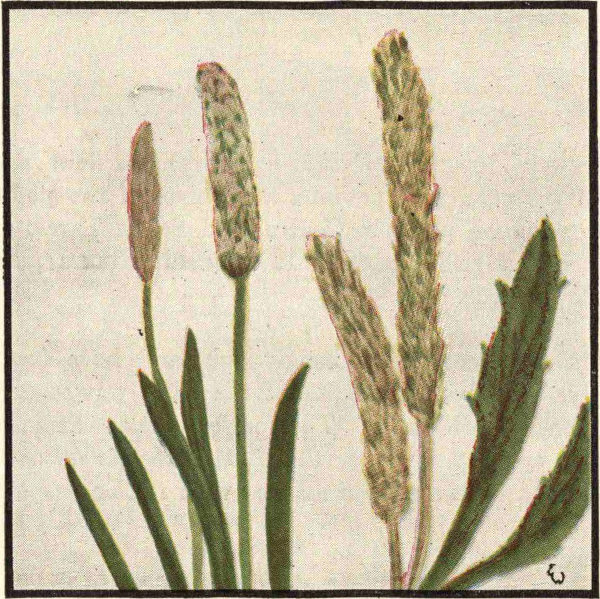
TALLOW-WEED RED-SEEDED PLANTAIN
Herbs; leaves basal; calyx 4-lobed; corolla papery, 3-4-lobed; stamens 4, on corolla-tube; capsule (in ours) opening by a horizontal division.
Tallow-Weed. Wright’s Plantain (Plantago wrightiana) is a common plant on prairies from Texas to Arizona and blooms from April to June. It is called tallow-weed because cattle fatten on the plants. The stems are 6-8 in. high, and the numerous basal leaves are half as long, narrow, smooth, and dark green. The small 4-lobed flowers have a stiff, papery white corolla with spreading lobes. The small capsules open by a lid.
Red-Seeded Plantain or Ribwort (Plantago rhodosperma) has broad leaves, 3-5-ribbed, and narrow spikes of flowers. The leaf-rosettes are often a foot broad. The corolla lobes are erect and are closed over one another. The ribwort is a very common weed in sandy soil from Missouri to Texas and Arizona.
There are many other plantains in the state, all more or less abundant. The group has retained the old Latin name. Scilla-seed, a laxative in recent use, is obtained from a South American plantain. The seeds of the lance-leaved plantain are sold as food for birds.
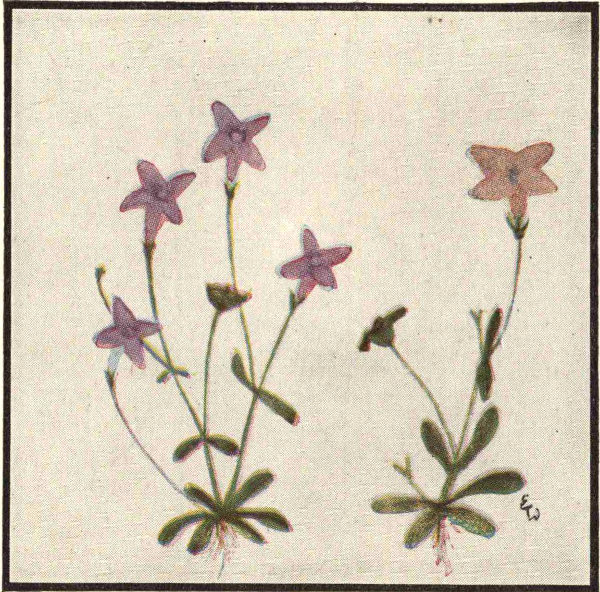
SMALL BLUET LEAST BLUET
Leaves opposite or whorled; in ours, sepals and petals usually 4, but may be 4-10, calyx joining ovary wall; stamens 4-10, on corolla-tube; ovary inferior, 2-5-celled.
Small Bluet (Houstonia patens) has violet-blue flowers which are among the first blossoms of spring. They dot golf courses and sandy meadows from Texas to Virginia and Illinois in February and March. The bluets are also called innocence and angel-eyes.
Least Bluet (Houstonia minima) is a smaller plant than the small bluet, but the flowers are a little larger and are pale pink. They bloom at the same time of year and may often be found together. The least bluet ranges from Texas to Illinois and Kansas.
The madder-family is mainly tropical but is represented in Texas by nearly forty species. Nearly all of these have inconspicuous, 4-lobed white flowers and include many bedstraws and bluets, the button-weed, and button-bush. From some members of the family valuable commercial products—coffee, quinine, and a red dye—are obtained; the cape-jasmine or gardenia is a well-known ornamental plant.
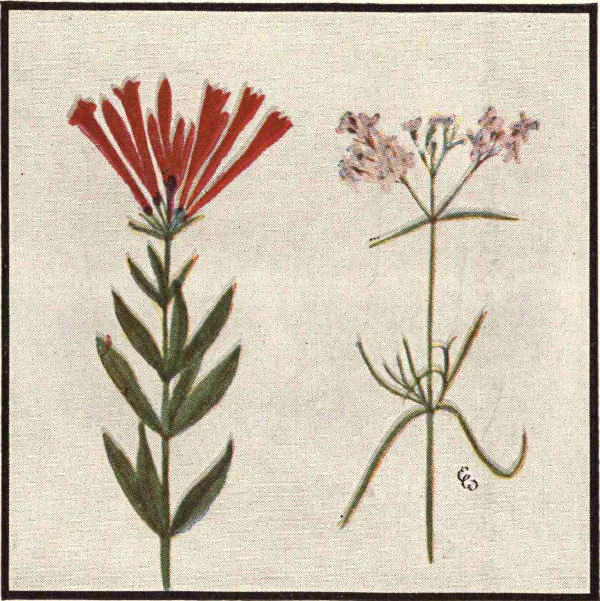
BOUVARDIA BABY’S BREATH
Baby’s Breath. Narrow-Leaved Houstonia (Houstonia angustifolia) is not the garden plant (Gypsophila paniculata) which is known as baby’s breath, but it is equally dainty. The stems grow from woody perennial roots and form erect clumps about a foot high. The small flowers are borne in flat-topped clusters and vary in color from white to pale pink or lavender. This plant is widely distributed on prairies from Illinois to Texas and Florida.
Bouvardia (Bouvardia ternifolia) is a low shrub, 2-6 ft. high, which grows in the mountains west of the Pecos River to Arizona and Mexico. The leaves are short and grow in whorls of 3’s or 4’s. The narrow, red tubular flowers are about one inch long. The Bouvardias were once popular as greenhouse plants but are little used now. This one was introduced into England more than one hundred years ago.
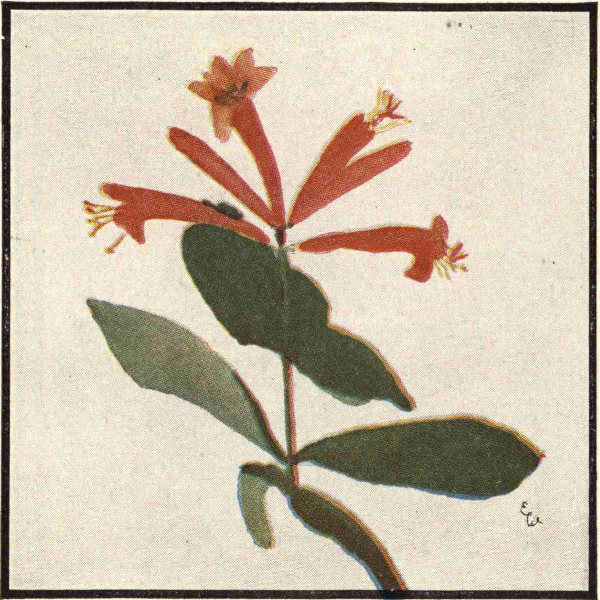
CORAL HONEYSUCKLE
Usually shrubs; leaves opposite; calyx joining ovary wall, 5-lobed; corolla 5-lobed, tubular and often 2-lipped; stamens 4-5, on corolla-tube; ovary inferior; fruit a fleshy berry.
Southern Woodbine. Coral or Trumpet Honeysuckle (Lonicera sempervirens) is quite common in the woods of East Texas and other Southern States, blooming in Texas in late March and continuing until fall. It is an evergreen vine that has been widely introduced into cultivation. The flowers are not so conspicuously two-lipped as in the white honeysuckle, the corolla-lobes being nearly equal. The scarlet berries are ¼ inch long, ripening in the summer. This is one of a number of plants which are commonly called woodbine. The group was named in honor of Adam Lonitzer, an early German botanist.
The black haw (Viburnum prunifolium) is very abundant in Texas woods. The showy ball-like clusters of white flowers appear with the leaves in April and May, following the dogwood and red haws. The American elder (Sambucus canadensis) is found along streams in Central and East Texas.
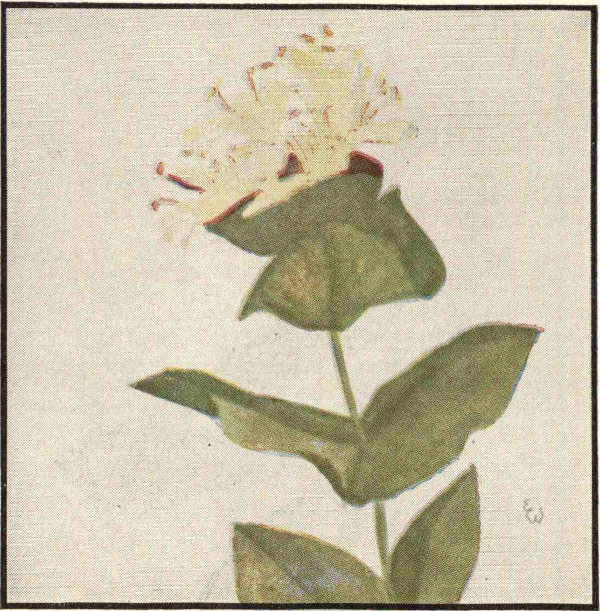
WHITE HONEYSUCKLE
White Honeysuckle (Lonicera albiflora) is a straggling bush which usually grows in the shelter of a tree. The pale broad, oval leaves are opposite and united at their bases, the uppermost pair being cup-shaped and surrounding the cluster of flowers borne at the tip of the stem. The fragrant flowers are less than an inch long with a narrow tube and 5 lobes, the lower lobe long and narrow and the 4 upper shorter, very much like those of the common cultivated Japanese honeysuckle. The five spreading stamens extend conspicuously beyond the corolla.
This plant blooms in April and May. It is scattered throughout the central and western parts of the state, being especially abundant in the western mountains, and ranges to Arkansas and Arizona. The Japanese honeysuckle has escaped cultivation in places along the bayous of East Texas.
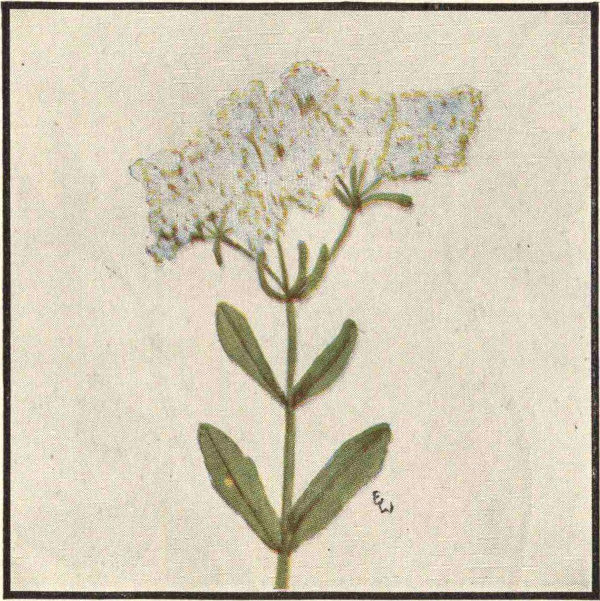
LAMB’S LETTUCE
Leaves opposite; calyx of several bristles or absent; petals 2-5, partly united; stamens usually 4, on corolla-tube; ovary inferior, 3-celled but only 1 cell fertile.
Lamb’s Lettuce. Texas or Dwarf Corn Salad (Valerianella amarella) is one of the first white-flowered spring plants, growing in such abundance that the prairies are white with the blooms. It is a much smaller plant than the dwarf Queen Anne’s lace which is so lovely late in April and May. In the field it is usually about 6 in. high but grows a little higher in cultivation when used as a border plant. It is easily identified by its flat-topped clusters of flowers grouped in squares at the end of the widely forking branches. The smooth foliage is yellow-green in color.
There are several corn salads which grow in moist places in the state. The dwarf corn salad may readily be distinguished from these, as its minute seed-pod is covered with woolly hairs. The European corn salad is cultivated, and the leaves are used for salad.
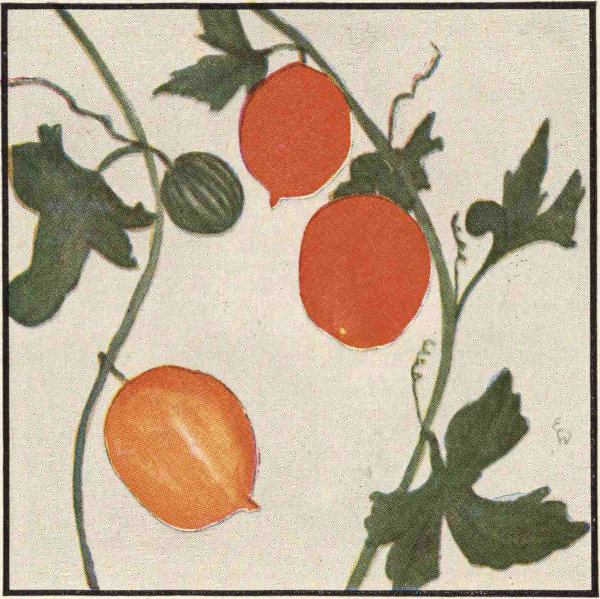
WILD BALSAM GOURD
Tendrils mostly present, stems often prostrate; flowers usually unisexual; calyx tubular, 5-lobed; petals united or separate; stamens usually 3, one anther always 1-celled, the other two 2-celled; ovary inferior.
Wild Balsam Gourd (Ibervillea lindheimeri) has bright scarlet balls about an inch in diameter and makes conspicuous spots of color on fences in the fall. The vine is slender, bearing small yellow flowers in the spring. The fruits are green at first, turning orange and then a scarlet red. Sometimes they are a little longer than broad and pointed at the end. The few leaves are thick and deeply 3-5-lobed. It ranges from Texas to California.
The garden balsam (Impatiens balsamina) bears no relation to this plant. The vines in cultivation known as balsam apple and balsam pear are, however, members of the gourd family and were introduced from the Old World tropics. Watermelons, cantaloupes, cucumbers, squashes, pumpkins, and gourds are well-known members of the gourd family.
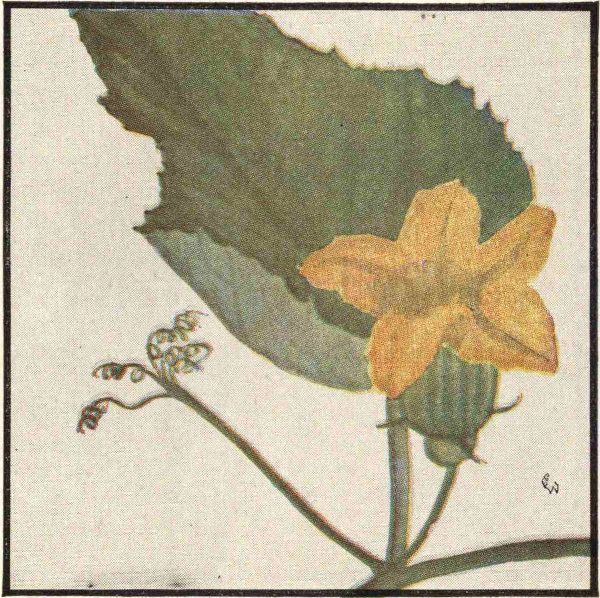
WILD GOURD
Wild Gourd. Mock Orange (Cucurbita foetidissima) has long trailing stems which are often 15 feet long and may be 25 feet long. It is readily distinguished by its large gray-green triangular leaves which are somewhat 3-5-lobed. The leaf-blades are 4-12 inches long, and the leaf-stalk is about half the length of the blade. The star-shaped yellow flowers, about three inches broad, are almost hidden by the leaves, the staminate and pistillate flowers being borne on different plants.
The ovoid gourds, which at first are green variegated with a lighter green, turn quite yellow at maturity. The resemblance of the yellow fruit to oranges has given rise to the common name, mock orange. The gourds are about three inches long. They are not edible, as the pulp is fibrous and bitter. Mexicans use the plant as a soap substitute by mashing the gourds or the roots in water. They call it “chilicoyote” or “calabacilla.” The pumpkins and squashes, whose origin is somewhat obscure, are close relatives of the gourd.
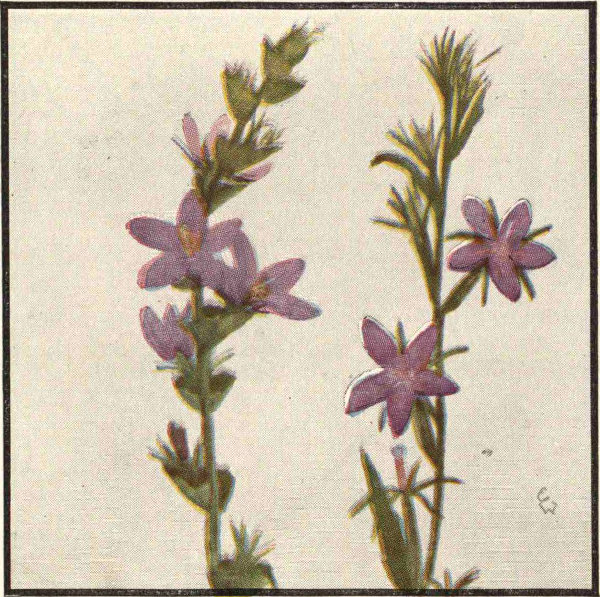
VENUS’ LOOKING-GLASS WESTERN VENUS’ LOOKING-GLASS
Juice usually milky; leaves alternate; calyx tube joined to ovary, 3-10-lobed; corolla tubular or bell-shaped, sepals and petals usually 5; stamens 5; ovary inferior, 2-10-celled.
Venus’ Looking-Glass (Specularia perfoliata) is a very common American plant blooming in Texas in the early spring. Like the later flowers of many violets, the first flowers never open and are self-fertilized. The later flowers have a showy 5-lobed purple corolla about an inch long. The seeds are dispersed from a small opening in the lower part of the capsule. The leaves are small and clasping, usually broader than long.
Western Venus’ Looking-Glass (Specularia leptocarpa) has flowers very much like the preceding, but the stamens and calyx lobes are longer. The long, slender capsules have the opening pore near the top. The showy flowers appear in late April and May. This plant is abundant on the northern prairies of Texas and ranges to Missouri and Montana.
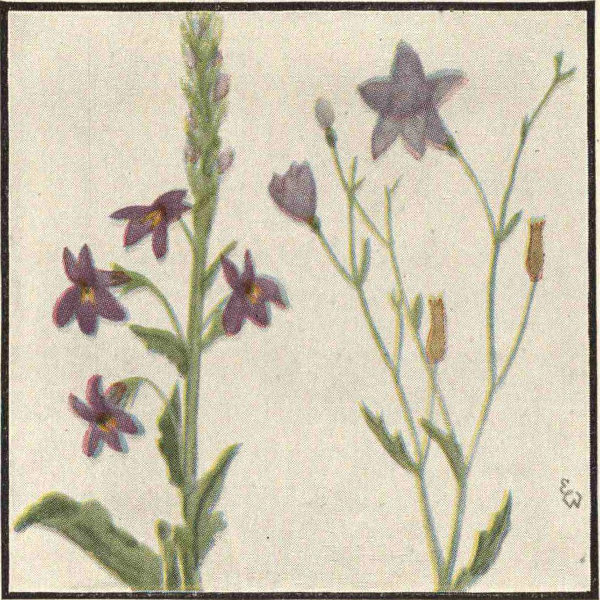
PRAIRIE LOBELIA TEXAS HAREBELL
Texas Harebell. Bluebell (Campanula reverchonii) is one of the rarer plants in the state, and care should be taken to preserve it. It is lovely against the granite rocks and boulders of Central Texas. The dainty, slender plants are often much branched and have blue flowers about half an inch long. The bluebell of Scotland is a renowned member of the group; Canterbury bells and the balloon-flower are well-known in gardens.
Juice often milky; sepals 5; corolla 1-2-lipped, united; stamens 5, anthers joined into a tube.
Prairie Lobelia (Lobelia brachypoda) grows on sandy prairies in Southern Texas and the adjacent part of Mexico. It is very abundant west of Falfurrias in March. The Texas lobelias may usually be recognized by the five united stamens which have gray anthers bearded at the top. The plants often have a milky sap containing a poisonous alkaloid which is used in medicine. The red cardinal flower (Lobelia splendens) is rather widely scattered in moist places throughout the state but is rare enough to need protection.
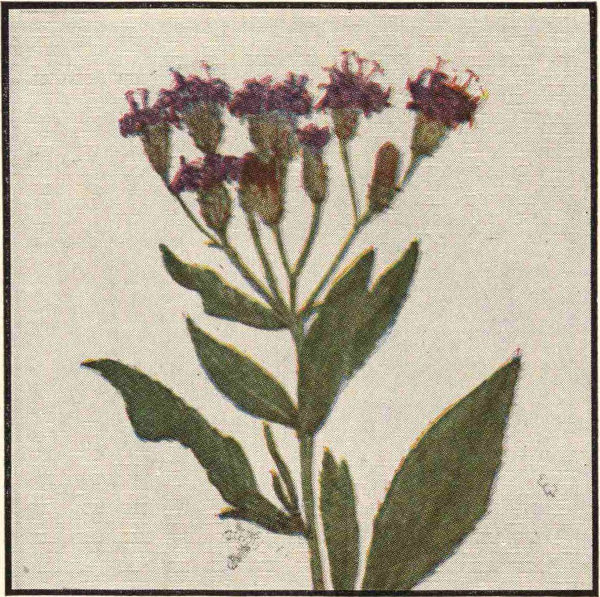
BALDWIN’S IRONWEED
Flowers crowded into heads surrounded by bracts; outer flowers often strap-shaped and are called ray flowers; inner flowers are tubular and are called disk flowers; sometimes flowers are all of one type; calyx usually modified into bristles or awns (pappus); petals united, tubular, 4-5-lobed; stamens 5, anthers united into a tube; styles 2-lobed; ovary 1-celled, inferior. (See p. xii.)
Baldwin’s Ironweed (Vernonia baldwinii) has broad, flat-topped clusters of purple heads. It forms a pleasing contrast to the abundant yellow flowers of the summer months. The plant is a hardy perennial and grows in ditches and river bottoms from Central Texas to Iowa. The stems are 3-4 feet high and conspicuously leafy. The ironweeds get their common name from the fact that the stems are very hard and difficult for farmers to chop down.
About one-fifth of the plants found in Texas belong to the composite family. It is generally divided into groups or tribes, the more important being the ironweed, mist-flower, aster, everlasting, sunflower, bitterweed, dog-fennel, and thistle groups. The composites in this book are grouped together in tribes in the above order, but the tribes are not separated or differentiated. Identification of composites is much easier if the resemblance to a particular group can be noted.
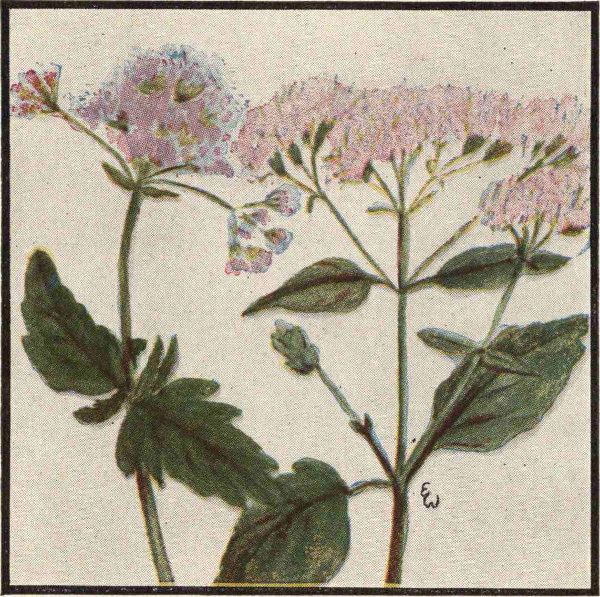
BLUE MIST-FLOWER BLUFF THOROUGHWORT
Bluff Thoroughwort (Eupatorium ageratifolium) is a widely branched shrub of the rocky hillsides of Central and West Texas. The bushes are covered with flat-topped clusters of pale-pink or white flowers. The long, protruding styles, which are divided into two recurved parts, have given the name of mist-flower to this and other plants of the group.
Milk-sick plant (Eupatorium ageratoides) is a closely related plant which causes in cattle a disease called “trembles.” The milk from affected cows will cause sickness and death among humans. The late-flowering thoroughwort (Eupatorium serotinum) is very abundant in river bottoms throughout the state. Yankee-weed (Eupatorium compositifolium) grows in big feathery clumps often 10 feet high. It is a pernicious weed in East Texas and soon covers cut-over pine lands. The dried flower-tops of several species were used by pioneers as fever medicines. One of these plants was called Joe-pye weed in honor of the Indian doctor, Joe Pye.
Blue Mist-Flower (Conoclinium coelestinum) is sometimes called ageratum and is used for a summer and fall border plant. It grows in moist, shaded places from Central Texas to New Jersey.

PRAIRIE BLAZING STAR DWARF GOLDENROD TALL GOLDENROD
Prairie Blazing Star. Button Snakeroot (Laciniaria punctata) is sometimes called liatris from the scientific group to which these plants are sometimes referred. A similar prairie blazing star is called gay-feather. On the dry prairies in the western part of the state the blazing star has short stems and short spikes of flowers; but where moisture is more abundant, the plants are one to two feet high. The plant does well in cultivation and is easily grown from the seed. It ranges from Southern Canada to Texas and New Mexico.
The stems are closely covered with the narrow leaves, which are marked with minute glandular dots. The spikes are densely covered with long, narrow heads of purple flowers. There are only a few star-shaped tubular flowers in a head. The seeds are widely scattered by their crown of plumose bristles. The lovely spikes are often dried for winter bouquets.
Many eastern blazing stars are found in the woods of East Texas, where they make showy displays from July to October. They are called snakeroots from their reputed property of curing snake-bites. A tea made from the plant will cause profuse perspiration; the perspiration was probably responsible for the reported snake-bite cures. They are also called devil’s bit or devil’s bite, because of the bitten-off appearance of the rootstock. The rootstock was considered such a powerful remedy for human ills that the devil bit off a part for spite.
Tall Goldenrod (Solidago altissima) grows 2-8 ft. high, has rough leaves which are sharply toothed and prominently triple-nerved, and is topped by dense clusters of yellow flowers. Most of the goldenrods are widely distributed in North America; the tall goldenrod is abundant in dry soil from Maine to Nebraska and Texas.
Gray, Field, or Dwarf Goldenrod (Solidago nemoralis) has flower heads all turned to one side of the branches which top the slender wand-like stems. The stems are one half to two feet high. This is one of the most abundant goldenrods in the central and western parts of the state from July to November and ranges from Canada to Florida and Arizona.
In Texas the goldenrods are usually found only in moist soil, many eastern species growing profusely in East Texas. The three-nerved goldenrod (Solidago trinervata) is the common one in Southwest Texas.

STIFF GOLDENROD
Stiff or Hard-Leaved Goldenrod (Solidago rigida) is one of about thirty-five goldenrods found in the state. It belongs to the type which is responsible for the common name, as the yellow flowers are in heads arranged in rod-like clusters at the top of the stem. The scientific name of “Solidago,” meaning “to make whole,” had its origin in the healing properties of certain species.
The stiff goldenrod grows in dry rocky or sandy soil east of the Rocky Mountains from Southern Canada to Texas. It grows 1½-2 feet high and has broad leaves 1-2 inches long. Lindheimer’s goldenrod (Solidago lindheimeriana) is a similar stout, leafy-stemmed plant which is abundant in Central Texas and ranges to Kansas and Mexico. Bigelow’s goldenrod (Solidago bigelovii) is another species with rod-like clusters. It is found in the mountainous regions of West Texas and New Mexico.
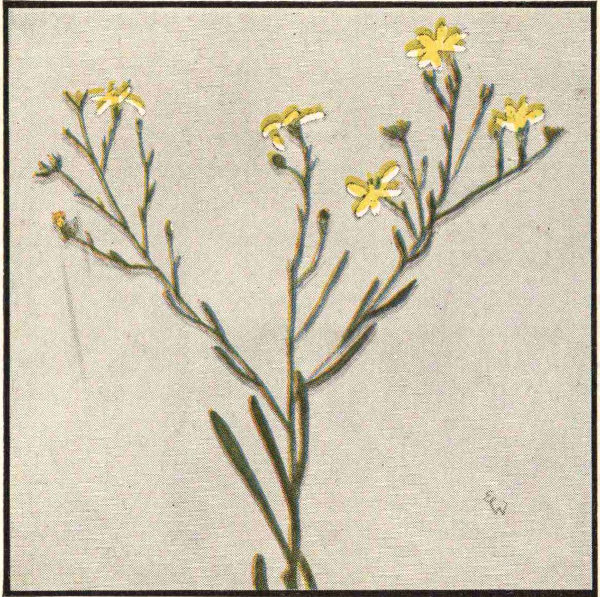
BROOM-WEED
Broom-Weed. Kindling-Weed (Amphiachyris dracunculoides) is a pasture pest in the southern part of the Great Plains region. The slender stem is unbranched near the base, but above the middle the numerous spreading branches form a flat-topped plant which bears many small heads of yellow flowers. The plants are often 2-4 feet high and grow in dense masses. It has been used as a broom by early settlers, Mexicans, and children at play. The resinous foliage of the dried plants was also highly valued for kindling fires.
The broom-weed is closely related to the rabbit-brush which is so abundant in West Texas and New Mexico. The Texas rabbit-brush (Gutierrezia texana) of West Texas is so much like the broom-weed that only a close observer can distinguish them. Both have 5-8 flowers with strap-shaped corollas in the outer part of the head and a few tubular flowers in the center; both bloom in the late summer and fall.
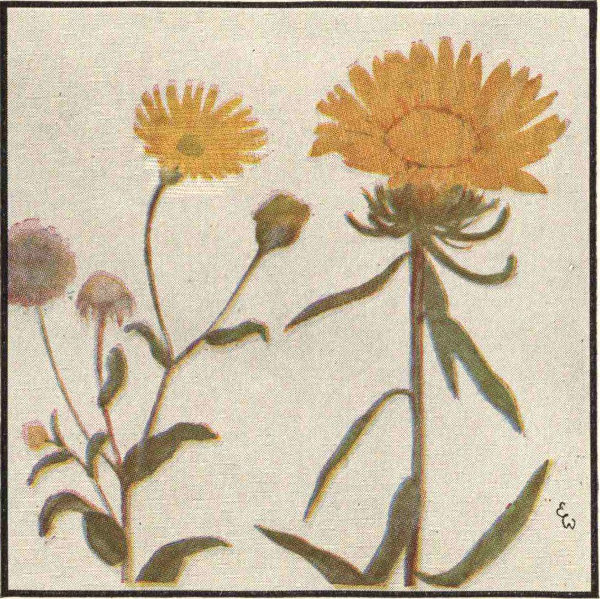
CAMPHOR DAISY TEXAS GUMWEED
Camphor Daisy (Heterotheca subaxillaris), so called because of the camphor-like odor of the rough foliage, is a common summer pest to the farmer. The plants often grow 3 feet high and are much branched, bearing heads of golden-yellow flowers nearly an inch across. The upper leaves are broad and clasping, but the lower are narrowed at the base. The scientific name refers to the dissimilar fruits of the ray and disk flowers, those of the ray flowers having no bristles. It ranges from Delaware to Arizona and Mexico.
Texas Gumweed (Grindelia texana) belongs to a group easily recognized because of its sticky, bur-like heads and thick leaves. This one is common on rocky limestone slopes in Central Texas in the fall and ranges to Southwest Missouri. The wand-like stems, covered with the overlapping leaves, are topped by large heads of yellow flowers. Many gumweeds are found in Texas. Some of them were used to relieve colds, asthma, and rheumatism.
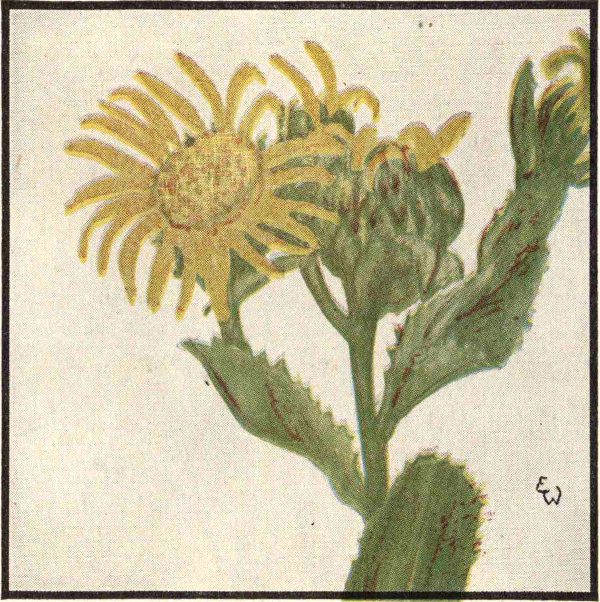
BIG GUMWEED
Big Gumweed. Saw-Leaf Daisy (Prionopsis ciliata) is easily recognized by its straight, stiff stalks which are closely covered with broad oval leaves. Dense masses of the sentinel-like plants may be seen along fence-rows in North-central and West Texas in August and September. It ranges north to Kansas and Missouri. The stems are topped by short clusters of large heads, 2-3 inches broad. The leaves are thick, gummy, and closely beset with bristle-tipped teeth. Sometimes an injury to the stem may cause it to become widely branched.
The scientific name means “resembling a saw” and refers to the leaf-margins. It is not a true gumweed but has similar bur-like heads. It differs from the gumweeds in having several unequal hair-like bristles on the seed, whereas the seeds of gumweeds have 2-8 stiff bristles.
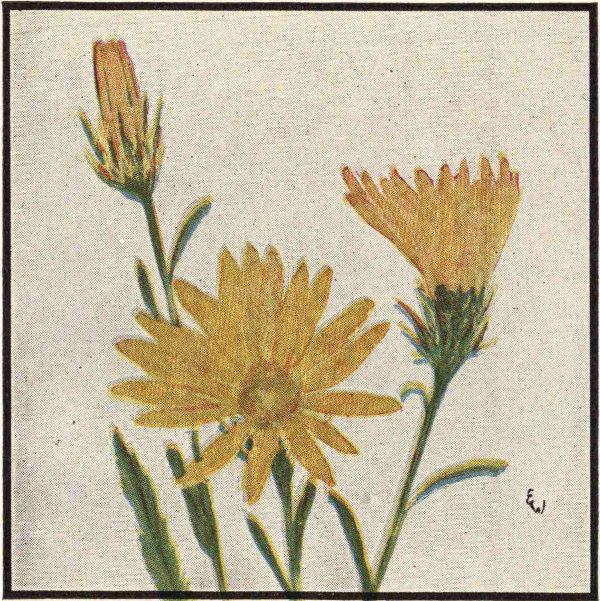
YELLOW SLEEPY DAISY
Yellow Sleepy Daisy (Xanthisma texanum) is a yellow daisy with lazy habits, for the heads do not open until noon. It is close kin to the white lazy daisy (Aphanostephus skirrobasis), and the two may often be found growing in the same fields. The large heads of lemon-yellow flowers are quite showy and attractive, 1½ inches broad, solitary at the ends of the branches. The ray flowers are narrow, about one inch long, and conspicuously lance-shaped at the tips.
This plant blooms in the late spring and summer and is found on sandy prairies or open woods in Central Texas. It is an annual, the stem branched above, commonly about 1-1½ feet high. The leaves are glossy green, somewhat narrow, and one to two inches long. It has been introduced into cultivation in the North and East. The name is Greek, meaning “dyed yellow.”
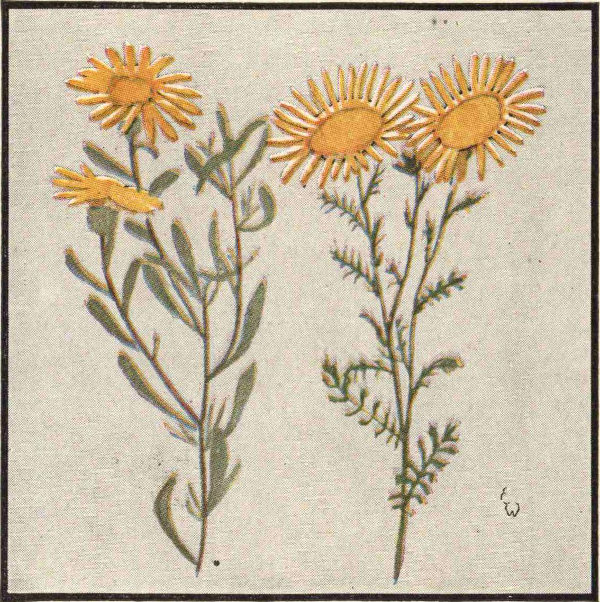
BERLANDIER’S GOLDEN ASTER IRON FLOWER
Berlandier’s Golden Aster (Chrysopsis berlandieri) is common on roadside banks and prairies of Central and West Texas. Growing from a perennial root, the branched stems sprawl in clumps about a foot broad and are thick with yellow heads soon after a heavy rain. The heads are nearly an inch broad, the flowers all yellow. The leaves are whitish and somewhat woolly. It blooms in the summer and fall.
Spiny-Leaved Yellow Aster. Iron Flower (Sideranthus spinulosus) has yellow heads much like the preceding, but the leaves are quite different, being divided into narrow segments which are bristle-pointed rather than spiny as the name indicates. “Sideranthus” means “iron flower.” It is very abundant on prairies and hills in the western part of the state and ranges to Canada and Mexico. It blooms from March to October. The iron flowers are often called gold daisies. The southern iron flower (Sideranthus australis) is common in Southwest Texas.
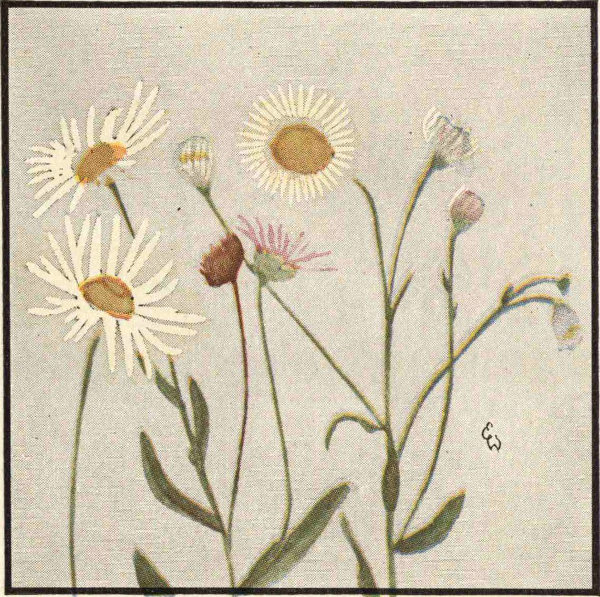
WHITE LAZY DAISY OAK-LEAVED FLEABANE DAISY
White Lazy Daisy (Aphanostephus skirrobasis) grows very abundantly in sandy soil in spring and summer. It ranges from Kansas to Mexico and Florida. The morning traveller does not appreciate its beauty, for it is truly a lazy daisy, not opening its heads until nearly noon. The plants are usually branched and grow 6-18 inches high. The large, showy heads are 1-2 inches across and are usually long-stalked. Unlike those of many other daisies, the seeds are not topped by slender bristles but have an inconspicuous crown, as is denoted by the scientific name, which is Greek for “faint crown.”
Oak-Leaved Fleabane Daisy (Erigeron quercifolius) is very abundant in the spring in the East Texas woods and ranges through the Southern States. The lower leaves resemble oak leaves, but those on the stem are narrow and pointed. The numerous fleabane daisies in the state may be readily recognized by means of the many, very narrow ray flowers which are usually white, pale pink, or pale lavender. Kiss-me-and-I’ll-tell-you (Erigeron annuus) is a taller daisy and is very abundant in East Texas.
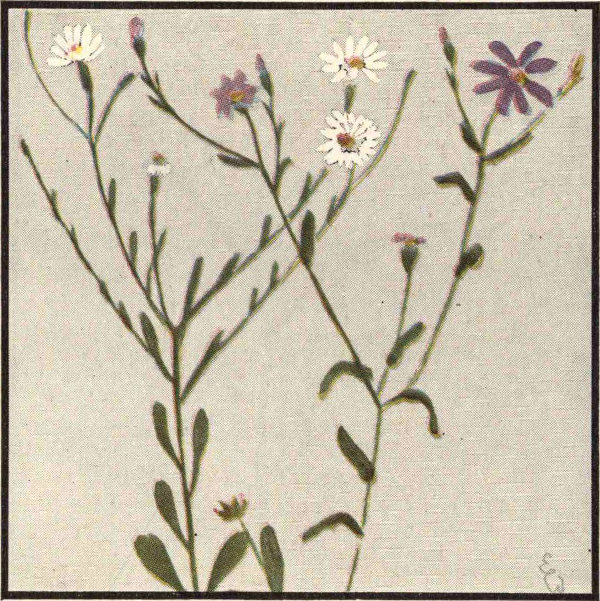
DWARF WHITE ASTER DWARF BLUE ASTER
Dwarf Blue Aster (Keerlia bellidiflora) is a shade-loving, sprawling plant growing in moist soil in Central Texas. Its small heads, less than half an inch across, have the aster habit of closing at night and opening in bright light. The outer ray flowers are bluish-lavender, and the tubular inner flowers are yellow. It blooms from late March to May.
Dwarf White Aster (Chaetopappa asteroides) is a very small and wiry plant, growing two to ten inches high and becoming much branched with age. The small narrow heads with white rays and yellow disk flowers are less than half an inch broad. The leaves are narrow, commonly broader about the middle, and about half an inch long. The scientific name refers to the bristles on the seed. It is very abundant in sandy soil throughout the state and ranges to Missouri and Mexico. It blooms from March until early summer.
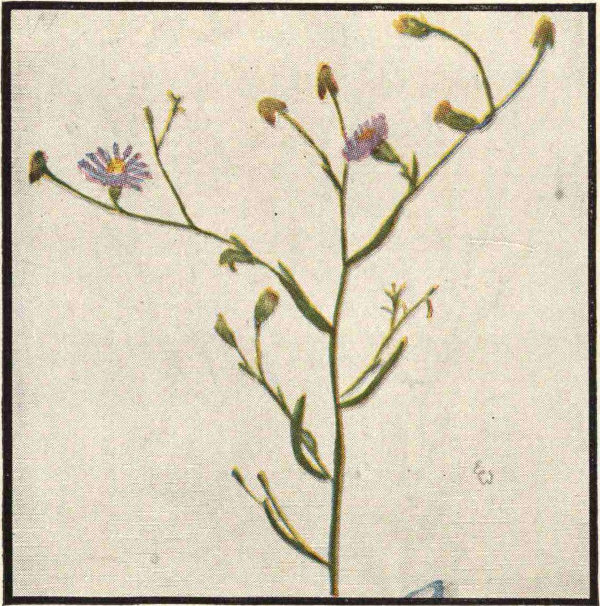
ROADSIDE ASTER. BLACKWEED
Blackweed. Roadside Aster (Aster exilis) is probably the least showy of the asters but is very abundant in Texas. It ranges from Kansas to Texas and Florida. The white, daisy-like heads may be noted against the dark-green foliage in roadside ditches, or it may appear as a violet haze along the highway. Although it is considered one of the common lawn pests in the fall, yet even there it is a thing of beauty; for when the slender stems are cut, numerous branches spread out from the base, and soon the grass is studded with the tiny white or lavender heads. Keepers of bees on the coastal prairie highly prize it as the source of their most palatable honey.
Spiny Aster (Aster spinosus) is quite similar to the roadside aster and has inconspicuous leaves which are sometimes reduced to spines. The flower heads are less than an inch broad with white outer flowers. It forms dense growths in river bottoms and along irrigation ditches and is especially abundant in the vicinity of El Paso.
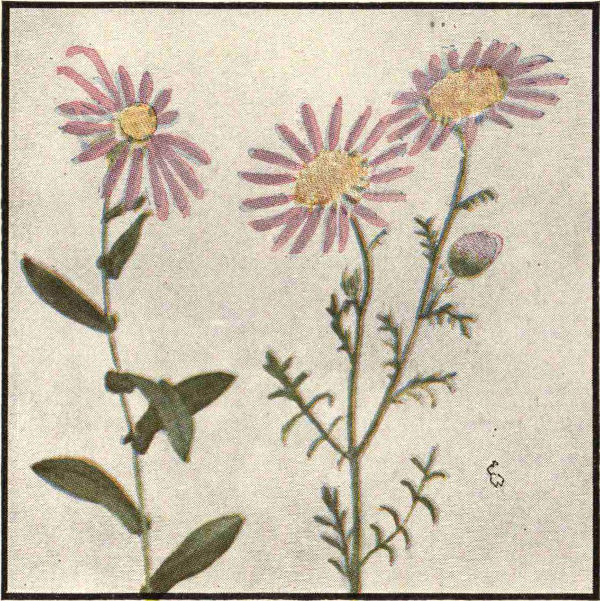
LATE PURPLE ASTER TANSY ASTER
Late Purple Aster (Aster patens) shows its lovely heads in October and November along the edges of post oak woods throughout the state. It is easily recognized by the short, broad, and roughened leaves on the wand-like stems. The illustration given is that of variety gracilis which is abundant in the vicinity of Fort Worth. Many asters are found in the state, but very few make a conspicuous floral display except along the coastal plain and river bottoms.
Tansy Aster. Dagger-Flower (Machaeranthera tanacetifolia) has leaves much like those of the spiny-leaved yellow aster, but the purple-flowered heads are much larger and very showy, 1-2 inches broad. The heads are surrounded by bracts with green spreading tips. The inner tubular flowers are yellow but soon turn reddish-brown. It ranges from Nebraska to Mexico and California. This is one of the loveliest flowers on the western plains, blooming from May to October.
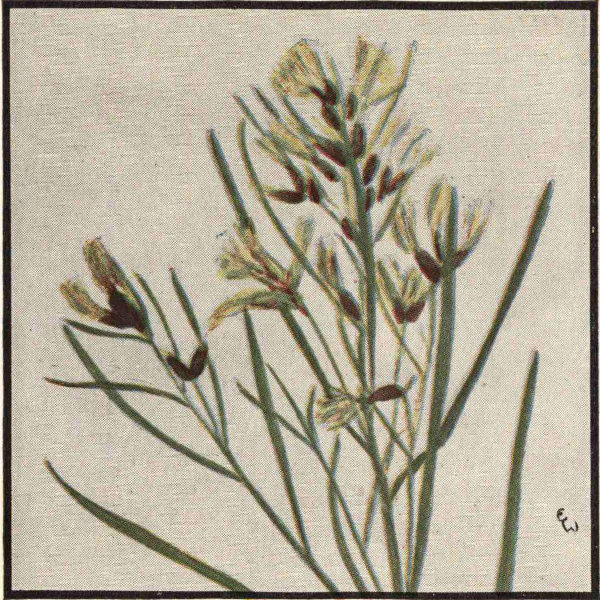
OIL WILLOW
Narrow-Leaved Baccharis. Oil Willow (Baccharis angustifolia) looks very much like the black willow, to which, however, it bears no relationship. The leaves of baccharis have a resinous texture, and the flowers appear in the late summer and fall. The pollen-bearing flowers are not borne on the same shrub with the seed-bearing flowers. The flowers, all small, inconspicuous, whitish, and tubular, are borne in a narrow head of ovate bracts which soon turn brown.
It is called the oil willow by some of the older residents because it is said to be an indicator of oil, just as the black willow is said to be a good indicator of water. It is also called brittle willow, false willow, and resin willow. It grows in brackish marshes throughout the state and may be found eastward to North Carolina. The soft white plumy bristles on the seed give the shrub the feathery appearance of the Yankee-weed. Along the coast in the southeastern part, the groundsel-tree or pencil-tree (Baccharis halimifolia) is a lovely sight in the fall.
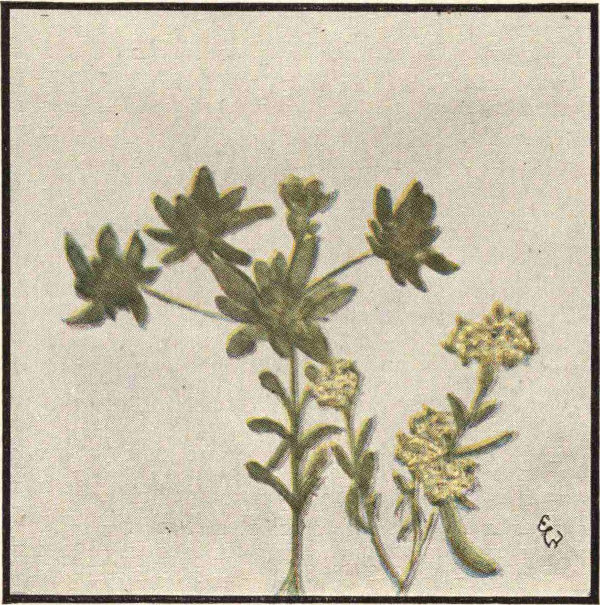
LARGE RABBIT TOBACCO SMALL RABBIT TOBACCO
Large Rabbit Tobacco (Filago prolifera) is a low plant less than six inches high with a few short branches at the top of the stem and sometimes a few at the base. The flowers are small and inconspicuous, being borne in woolly, rather flattened heads which are about half an inch broad. It blooms from January to June and ranges from Texas to South Dakota.
Small Rabbit Tobacco (Filago nivea) is a smaller plant but is more densely clothed with woolly hairs. The minute, ball-like heads are clustered together. Both of these plants are also known as poverty-weed, chewing gum, and ladies’ tobacco. Poverty-weed is a suitable name for them in the sheep-grazing section of Central Texas which has been heavily over-grazed. In many pastures they take the place of grasses as a ground cover. The leaves may be chewed for gum. The rabbit tobacco is closely related to the cudweeds and everlastings. The plantain-leaved everlasting grows in moist woods in East Texas.
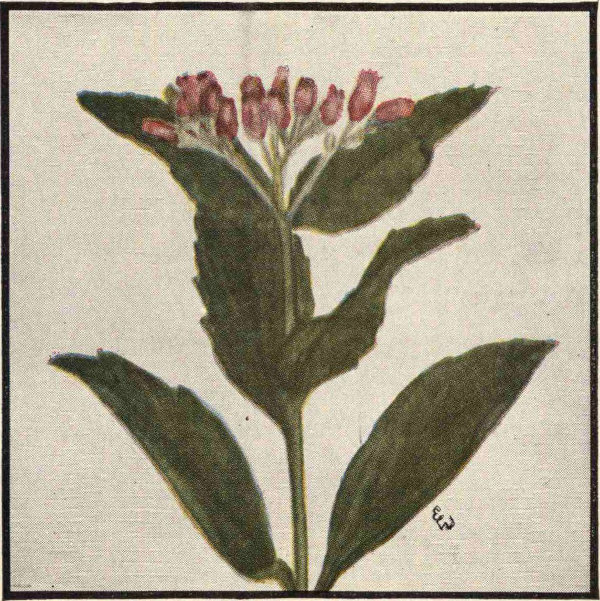
SOUTHERN MARSH FLEABANE
Southern Marsh Fleabane (Pluchea purpurascens) grows only in marshes or in continually moist places. The flowers are more rose-colored than purplish, as the name would indicate, and the tawny bristles on the seeds soon give a brownish tint to the heads. It often grows in pleasing combination with the blue mist-flower. It ranges from Texas to Florida and tropical America and blooms in the summer and fall.
The plants are commonly about two feet high, the stems being unbranched below and very leafy. The broad leaves are pointed at the tip and narrowed into stalk-like bases except on the upper part of the stem. The leaf-margins are irregularly toothed. The fragrant flowers are borne in small oblong heads in a flat-topped cluster.
The cudweeds are closely related to the marsh fleabane. They are particularly abundant in the mountains of West Texas, the loveliest one being Wright’s cudweed or everlasting (Gnaphalium wrightii), which has white flowers and foliage.
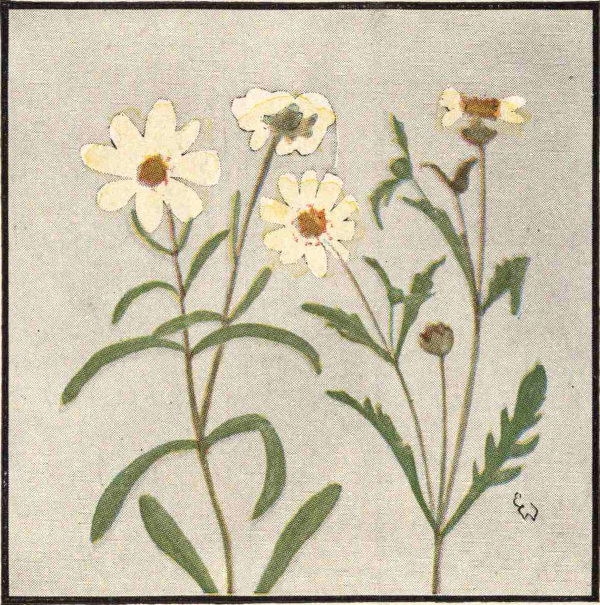
ROCK DAISY BLACKFOOT DAISY
Prairie Blackfoot Daisy. Mountain Daisy. Rock Daisy (Melampodium cinereum) is very abundant on limestone slopes and in dry soil from Texas to Arkansas, Kansas, and Arizona. The scientific name is from the Greek words meaning “black foot” and refers to the blackened roots and stalks.
Blackfoot Daisy (Melampodium ramosissimum) grows from a black woody base and has many branched stems which form a dense rounded mound one to two feet broad. After sufficient rainfall from early spring until winter, this mound is covered by the saucy heads of white daisy-like flowers. The heads are about three-fourths inch across and have an outer row of 8-11 broad white ray-flowers. This is the most vigorous one of the blackfoot daisies and makes an excellent plant for the rock garden. It grows in Southwest Texas. The seeds are enclosed in a thickened cornucopia-like floral bract which has a flaring rim and many warty projections.
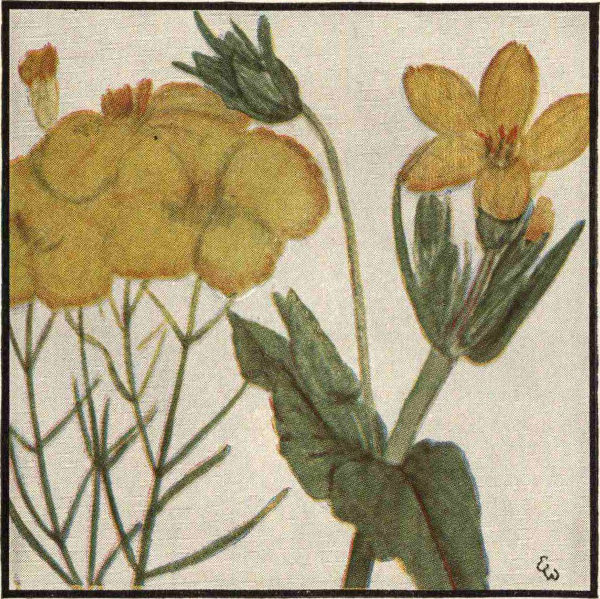
PRAIRIE ZINNIA TEXAS STAR DAISY
Texas Star Daisy. Lindheimer’s Daisy (Lindheimera texana) shows its star-like flower heads early in the spring while the plants are low and the leaves are closely clustered. By June the plants are tall and widely branched above. This plant honors by its name Ferdinand J. Lindheimer, an early settler of New Braunfels and editor of the “Neu Braunfelser Zeitung.” Lindheimer began his collection of Texas plants in 1836 and continued until his death in 1879. With the assistance of Dr. George Engelmann of St. Louis and Dr. Asa Gray of Harvard University, Lindheimer’s collections between 1842 and 1852, representing more than 1400 species of plants, were classified and distributed to the leading herbaria of Europe and America. A part of this collection is owned by the University of Texas Herbarium.
Prairie Zinnia (Zinnia grandiflora) grows in low, rounded clumps from Kansas to Mexico and Arizona and blooms from June to September. The bright yellow ray flowers are nearly round and remain on the seeds. With age they become papery, and the yellow disk flowers turn reddish-brown. The common zinnia in cultivation was introduced from Mexico.
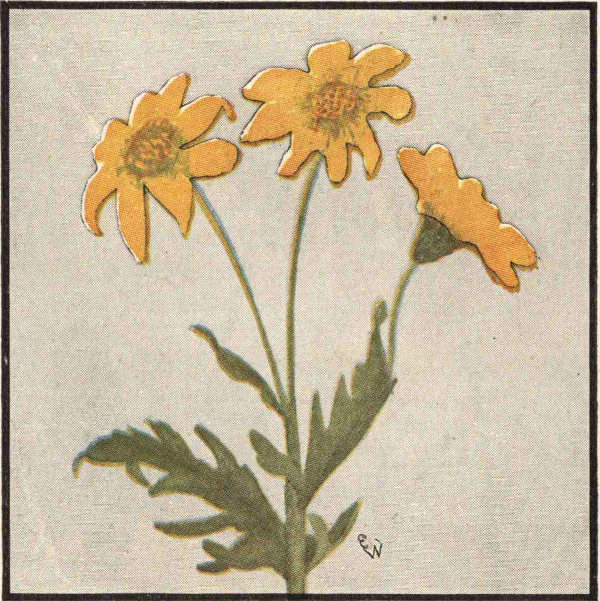
CUT-LEAVED DAISY. ENGELMANN’S DAISY
Cut-Leaved Daisy. Engelmann’s Daisy (Engelmannia pinnatifida) is closely related to the sunflowers but has the daisy habit of closing the flower heads at night and opening them in bright sunlight. It is one of the commonest plants on prairies from Kansas to Louisiana and Arizona and grows in dense patches along roadsides and pastures from April to July.
The rough, hairy plants grow one to three feet high and are topped by broad clusters of long-stalked, showy yellow heads which are 1½-2 inches broad. The divided leaves are short-stalked on the lower part of the stem and on the upper part have clasping basal lobes.
This daisy honors the name of Dr. George Engelmann, an eminent botanist of St. Louis, who died in 1884.
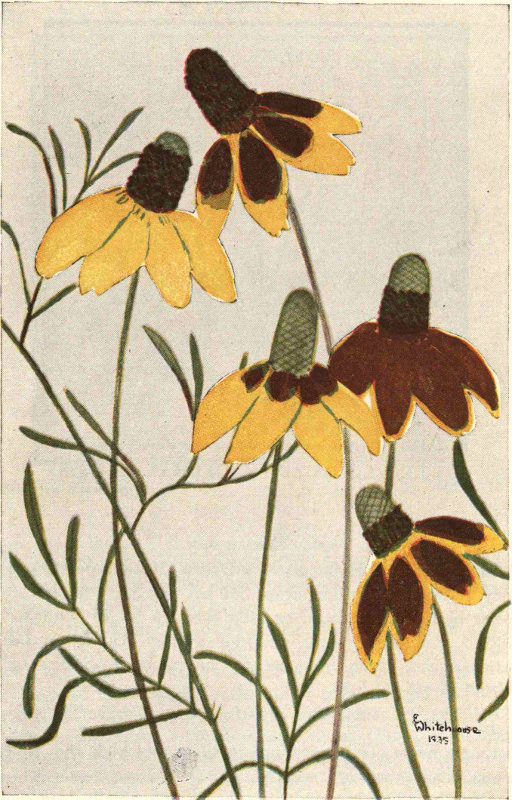
NIGGERHEAD
Niggerhead. Thimble Flower (Ratibida columnaris) is also called Mexican hat, niggertoe, “gallitos,” long-headed or prairie cone-flower, and black-eyed Susan, though the last term is erroneously used. It is a very handsome plant, which is widely distributed on plains from Southern Canada to Arizona, Texas, and Tennessee. In South Texas it is at its best in April and May; in North Texas it is lovely in late May and June.
Numerous erect stems grow from a woody perennial root and are commonly two to two and a half feet high. The long-stalked heads terminate the branches. The leaves are finely divided into long narrow segments, both leaves and stem being somewhat rough.
The showy flowers have drooping, velvety rays which are entirely yellow or reddish-brown or partly colored yellow and brown. The small tubular flowers are brown and are borne on a thimble-shaped or columnar disk which varies greatly in size on different flowers, sometimes being nearly two inches long, but it is usually about an inch long. The disk is gray-green before the flowers open.
The dwarf niggerhead (Ratibida tagetes) is quite similar to the large niggerhead in growth habit and coloring, but it is a smaller plant and has smaller flowers. It is found from Kansas to Mexico on dry plains and blooms a month later than the large niggerhead.
The niggerhead belongs to a small group of showy American plants. It was introduced into European gardens many years ago, whence it later made its way back to American gardens. The niggerhead group is closely related to the black-eyed Susan and other cone-flowers. Several giant yellow-flowered cone-flowers grow in East Texas.
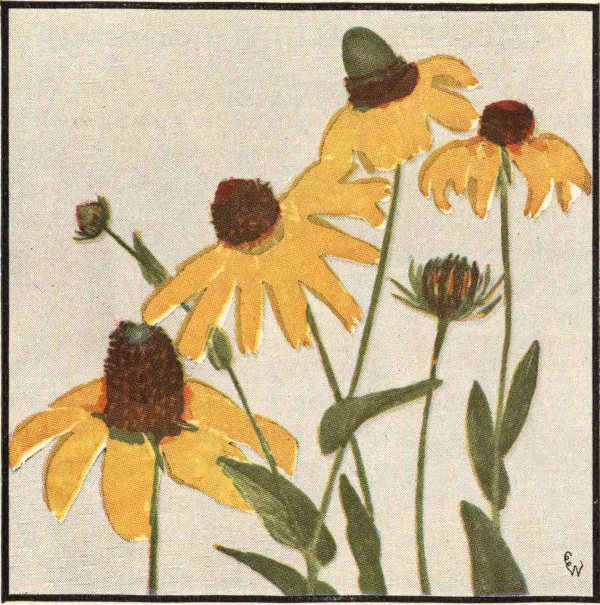
CLASPING-LEAVED CONE-FLOWER BLACK-EYED SUSAN
Clasping-Leaved Cone-Flower (Dracopis amplexicaulis) makes a showy display in roadside ditches from Central Texas to Louisiana and Missouri. It is a handsome plant with smooth branched stems one to two feet high. The slightly drooping rays commonly have brown spots at the base but may be all yellow. It is often called niggerhead or black-eyed Susan, but it may be distinguished from the latter by the thimble-shaped heads, which are green before the brownish disk flowers open. In South Texas it is at its best the latter part of April, but in North Texas June is its best month.
Black-Eyed Susan (Rudbeckia hirta) is a common daisy of the plains region from Southern Canada to Texas and Florida. It is a rough, hairy plant which grows from one to three feet high. Closely resembling it is Rudbeckia bicolor, which has shorter ray flowers marked with a reddish-brown base. The ray flowers of Rudbeckia hirta may also show a dark base. Both are widely cultivated. The group was named in honor of Claus Rudbeck, a Swedish botanist.
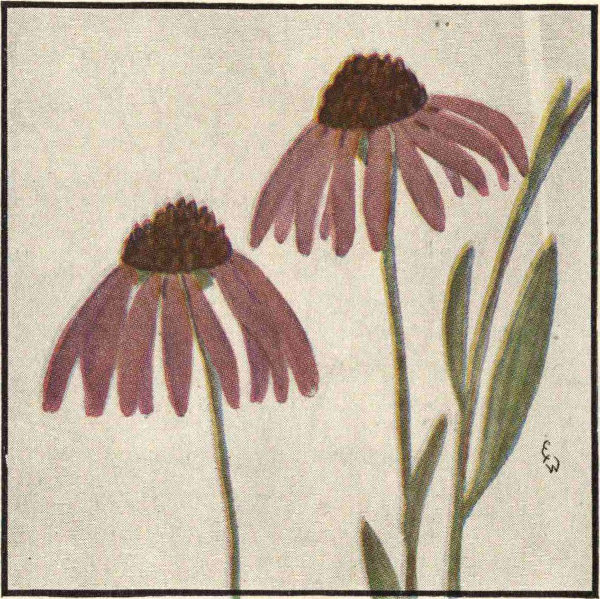
SAMPSON’S ROOT. PURPLE CONE-FLOWER
Sampson’s Root. Narrow-Leaved Purple Cone-Flower (Echinachea angustifolia) is easily recognized by the spreading or somewhat drooping rose-colored rays. The heads terminate the stiff, unbranched stems which, like the narrow leaves, are very rough and bristly. The stems grow one to two feet high and are scattered on limestone hillsides but may occasionally be found in dense patches along the roadsides. The leaves have three prominent nerves.
The scientific name is derived from the Greek and refers to the stiff reddish-brown chaff on the flower head. This chaff obscures the brown disk flowers and remains on the heads long after the seeds have fallen. This plant is hard to distinguish from the pale purple cone-flower (Echinachea pallida), which grows in the woods in the eastern part of the state. The latter has longer and more drooping ray flowers. The purple cone-flowers are well known in cultivation.
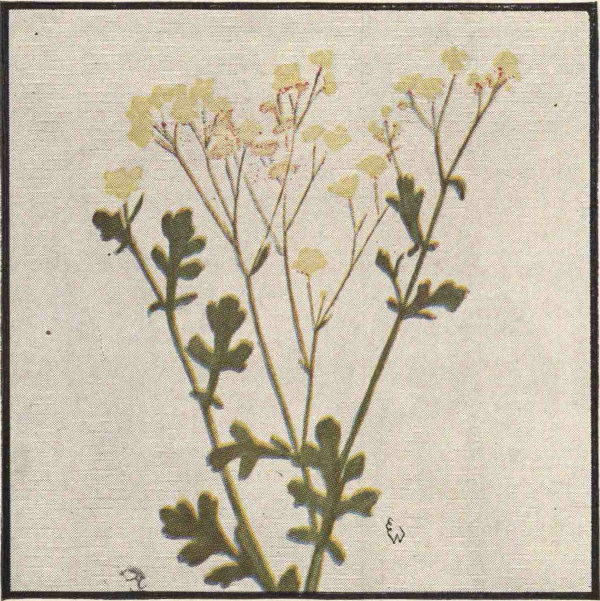
RAGWEED. LYRE-LEAVED PARTHENIUM
Ragweed. Lyre-Leaved Parthenium (Parthenium lyratum) blooms from early spring until fall in Southwest Texas. This is a smaller plant than the common parthenium (Parthenium hysterophorus), which is widespread in the Gulf States and tropical America. The latter is a widely branched plant two to three feet high and grows in dense masses. They have similar flower clusters with small heads of greenish-white flowers. Neither of these is the ragweed or bloodweed commonly associated with hay fever; however, the common parthenium is listed as a poisonous plant. Wild quinine or feverfew (Parthenium integrifolium), used as a pioneer drug to relieve fever, has been reported from the state.
Several shrubby partheniums are found in West Texas. The most important member of the group is the silver-leaved guayule or rubber plant (Parthenium argentatum), found in West Texas and Mexico. It is a commercial source of rubber but is not yet profitable, as the plants are of slow growth.
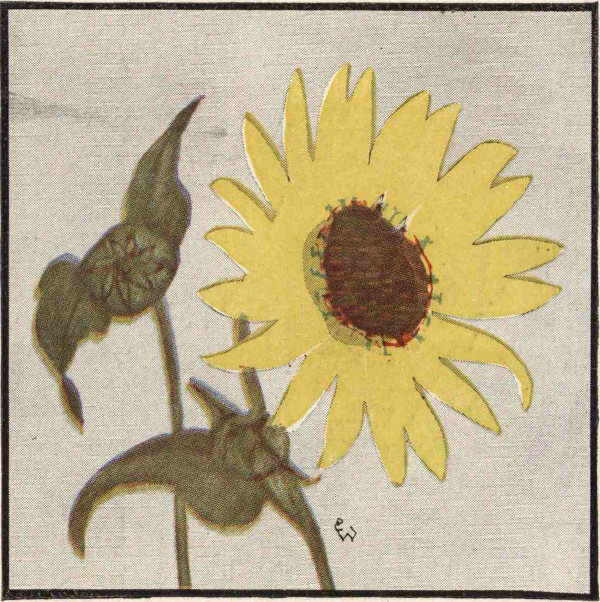
COMMON SUNFLOWER
Common Sunflower (Helianthus annuus) has been known in cultivation for many years but is considered native from Minnesota to Texas and Mexico. It is the state flower of Kansas. The stout, erect stems are widely branched above the base and are very sticky, 2-10 feet high. The flower heads, 3-6 inches broad, have many yellow ray flowers about an inch long and numerous tubular disk flowers. It is grown commercially for its fiber and seeds. The seeds make an excellent food for poultry and furnish an oil used in making soap, candles, and salad dressing.
Two other sunflowers are widely distributed in the state. The orange sunflower (Helianthus cucumerifolius) grows in the sandy post oak belt, and the blue-weed (Helianthus ciliaris) is very abundant in West Texas. The latter is a low, branching perennial which is poisonous to sheep.
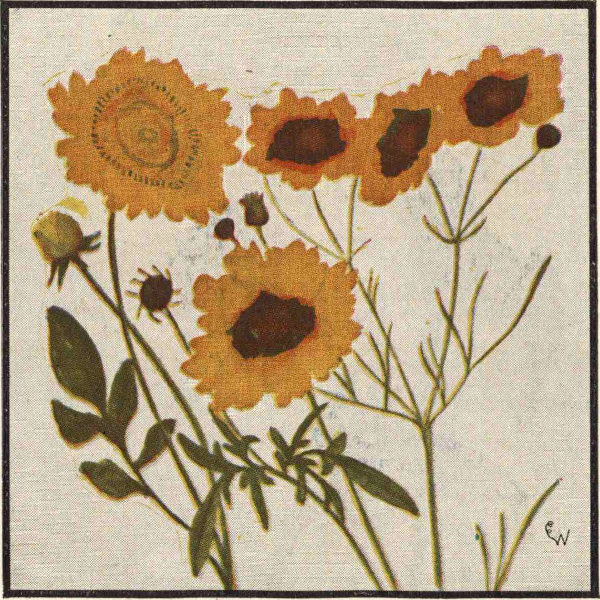
TEXAS COREOPSIS GOLDEN WAVE CALLIOPSIS
Texas Coreopsis (Coreopsis nuecensis) was first described from plants found on the lower part of the Nueces River. It is quite widespread on the southern coastal prairie from March to May. It may be distinguished from other annual species of coreopsis by the circle of reddish-brown marks near the base of the yellow rays. The leaves are mostly basal and long-stalked.
Golden Wave. Drummond’s Coreopsis (Coreopsis drummondii) has showy, long-stalked heads, about 2 in. broad. They are borne on widely branched plants about a foot high. The leaves are divided into broad segments, and both leaves and stems have scattered soft hairs. It is very abundant on sandy coastal prairies in April and May and is well known in cultivation.
Calliopsis. Prairie Coreopsis (Coreopsis cardaminefolia) is a late-blooming annual plant, the flowers appearing in North Texas about the middle of June. It ranges from Kansas to Mexico and Louisiana. This plant greatly resembles the golden coreopsis (Coreopsis tinctoria), which is abundant on the coastal prairies in March and April. “Coreopsis” is derived from the Greek, meaning “bug-like,” and refers to the seed. The plants are often called tickseeds.
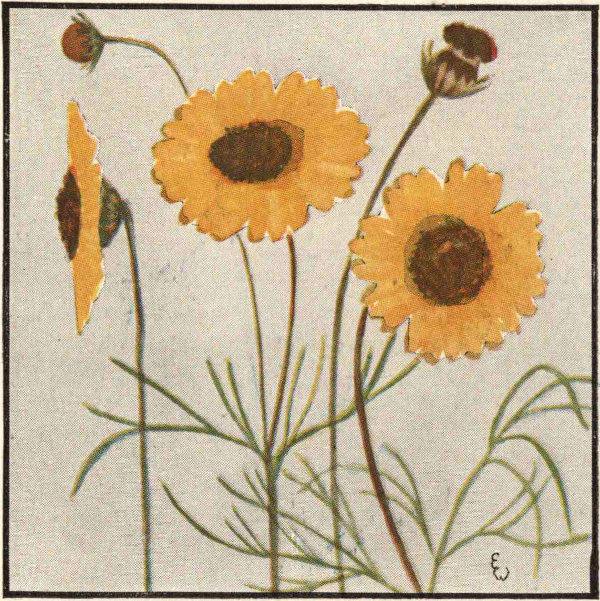
FALSE COREOPSIS
False Coreopsis. Fine-Leaved Thelesperma (Thelesperma trifidum) is sometimes erroneously called black-eyed Susan. It closely resembles the coreopsis when the flowers are in the bud stage. The flowers may readily be distinguished from those of the coreopsis because the ray flowers are not marked with a brown spot at the base and are divided into three equal lobes at the tip. The ray flowers of the coreopsis are commonly divided into four lobes, the two lateral being shorter than the two middle lobes. The leaves are finely divided into long, narrow segments.
This is one of the most widely distributed plants on the prairies from Mexico to Colorado, South Dakota, and Missouri. The yellow of Central Texas landscapes in late April and May is due to thelesperma. Scattered plants continue to bloom through the summer and fall. The plants grow 1-2 feet high and become widely branched. The disk flowers are a reddish-brown.
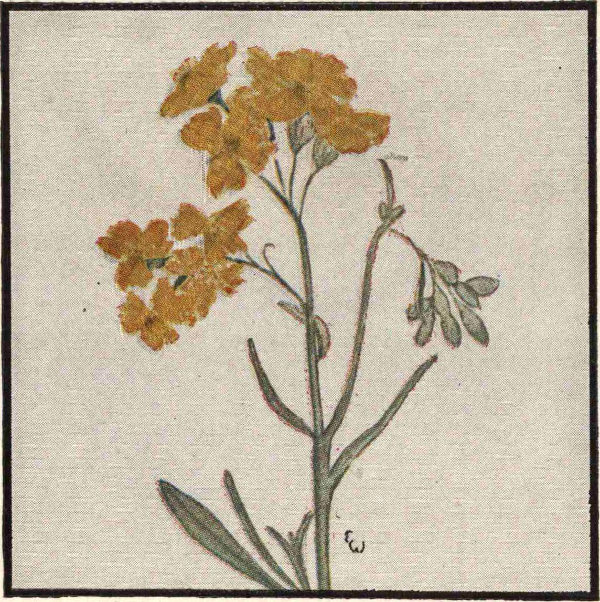
PLAINS PAPER-FLOWER
Plains Paper-Flower (Psilostrophe villosa) is another western plant which has foliage covered with a dense white woolly coat of hairs. This hairy coat is a plant device for enabling it to withstand dry growth conditions. There are only three or four ray flowers which are much broader than long and are conspicuously three-lobed. The heads are densely clustered on short branches at the top of the stems, which are from six inches to two feet high.
Near El Paso is found the lovely western paper-flower or Cooper’s psilostrophe (Psilostrophe cooperi). It grows in spreading clumps about two feet broad and bears long-stalked heads over an inch wide. As the flowers are bright yellow and remain lovely for months, they are often gathered for winter bouquets. Eventually they become white and papery. Psilostrophe tagetinae has somewhat larger flowers than the plains paper-flower and is probably the most abundant paper-flower in the state. When cattle graze upon it for several weeks, they suffer a slow poisoning. The marigold is a close relative, both the African and French marigolds being derived from Mexican plants introduced into cultivation about 1573.
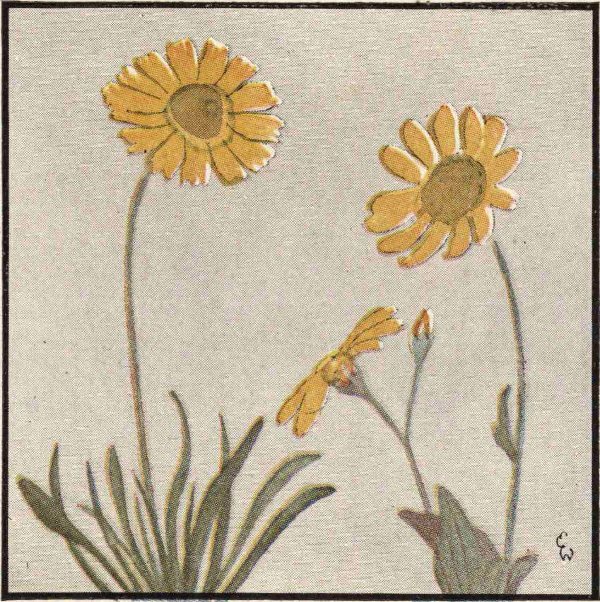
FOUR-NERVED DAISY SILVER-LEAF DAISY
Actinella Daisy. Four-Nerved Daisy (Tetraneuris linearis) grows with small tufts of narrow leaves from a woody perennial root. The heads, which are borne on stalks 2-8 inches long, close at night. The plants often bloom throughout the year in Central and South Texas. They grow on rocky limestone hillsides in Texas and New Mexico. The broad, four-nerved ray flowers form a close border around the conic disk, which is covered with small yellow tubular flowers. The veins of the outer flowers, which give rise to the scientific name, are sometimes purplish.
Silver-Leaf Daisy (Bahia dealbata) is common in the western part of the state into Arizona and Mexico. It grows 1-2 feet high from a woody perennial root and often blooms throughout the year. The long-stalked heads are a little over an inch broad with 9-12 yellow ray flowers. On the silvery-gray stem the few leaves are commonly opposite, broad and short-stalked, with a pair of lateral lobes near the base.
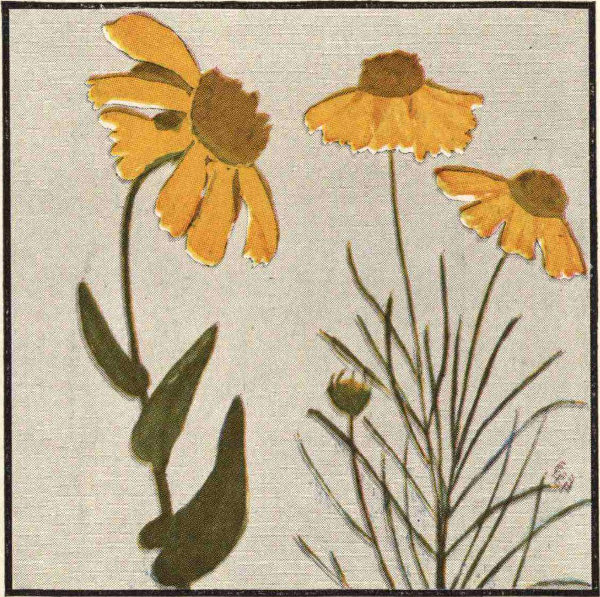
HUISACHE DAISY BITTERWEED
Huisache Daisy (Amblyolepis setigera) is so called because it often forms a carpet of gold under huisache (pronounced wee satch), mesquite, or other chaparral bushes in Southwest-central Texas from March to June. It is also called honey or butterfly daisy and clasping-leaved bitterweed. It has the strong scent common to the bitterweed, but is fragrant in drying. The plants are often loosely branched, growing 6-12 inches high, and the yellow heads are about 1½ inches broad.
Sneezeweed. Fine-Leaved Bitterweed (Helenium tenuifolium) is often found in pastures which have been over-grazed. It has a strong-scented foliage which gives milk a bitter flavor. The ball-shaped mound of disk-flowers (reminding one of camomile) and the few drooping ray flowers, which have a broad 3-toothed edge and a narrow base, are characteristic of the group. The seeds are small and are said to cause sneezing when they are thrown into the air. The bitterweed blooms from May to October and ranges from Texas to Virginia.
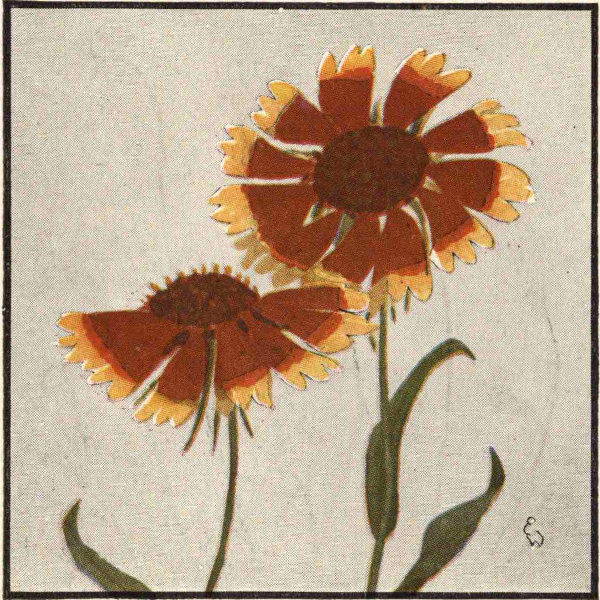
INDIAN BLANKET
Indian Blanket. Firewheel. Beautiful Gaillardia (Gaillardia pulchella) is the pride of Texas prairies. The landscape becomes a vivid red and yellow in April, May, and early June when the firewheels are in bloom. It is a highly-prized cultivated plant, and many varieties have been developed. There are several species of gaillardias and many of them are native to Texas. The beautiful one is the most widespread, ranging from Texas to Louisiana, Nebraska, Arizona, and Mexico. The gaillardias are named for a French botanist, Gaillard.
The heads are usually two or three inches across and are long-stalked. Each head has 10-20 broad ray flowers which are sometimes all red but usually are marked with a brilliant yellow across the three lobes. The upper leaves are lance-shaped, and the lower are oblong and marked with a few teeth or lobes. It is an annual plant which is widely branched and grows one to one and a half feet high.
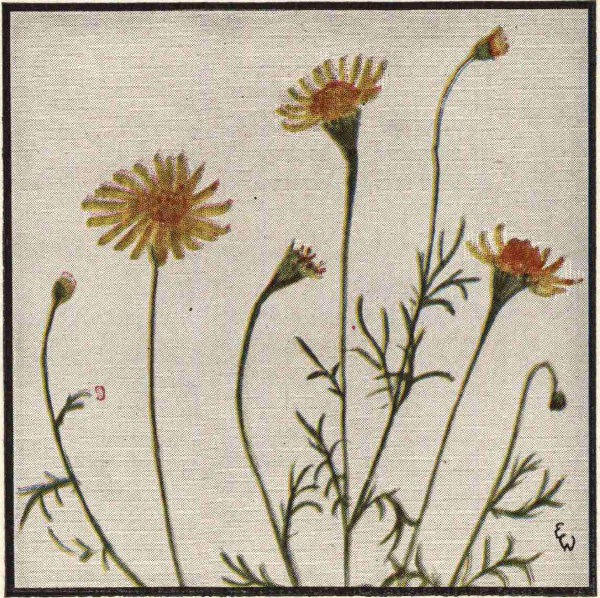
TINY TIM
Tiny Tim. Spreading Thyme-Leaf (Thymophylla polychaeta) is found on sandy prairies from South Texas to Mexico and New Mexico. There are several thyme-leaf species in the state. They may be recognized by their scented foliage and the cup-like base of the flower heads, the bracts of the head being marked with large yellow or orange glands. There is something appealing about the tiny Tim, as the name would indicate. The branching stems with their lacy green leaves form rosettes which are dotted with the yellow daisy-like flowers.
Dwarf Thyme-Leaf. Tiny Tim (Thymophylla pentachaeta) clings to cliffs and rocky hillsides. It is a perennial plant with short stems four to six inches high. The leaves are short and needle-like and are borne in dense clusters around the stem. The flower heads are about half an inch broad. Tiny Tim ranges from Texas to Arizona and Mexico.
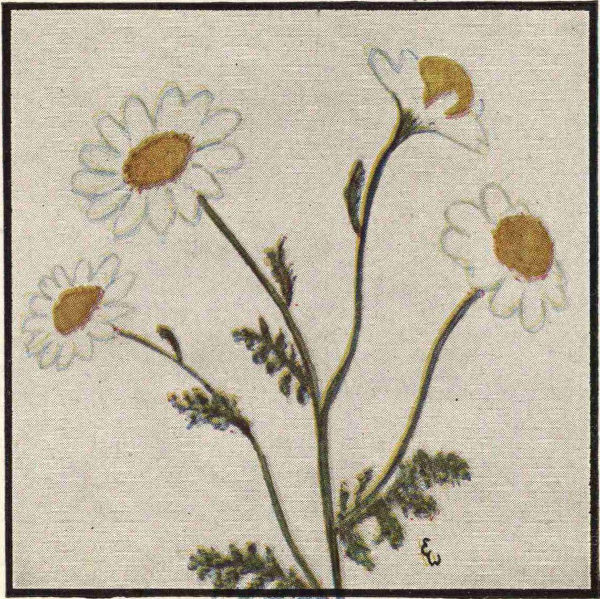
DOG’S CAMOMILE
Dog Fennel. Mayweed. Dog’s Camomile (Anthemis cotulla) is a strong-scented herb widely scattered in America, naturalized from Europe. It is very abundant in sandy soil in the eastern part of the state. The plants are widely branched and bear numerous heads about an inch broad. The rays are broad and wide and the disk flowers are yellow. It begins to bloom in Texas in March, but the plants are at their best in May and June. It is close kin to the European camomile, which is used medicinally, a soothing tea being made from the dried ball-shaped heads of yellow flowers.
Closely related to camomile and yarrow are the artemisias, which include many species known as dusty miller, wormwood, sage-brush, and purple sage. The silvery wormwood or thread-leaved sage-brush (Artemisia filifolius) is very abundant in the sandy areas of West Texas and throughout the Rocky Mountain States and Mexico. It blooms from July to October.
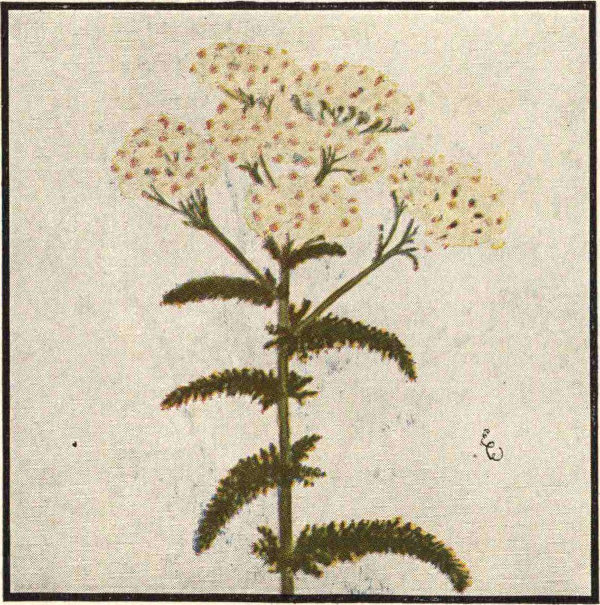
YARROW
Yarrow. Woods Milfoil (Achillea millefolium) was named in honor of Achilles, to whom is attributed the discovery of its healing properties. It is supposed to stop bleeding, relieve spasms, produce sweating, and act as a tonic. The woods milfoil is widely distributed in woods in the United States, Europe, and Asia. It makes a nice garden plant, for the lacy fern-like leaves remain green all winter. The stems grow one to two feet high and are topped by the flat flower-cluster. The ray flowers are white or sometimes pale pink or lavender, and the disk flowers are pale yellow.
Plains Yarrow. Woolly Milfoil (Achillea lanulosa) grows in moist places on the plains from Texas to Canada, Mexico, and California. It is very much like the woods yarrow but differs in that it has fewer gray-green leaves and round-topped flower clusters. Its blooming season is a little later than that of the woods yarrow, which blooms in April and May.
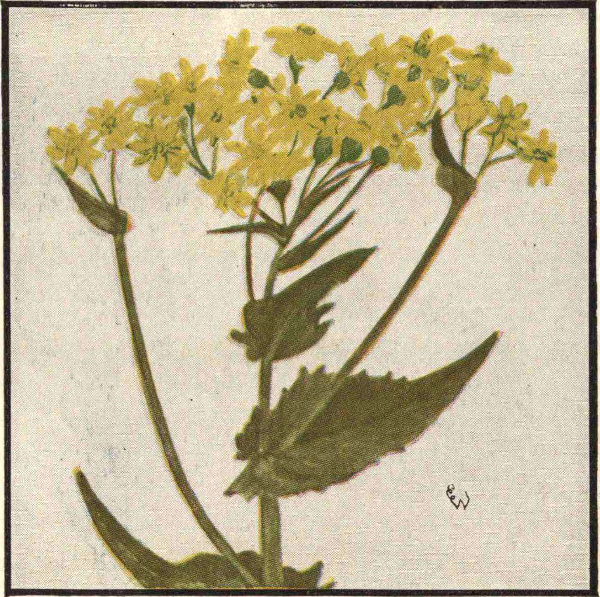
TEXAS SQUAW-WEED
Texas Squaw-Weed. Clasping-Leaved Groundsel (Senecio ampullaceus) is an annual plant which grows so abundantly on the sandy prairies of Texas that it forms a carpet of gold for miles and miles. It is one of the earliest spring flowers to bloom in such showy profusion. The plants commonly grow 1½-2 feet high, being branched above and forming flat-topped flower-clusters which are often a foot broad. When quite young, the plants are densely white-woolly but become smooth and shining with age. The irregularly toothed leaves are 3-6 inches long and have a broad clasping base. The groundsel belongs to one of our largest groups of plants, some 1200 species being widely distributed over the earth.
Fine-leaved or woolly groundsel (Senecio filifolius) has woolly leaves divided into narrow segments. The large heads are often in bloom throughout the year in West Texas and New Mexico.
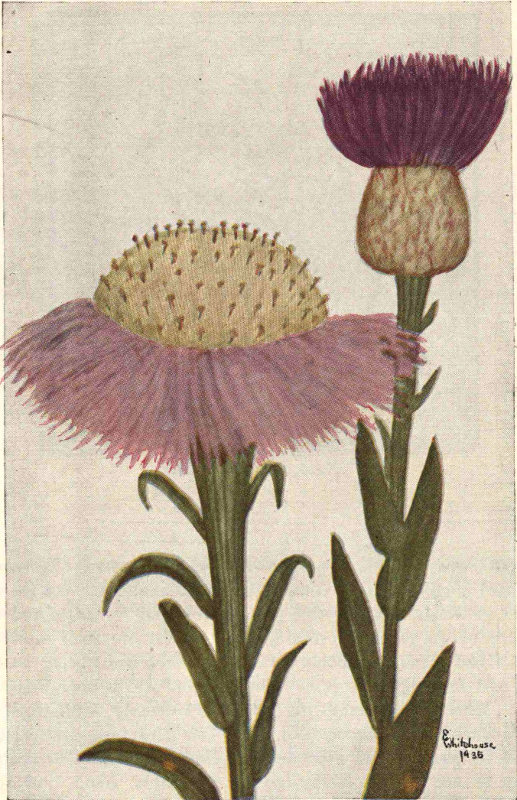
AMERICAN STAR THISTLE
American Star Thistle. Basket Flower (Centaurea americana) is often called spineless thistle because the leaves do not bear spines as do the leaves of its close relative, the purple thistle. It is also known as powder puffs, sweet sultan, and “cardo del valle.” It is a hardy annual which is widely cultivated. Basket flower is the name under which it is known in cultivation—a name which refers to the stiff, straw-colored bracts of the flower head. These bracts are not spiny but are divided at the tip into finger-like projections.
Before the flowers are fully opened, the heads resemble a shaving-brush, and this is a common name frequently applied to this and other thistles. All the flowers are tubular and divided into five long narrow lobes. In one variety the fully-opened flower cluster has an outer border of numerous lavender flowers with cream-colored flowers in the center. There is another variety which has outer flowers a deep rose or reddish purple and center flowers pale pink or rose; sometimes there is little difference in shade between the inner and outer flowers.
The stems are usually branched and grow about two feet high. They are marked with wing-like ridges and are covered with the overlapping, ascending leaves. In Texas the flowers begin to bloom in May and continue into June, being at their best the first week in June. After the flowering season, the foliage becomes yellow and dried, and the old stalks remain conspicuous in the fields for several months. The star thistle is found on plains from Missouri to Louisiana, Mexico, and Arizona. The variety which has reddish-purple flowers is very abundant in the vicinity of Waco and Fort Worth.
The scientific name meaning “of the Centaurs” refers to the use by the Centaurs of certain species for healing. The cornflower or bachelor’s button (Centaurea cyanus) is a well-known garden annual.
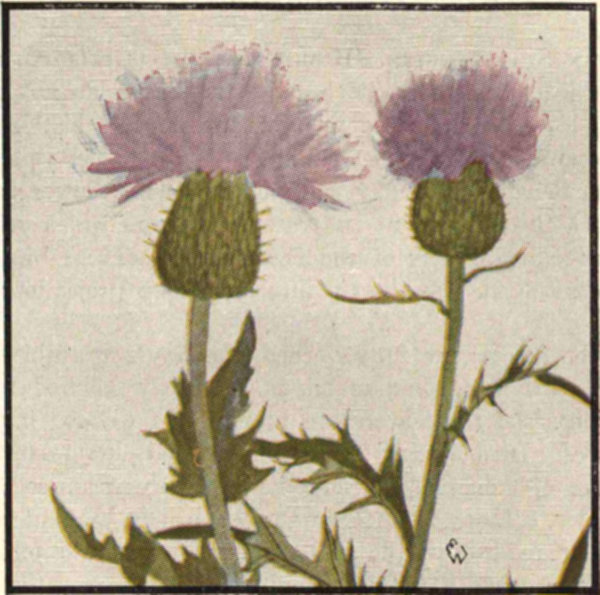
WAVY-LEAVED THISTLE PURPLE-THISTLE
Wavy-Leaved Thistle (Carduus undulatus) is the common prairie thistle and is particularly abundant in the vicinity of Fort Worth. It grows only 1-2 feet high, and the upper leaf-surfaces are yellow-green. The heads are nearly twice as large as those of the purple thistle, and the flowers are a lovely lavender color. It ranges from Southern Canada to Texas and Arizona and blooms in Texas from April to June.
Purple Thistle (Carduus austrinus) is the common thistle in the south-central part of the state. It is a tall, much branched plant, 3-4 feet high, with long-stalked heads of purple flowers. The stems are white-woolly, and the leaves are white-felty beneath and dark-green above, wavy-margined, lobed or divided, the segments being tipped with spines. The heads are about 1½ inches high and broad. The numerous light purple flowers are all tubular with narrow lobes. The thistles belong to a large group, its most renowned representative being the Scotch thistle.
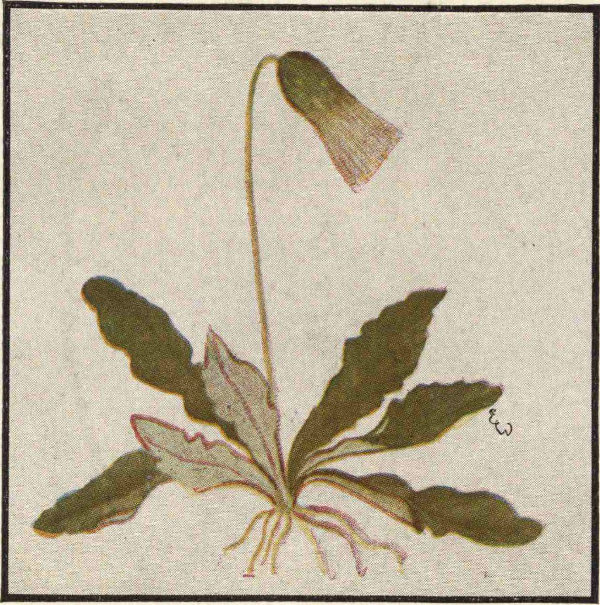
NODDING THISTLE
Nodding Thistle. Silver Puffs. Sunbonnet Babies (Thrysanthema nutans) lacks the spines of the true thistles, but other characters show that this interesting little plant is closely related to the thistle group. The leaves form a basal rosette from which grows the slender, leafless flowering stalk bearing the nodding flower head. The lyre-shaped leaves are wavy-margined, dark-green above and white-felty below, 2-4 inches long. The stalk is sometimes 15 inches long but is commonly about 8 inches high. The creamy-white flowers are rather inconspicuous, but as the seeds mature, the soft white bristles spread into a showy whorl. The plants are found in scattered places in rich soil from Central Texas to Mexico.
Closely kin to the nodding thistle is the desert holly (Perezia nana), which has salmon-pink flowers and holly-like leaves. It is a low plant seeking the shelter of creosote bush, yucca, and other shrubs in West Texas.
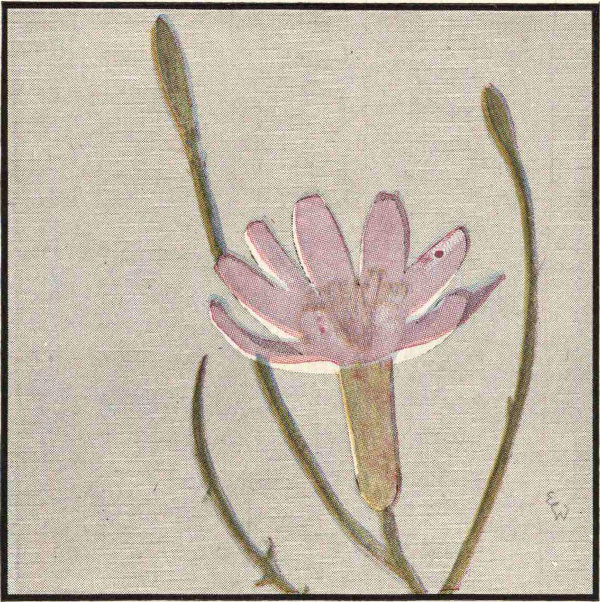
PURPLE DANDELION
Plants with milky juice; all flowers strap-shaped, in dense heads, surrounded by involucral bracts; corolla 5-lobed; stamens 5; ovary inferior.
Purple Dandelion. Flowering Straw (Lygodesmia texana) can nearly always be found in the prairie sections of the state from spring to fall, but the lovely flowers seldom make a showy display along the roadsides. Only one head blooms at a time on the slender forking stems, and that remains open only in the mornings. The heads are made up of 8-12 pale purple strap-shaped corollas, with the lavender styles conspicuously erect in the center. The tip of the corolla is divided into five minute lobes. The stems are almost leafless but have a cluster of short-lobed, narrow gray-green leaves at the base.
Small-Flowered Straw (Ptiloria pauciflora) is a white-flowered chicory with low spreading stems. It is abundant in West Texas and New Mexico.
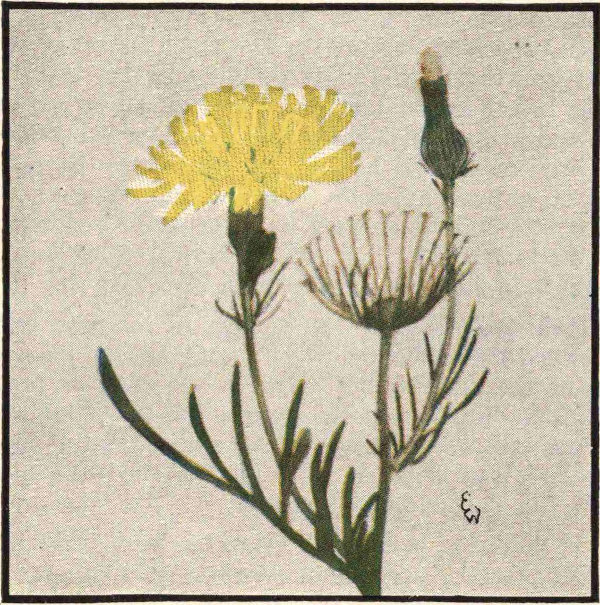
FALSE DANDELION
Many-Stemmed False Dandelion (Sitilias multicaulis) has lemon-yellow flower heads which closely resemble those of the true dandelion, but the plants grow much taller and are often widely branched. From early spring through June, the false dandelion is very abundant on the coastal and western prairies. The heads are made up of several rows of strap-shaped corollas. The fruits are narrow and have attached a spreading tuft of bristles which makes the head in fruit look like a puff ball of lace. This tuft is a parachute device for scattering the seeds far and wide.
White Dandelion (Pinaropappus roseus) has flower heads very much like those of the yellow dandelions, but the flowers vary in color from white to pale pink, and the heads are larger. It is very abundant in March and April in Southwest-Central Texas.
Several garden plants belong to the chicory family, among them being lettuce, salsify, and chicory. The orange hawkweed is often cultivated for ornament.
| AIR PLANTS | ||||||
| WATER PLANTS | ||||||
|---|---|---|---|---|---|---|
| RED | PINK | BLUE | WHITE | YELLOW | PURPLE | |
| SHRUBS OR SMALL TREES | ||||||
| RED | PINK | BLUE | WHITE | YELLOW | PURPLE | |
| EARLY SPRING | ||||||
| RED | PINK | BLUE | WHITE | YELLOW | PURPLE | |
| SPRING | ||||||
| RED | PINK | BLUE | WHITE | YELLOW | PURPLE | GREEN |
| LATE SPRING AND SUMMER | ||||||
| RED | PINK | BLUE | WHITE | YELLOW | PURPLE | |
| SUMMER | ||||||
| RED | PINK | BLUE | WHITE | YELLOW | PURPLE | |
| LATE SUMMER AND EARLY FALL | ||||||
| RED | PINK | BLUE | WHITE | YELLOW | PURPLE | |
| FALL | ||||||
| RED | PINK | BLUE | WHITE | YELLOW | PURPLE | |
The following lists are given to assist the reader in identifying plants. Several special groupings are first given according to conditions and habit of growth. If the plant sought does not qualify for these lists, then the longer seasonal and color lists should be consulted. Several wide-spread plants which the author had to omit because of lack of space have been mentioned in the lists; these may be recognized by the absence of a page reference. Several related species, not mentioned in the text and which may be recognized as close relatives of those illustrated although they may differ in color and season of growth, have been included in the lists.
Opposite each name is given the number of the page on which the plant is described and a symbol which designates the place of growth. The section of the state is not given in the lists, as prairie plants are much the same throughout the state as are the plants in the sandy soil of post oak woods. However, climatic conditions of moisture and temperature limit the range of many plants, and the text should be consulted for the distributional range.
The time of flowering in Central Texas has been taken as the basis for listing the plants according to seasonal distribution. Quite frequently the season in North Texas will be a month later than that of Central Texas, and in South Texas it will be a month earlier. Hence it may be necessary to consult the lists for adjoining seasons if the desired plant is not found in the first list to be checked. Some plants, especially many herbaceous perennials on the western plains, have flowering seasons in both spring and fall; others bloom throughout the warmer months after heavy rains. If a plant cannot be located in the fall list, the spring list should be consulted.
The month of April shows the greatest profusion of flowers in nearly all parts of the state. At some of the wild flower exhibits held at the University of Texas, nearly 500 species from Central and Southeast Texas have been shown at one time. Therefore the reader is warned not to expect to find every flower he picks up among the 257 illustrations given in these pages.
The plants are listed in the following color groups: red and orange, pink and rose, blue, white, yellow, purple, and green. Under white flowers are grouped those delicately tinted with green, yellow, blue, pink, or lavender. Blue flowers are seldom a true blue but are usually a combination of blue and purple which may be interpreted by some people as blue and by others as purple. Hence if a plant considered as blue-flowered cannot be found in the blue list, then the purple list should be consulted.
The reader may find the following distribution of pages and symbols helpful in identifying plants:
| 2-16 | Mostly lily-like, succulent plants. |
| 17-91 | Petals of flowers usually not united. |
| 92-151 | Petals usually united into tubular, bell-shaped, funnelform, or salverform corollas. |
| 152-193 | Composites: many tubular flowers, often of two types, growing in a head-like cluster. |
| P | Prairies. |
| Pc | Coastal prairies. |
| Ps | Sandy prairies. |
| Pb | Blackland prairies. |
| L | Limestone hills. |
| W | Woods and thickets. |
| Wo | Post oak woods. |
| Wp | Pine woods. |
| M | Water or moist places. |
| C | Chaparral. |
| T | Trans-Pecos or mountainous region. |
(See map p. xvi)
A B C D E F G H I J K L M N O P Q R S T U V W X Y Z